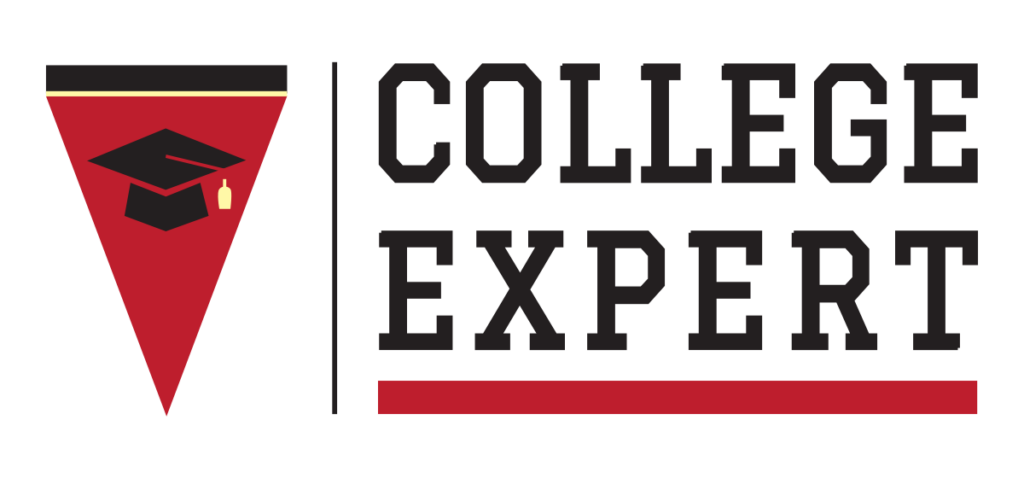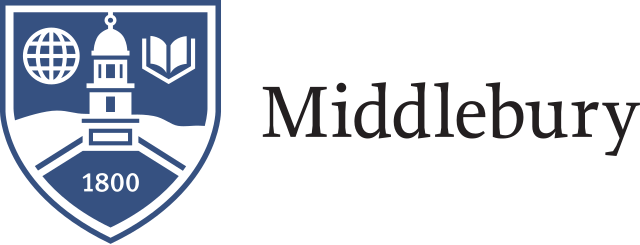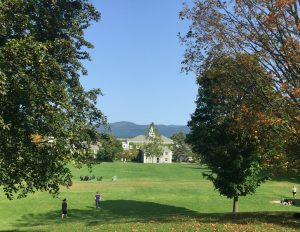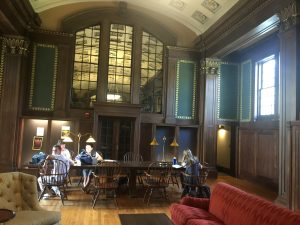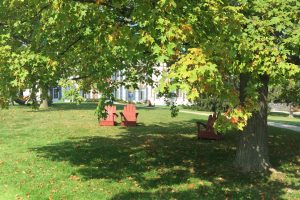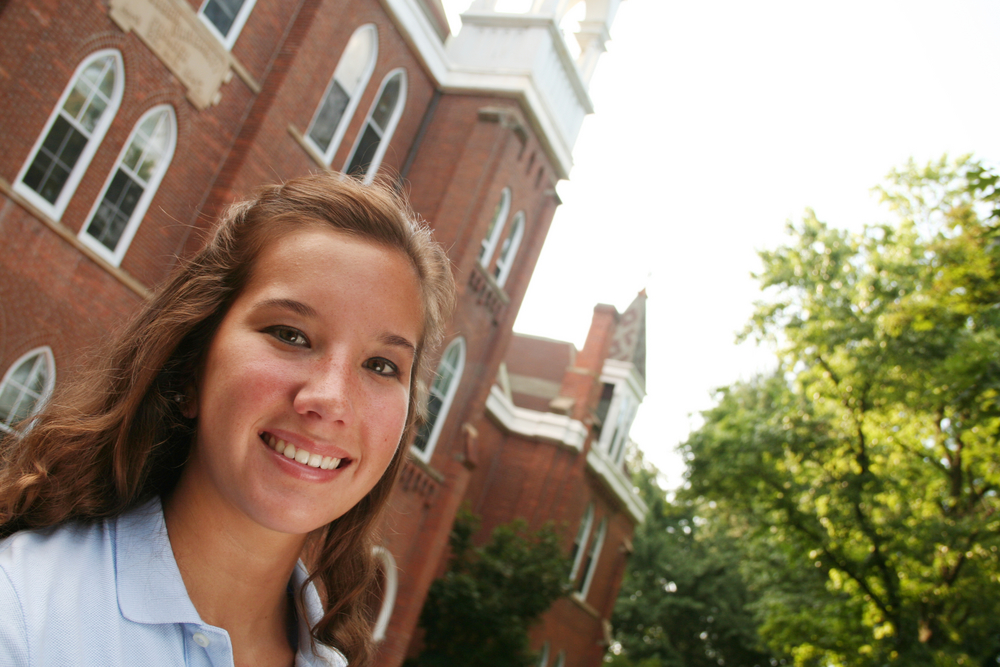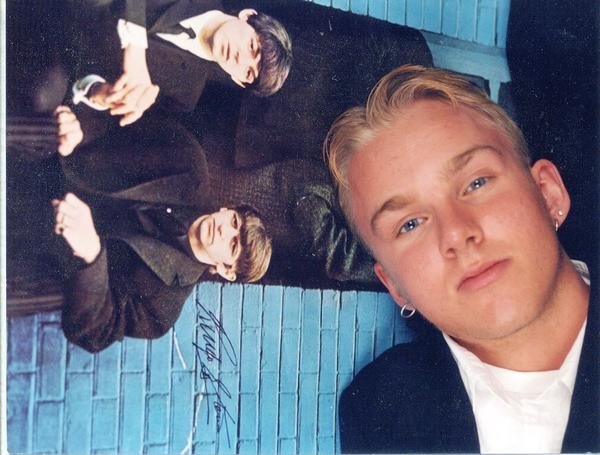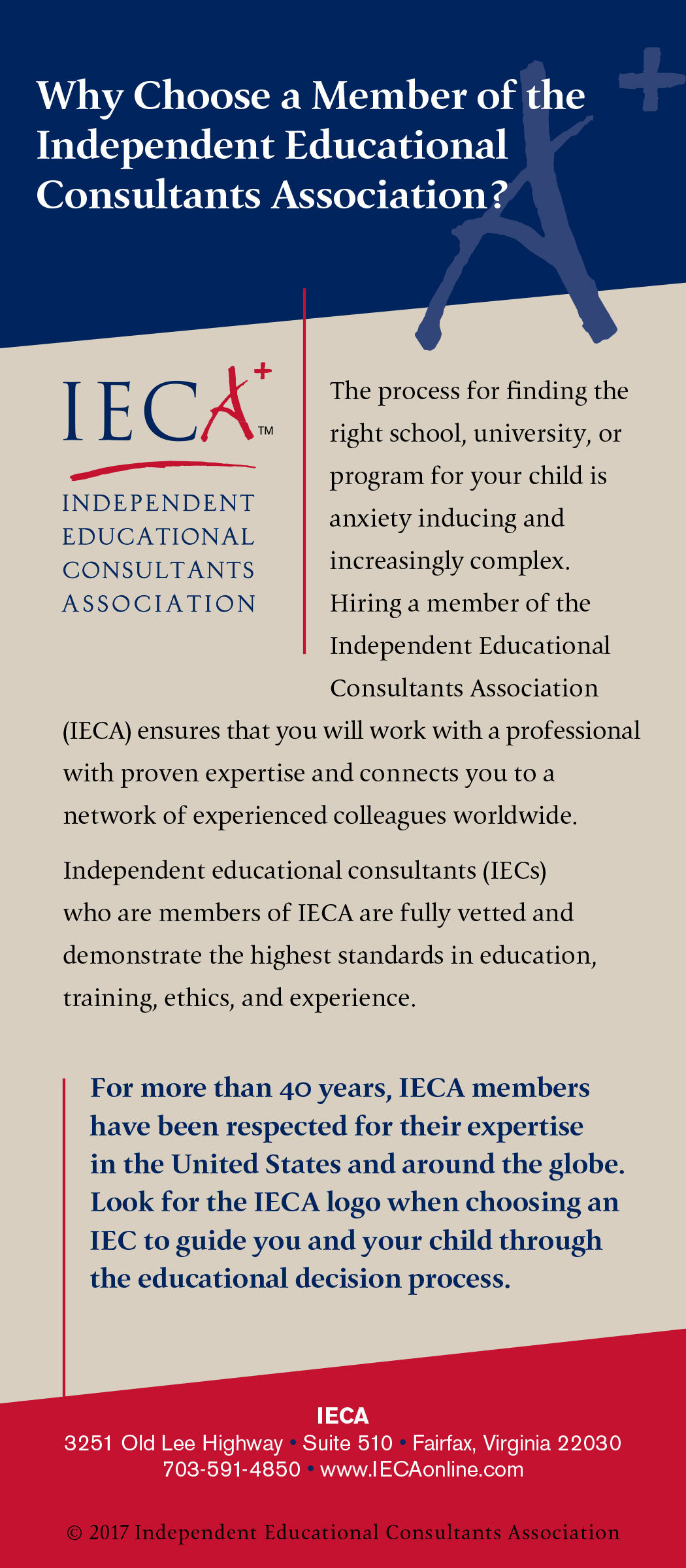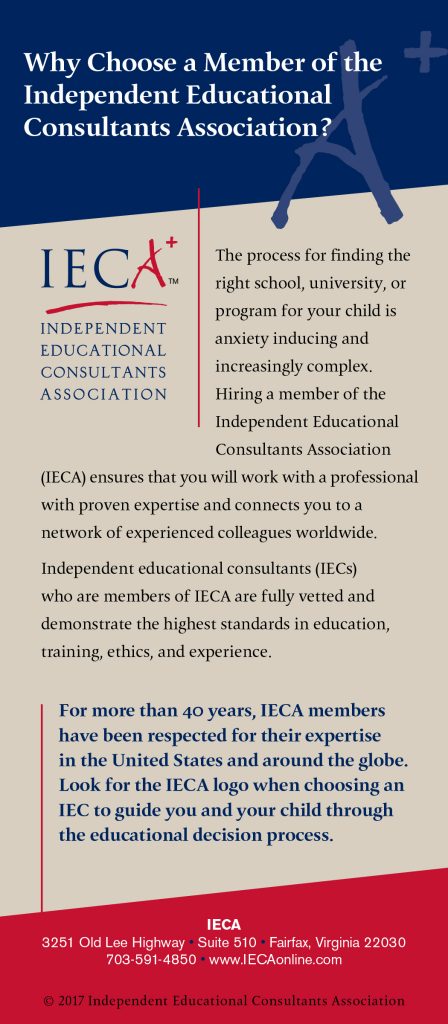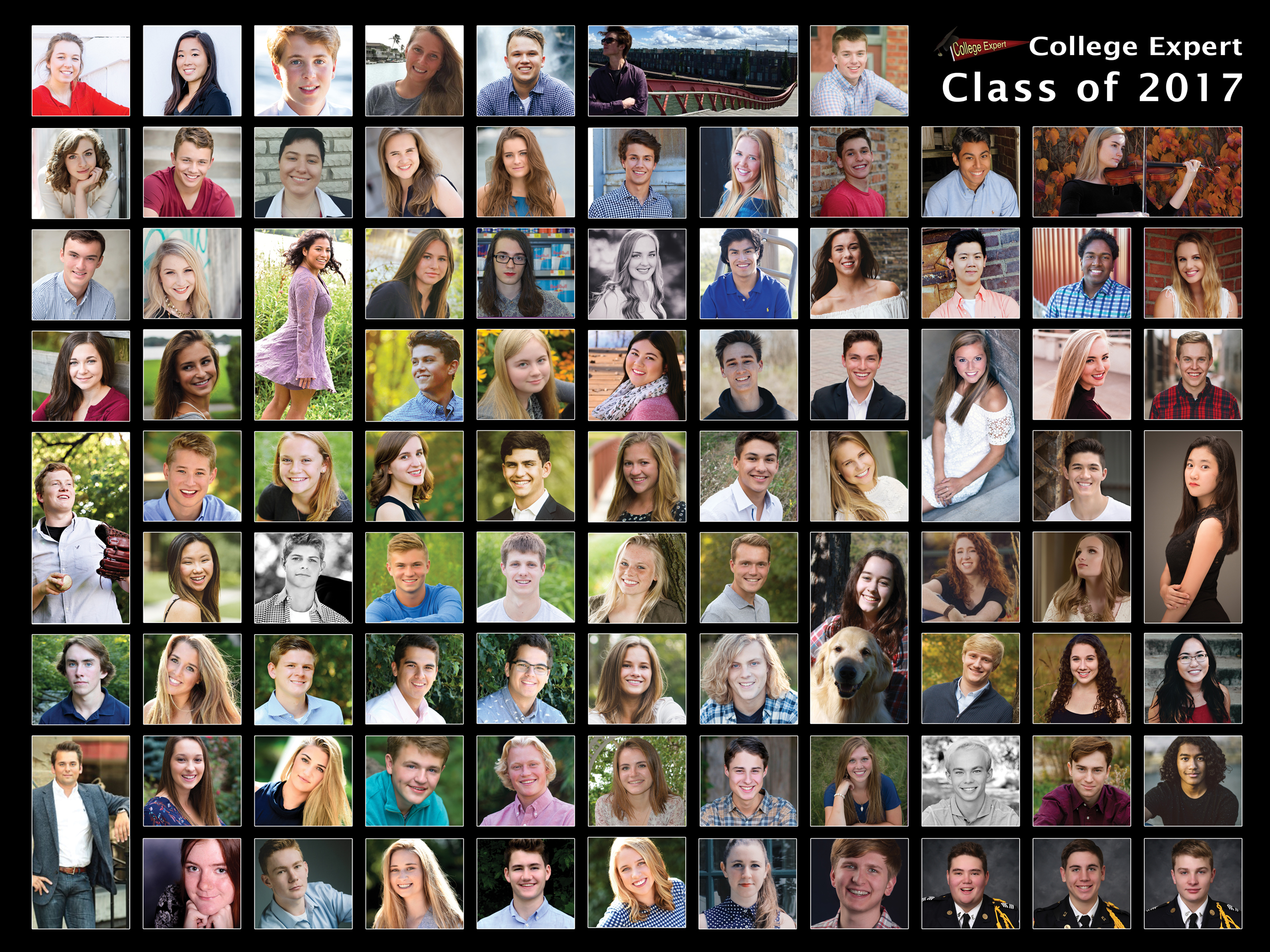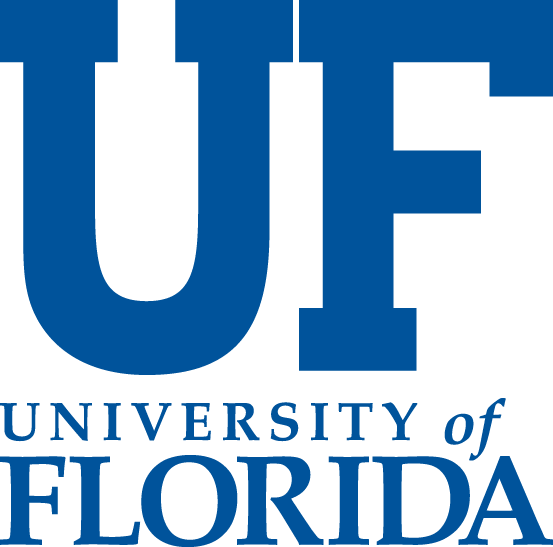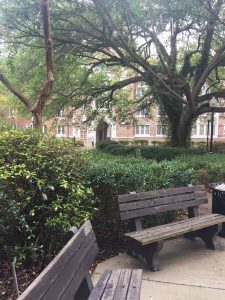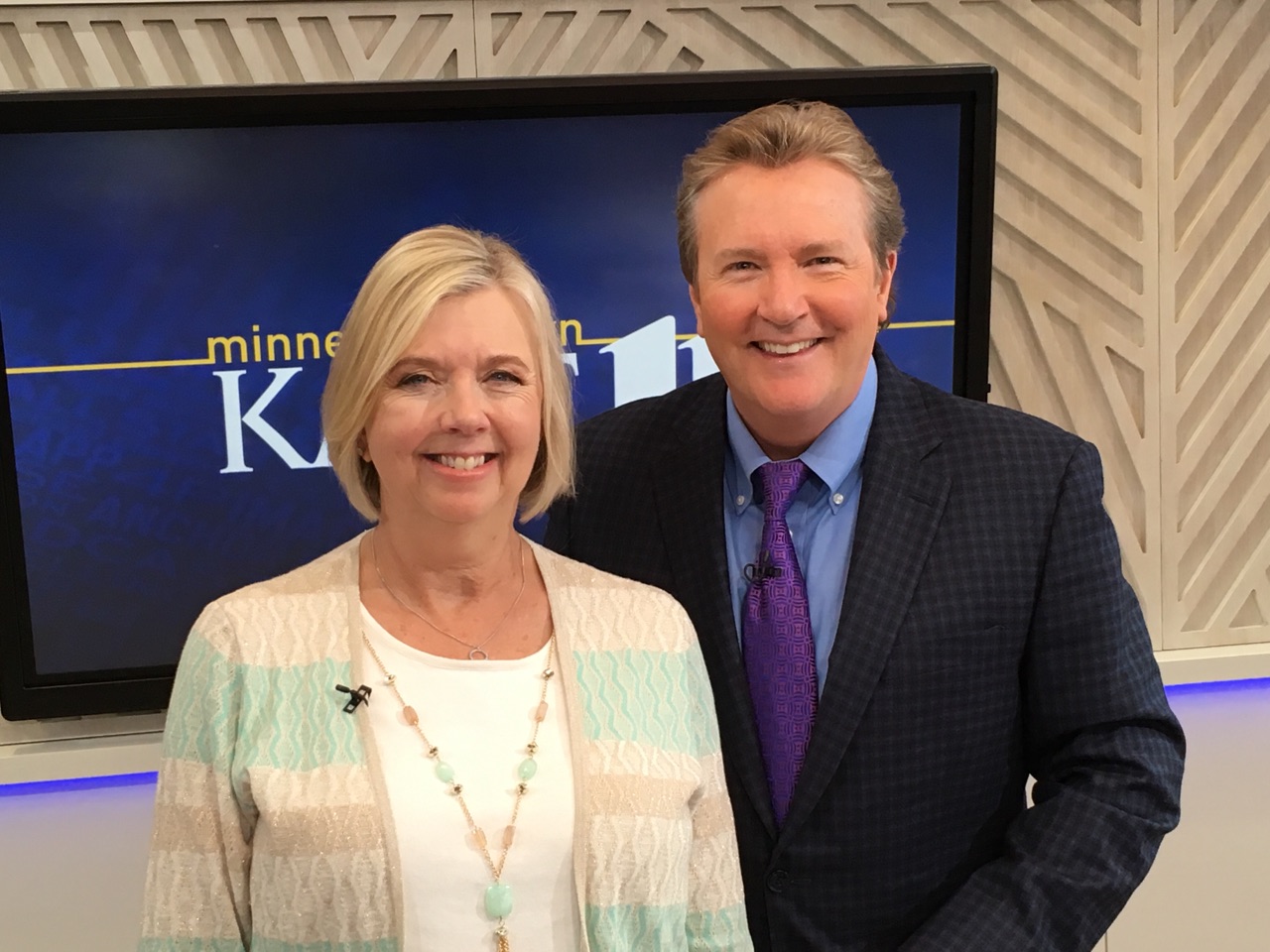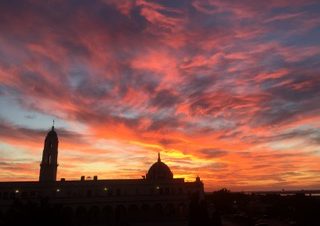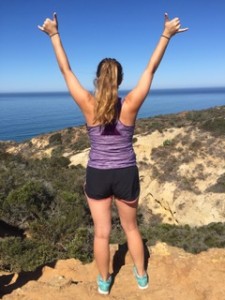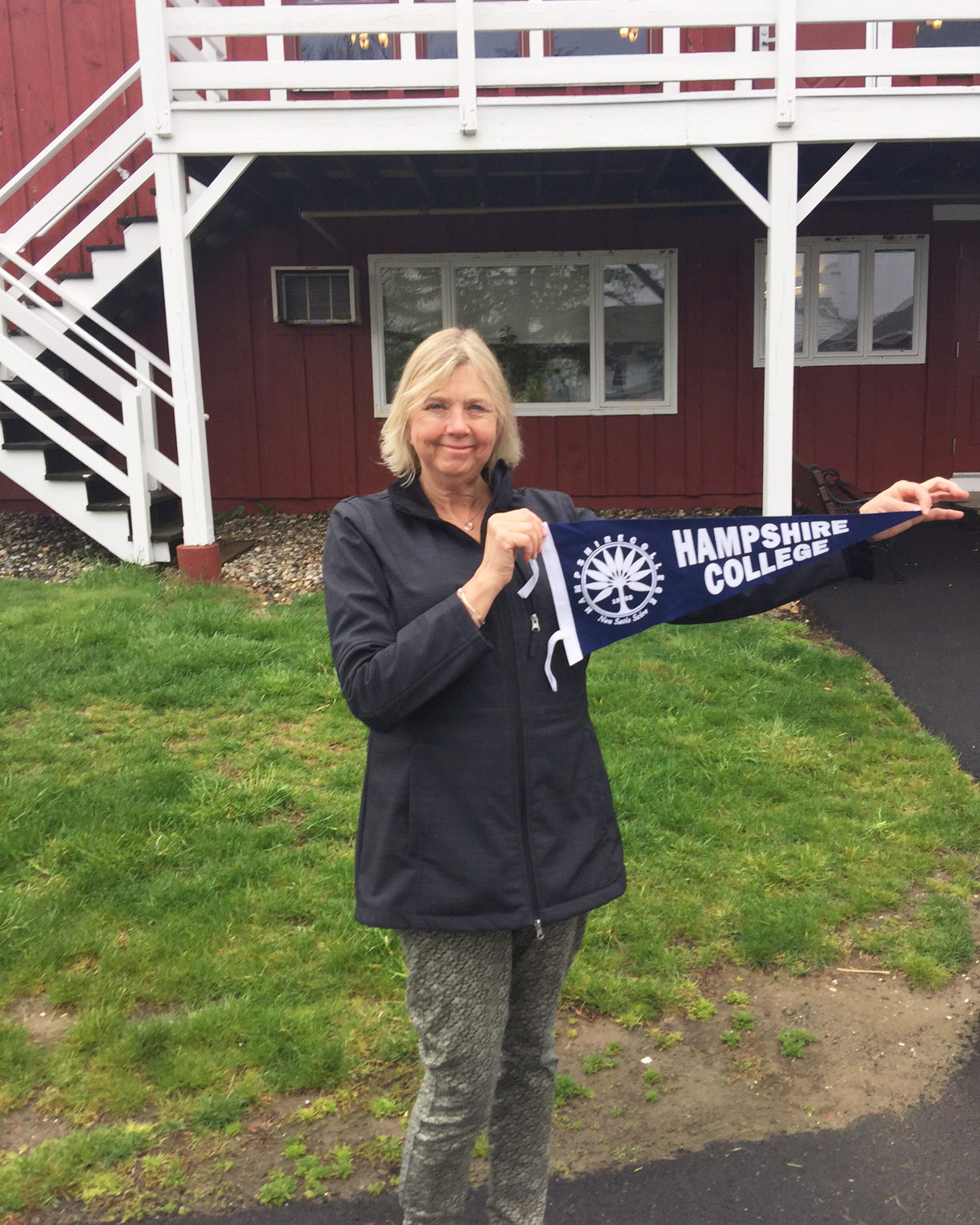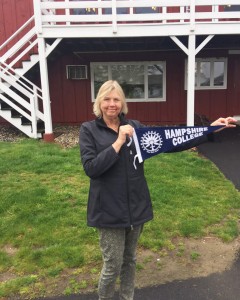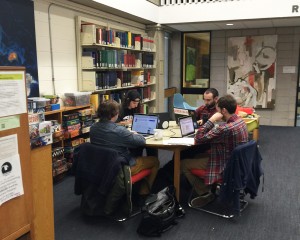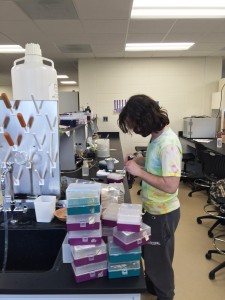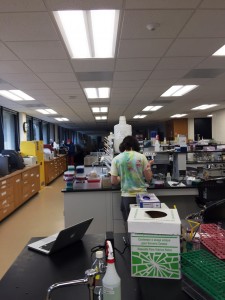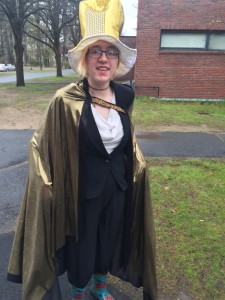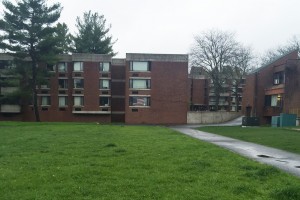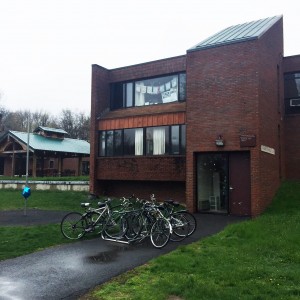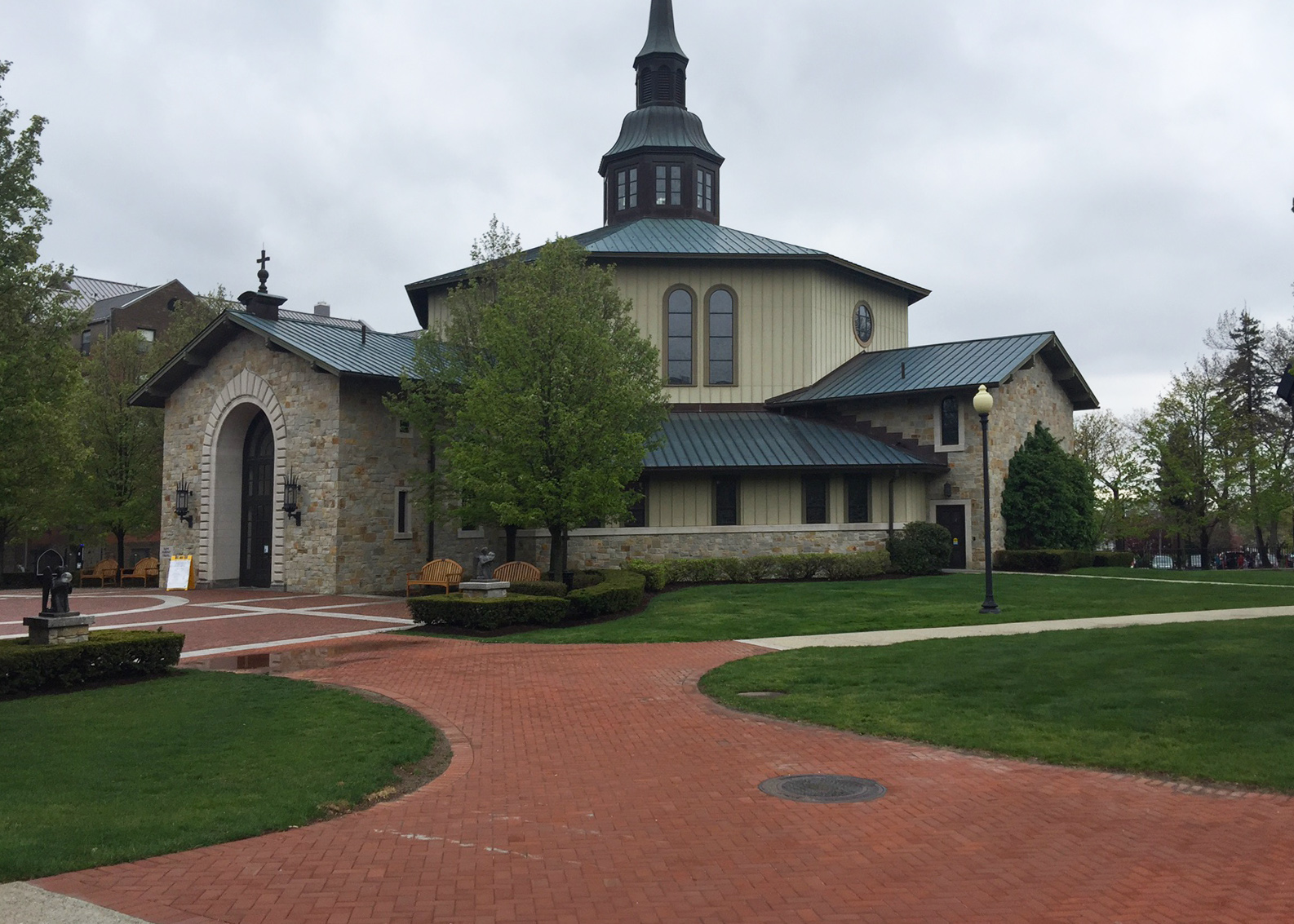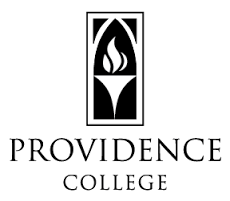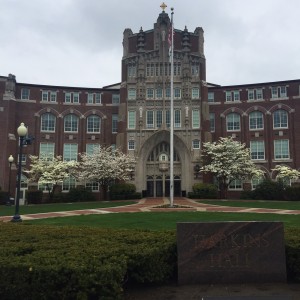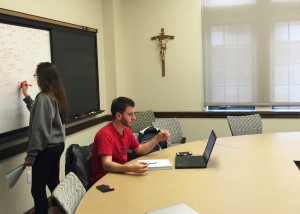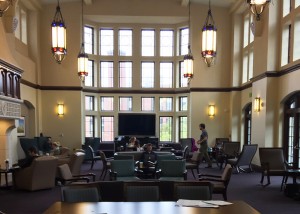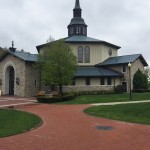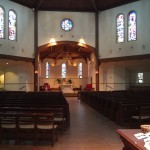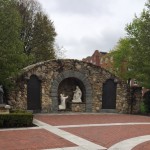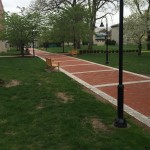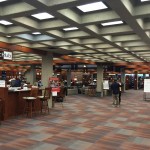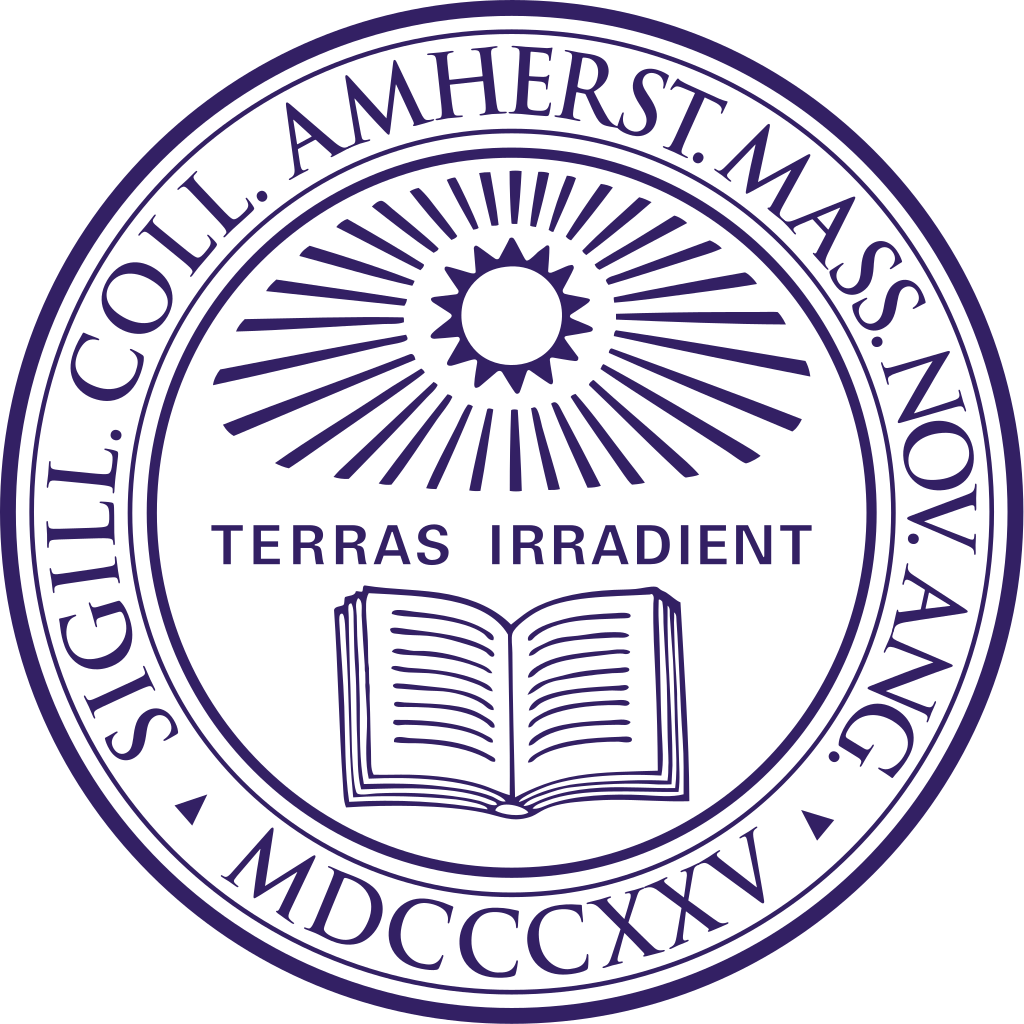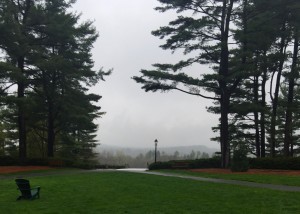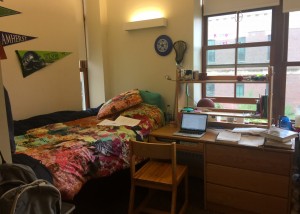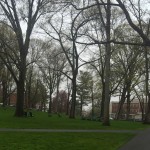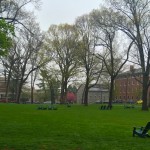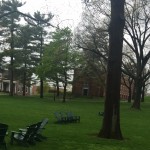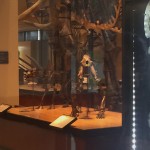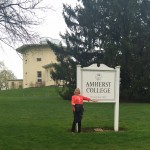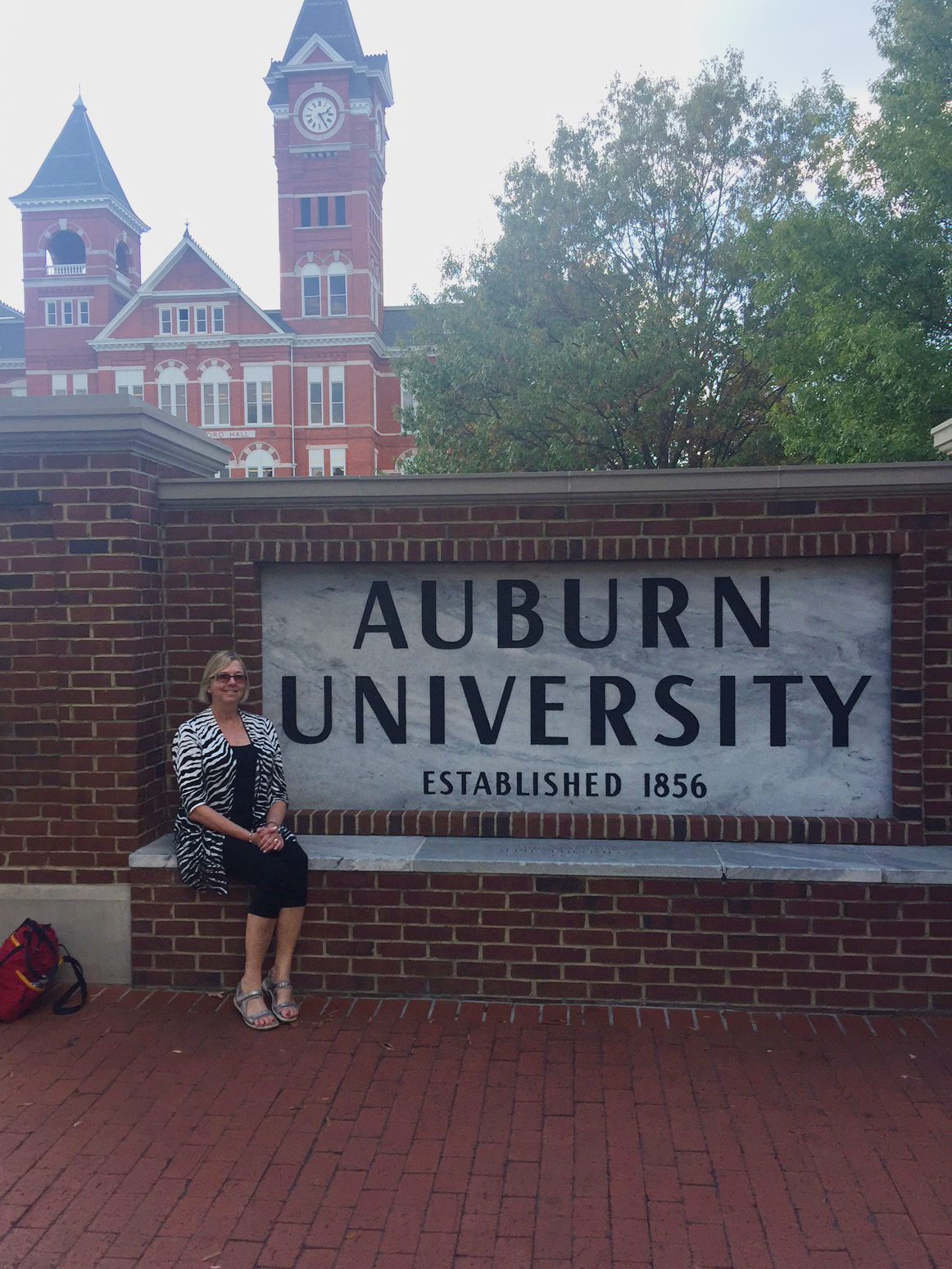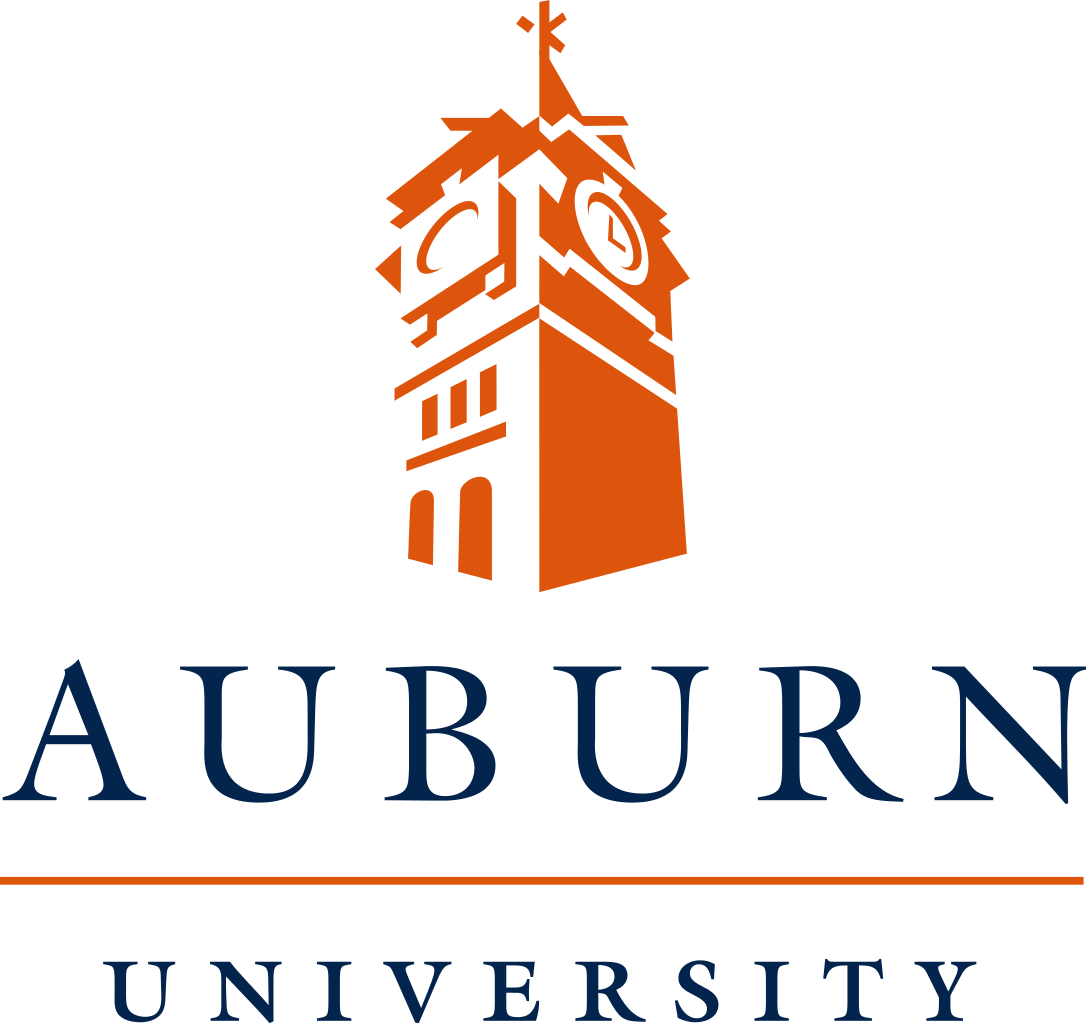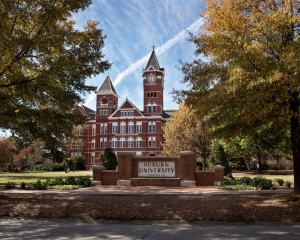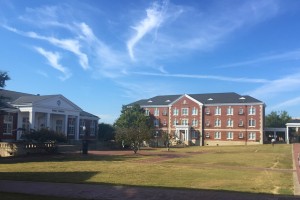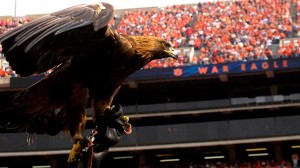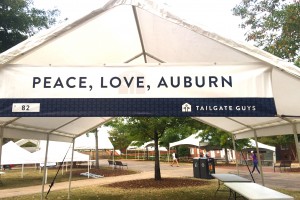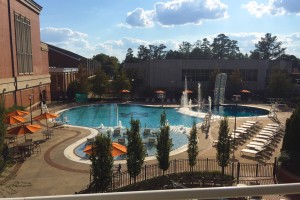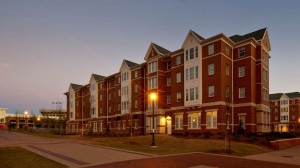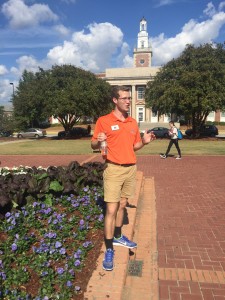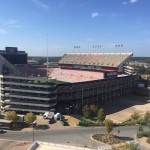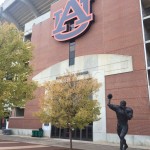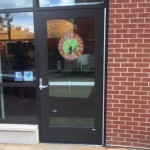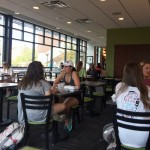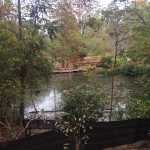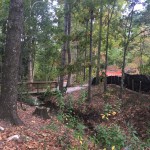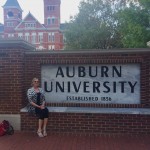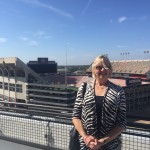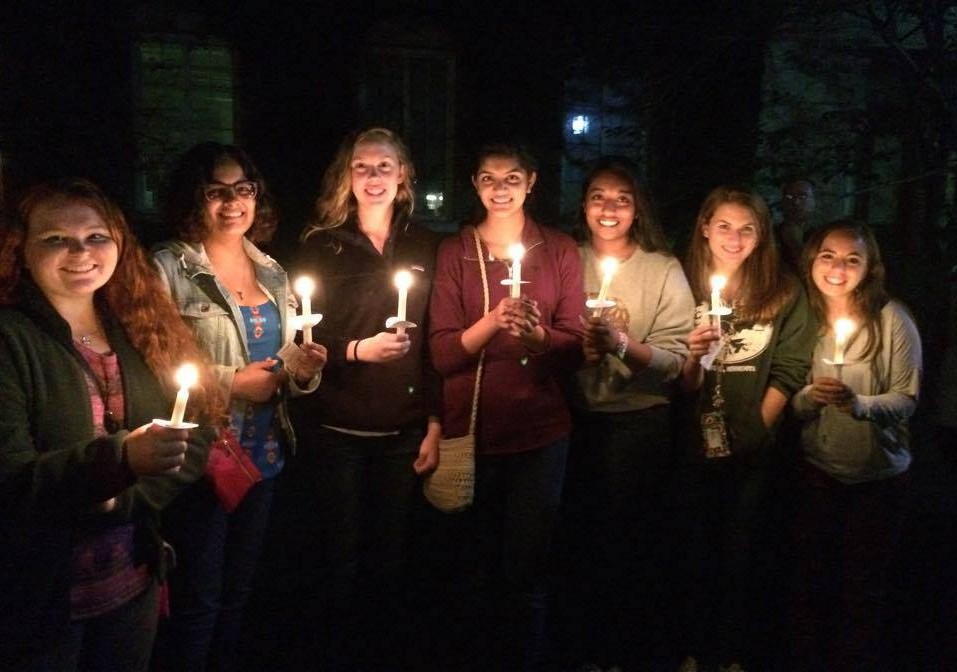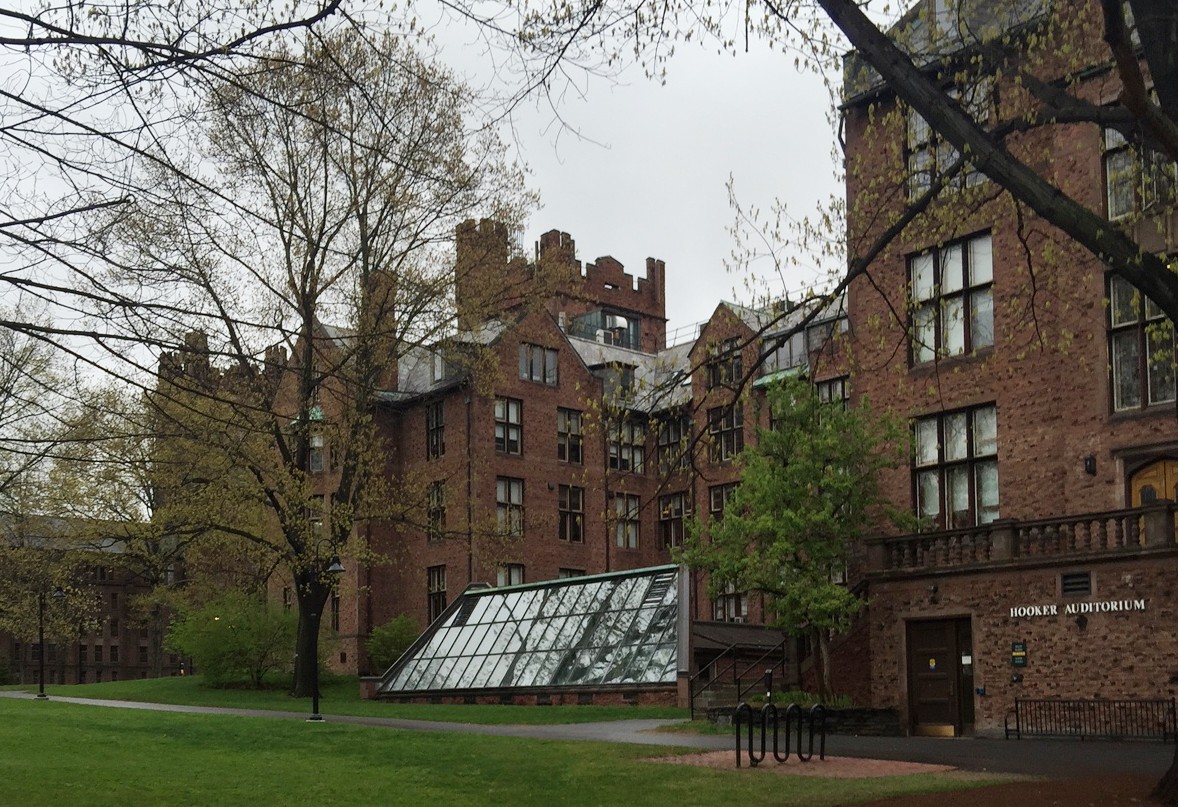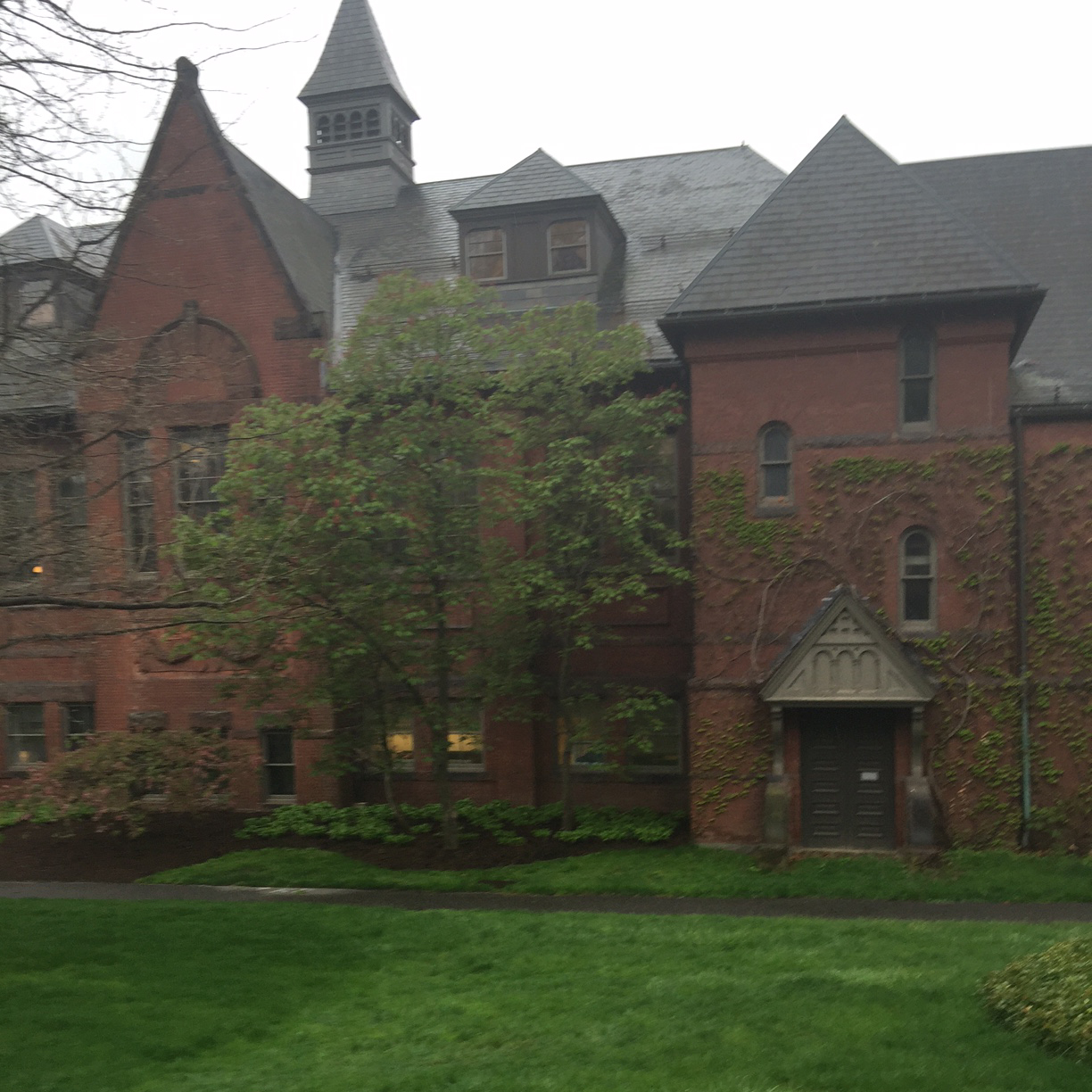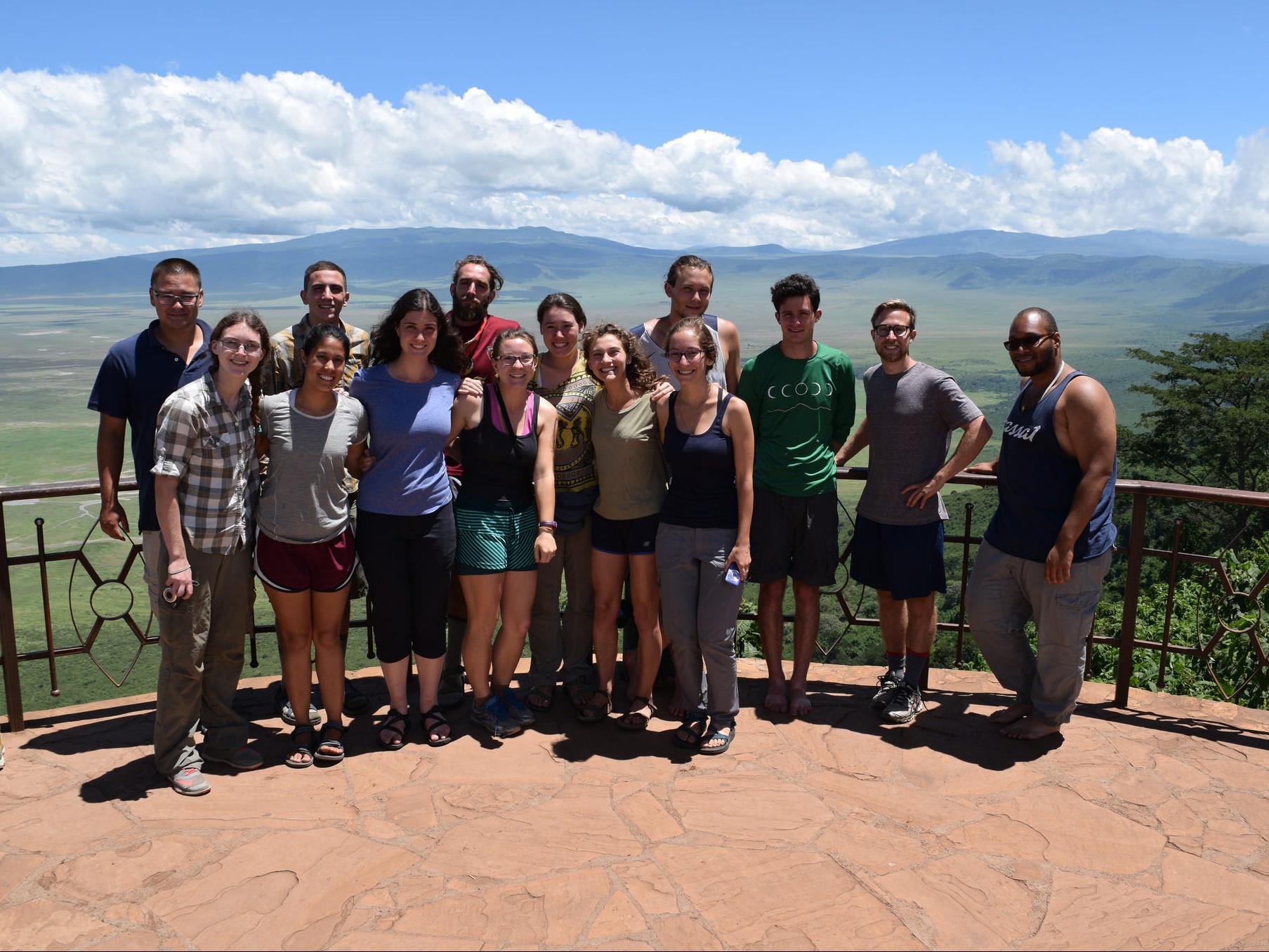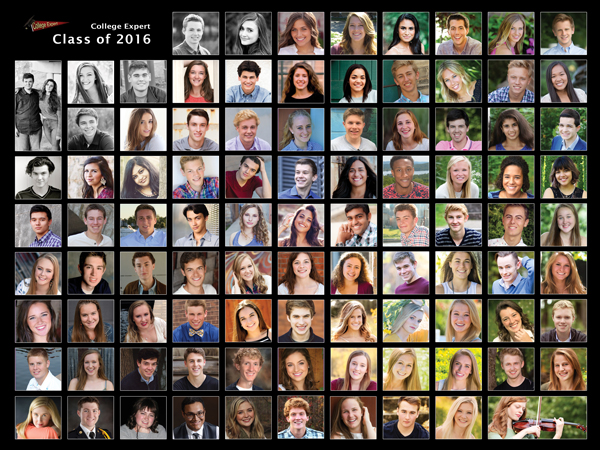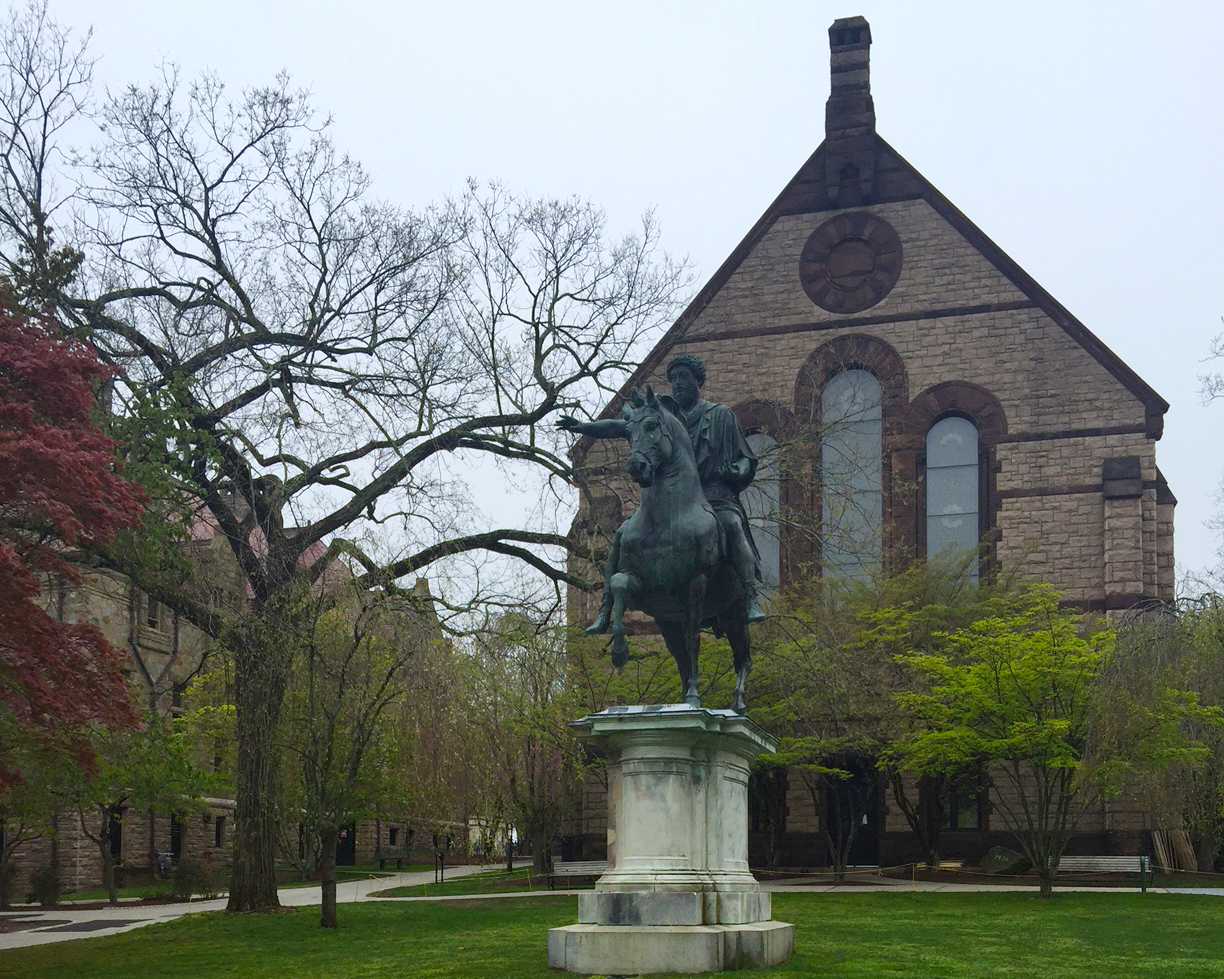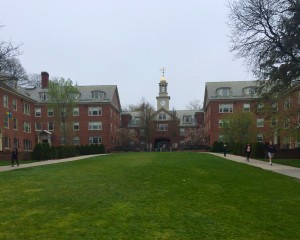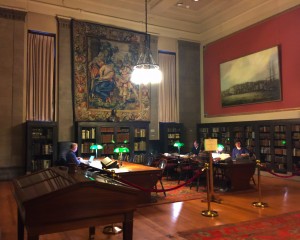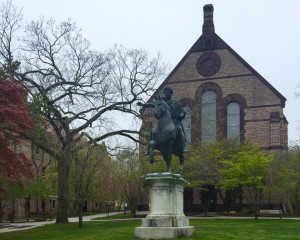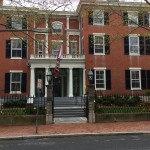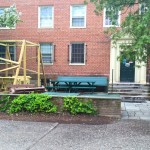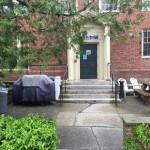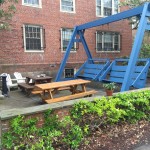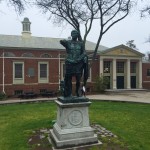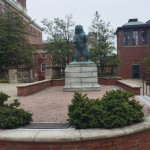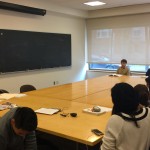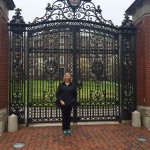A Visit to Middlebury College
I had the pleasure of touring the Middlebury campus with admissions counselor Margo Graham, who is a Minnesota native. This is a beautiful college campus located in a gorgeous and peaceful New England setting in small town Vermont.
Location
Founded in 1766, the town of Middlebury was burned to the ground during the Revolutionary War in 1778. As the town rebuilt from the fire, Middlebury College rose from the ashes, and was established in 1800. Today, the town of Middlebury is a cute, upscale town of just over 8,000, with a classic new england look and feel. Students can walk into town from campus and enjoy places to eat, shop, and explore the local arts scene. And the town loves its students right back, regularly attending the sporting events and music and theater performances at the College. Middlebury professors also tend to live in town and are a big part of the community. The closest airport is in Burlington, Vermont, just under an hour north of town. This college will appeal to Minnesotans who love snow! The area is surrounded by two different ski areas as well as a great system of cross-country ski trails. The Bread Loaf writers’ conferences held in August draws emerging poets and fiction writers to Middlebury every year for a series of workshops with established writers. The Conferences also offer a series of public readings and lectures, which draw students, professors, and community members.
Academics
Reflecting the College’s commitment to environmental stewardship and sustainable living, the environmental sciences and STEM fields are huge at Middlebury. Many students involved in the computer science program go on to jobs in Silicon Valley, and 85% of students applying to medical school are accepted. Students involved in music will find many different ensembles to choose from, or may want to audition for the winter term musical, which always sells out. The school’s language programs are also a big draw, both for students and outside scholars. Language learners travel to Middlebury for its summer language schools offering eleven languages, and Middlebury students enroll in high numbers at the College’s forty language immersion programs abroad. Language learners on campus can select from ten different languages, and join a language table in the lunchroom for casual conversation practice or apply to live in a language house on campus for further immersion. In addition to a range of summer course offerings, including travel-oriented courses at sites across the US, Middlebury also offers a winter term with a wide variety of courses to choose from. Students can expect to develop close relationships with their professors, who are very dedicated to their students and the community. Because there are no graduate students, professors often ask students to collaborate on research projects and papers, which can provide students with valuable hands-on experience.
Student life
Middlebury College prides itself on its interdisciplinary programs and majors, and encourages students to experience a breadth of different experiences across the departments. Study abroad is also a popular option, with over 50% of juniors studying in over forty different foreign countries each year. Those prospective students set on experiencing Greek life need not apply, there is none of that here. Instead, students keep busy with recreational activities in the area, clubs, and College-sponsored sports. Middlebury is part of the New England Small College Athletic Conference or NESCAC, and about 60% of students are involved in sports. 43% of students receive financial aid to attend through need-blind scholarships. Though a small school of 2,450 students, the student body is quite diverse, representing seventy different countries, and students from all fifty states.
Admissions
Middlebury College uses the Common App and Coalition App, and has a flexible scale for test scores. Taking a more holistic approach to admissions, Middlebury admissions is looking for students with a clear passion, strong character, desire to make a difference. If you are considering a gap year, Middlebury supports a model where students can choose to begin their first year in February rather than September. Affectionately termed “Febs,” Middlebury has found these students are more likely to assume leadership roles on campus and perform better academically.
Who would be happy here
Minnesota kids not trying to run away from winter weather would be very happy here! People are friendly, and they embrace and enjoy the winter. Students concerned for sustainability and environmental issues will likely be proud to attend this 100% carbon neutral institution. The majority of the school is also heated and cooled by the biomass gasification plant, which runs on locally-sourced wood chips rather than fuel oil. The city is generally quite liberal-leaning, but more conservatively-minded folks are certainly also welcome.
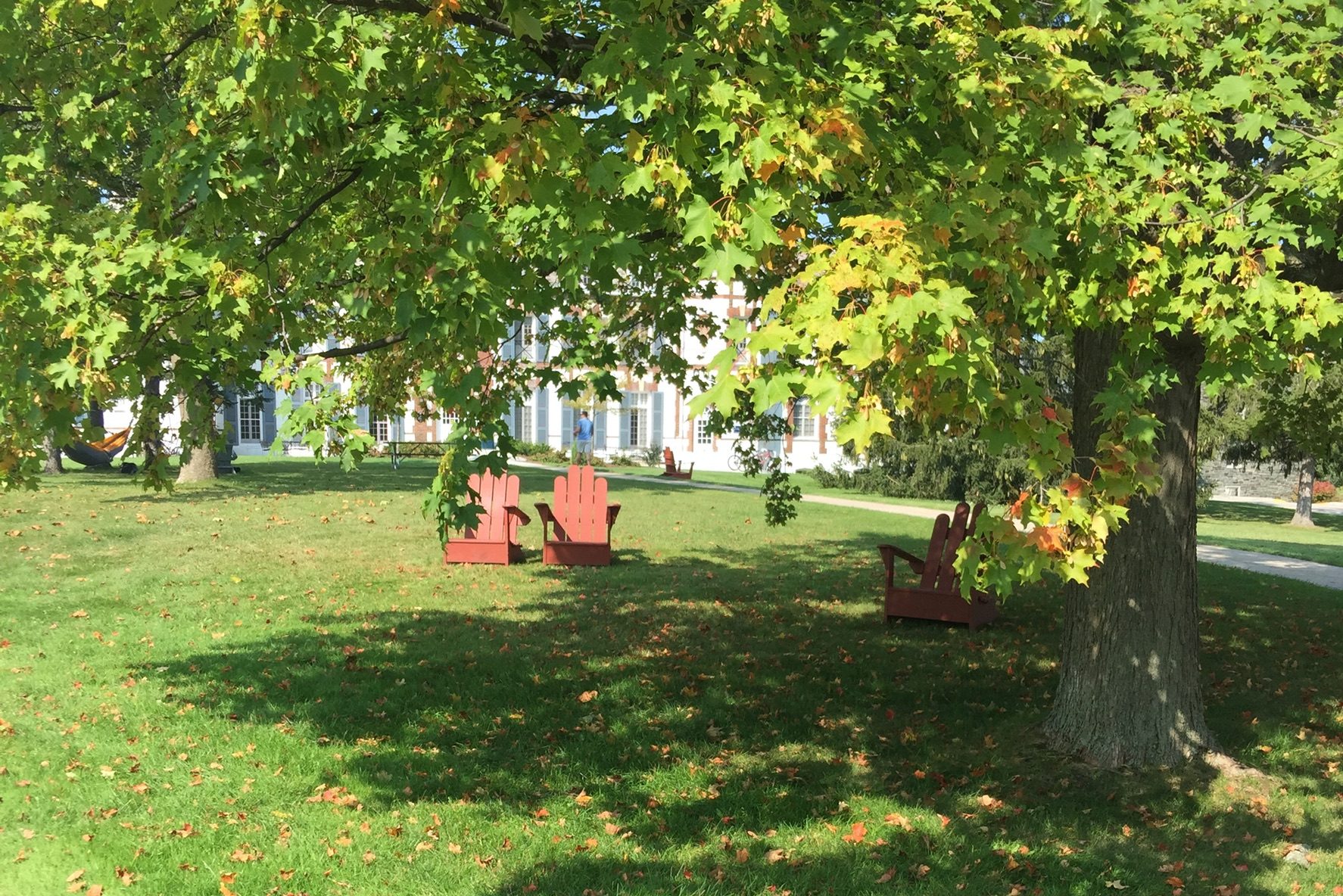
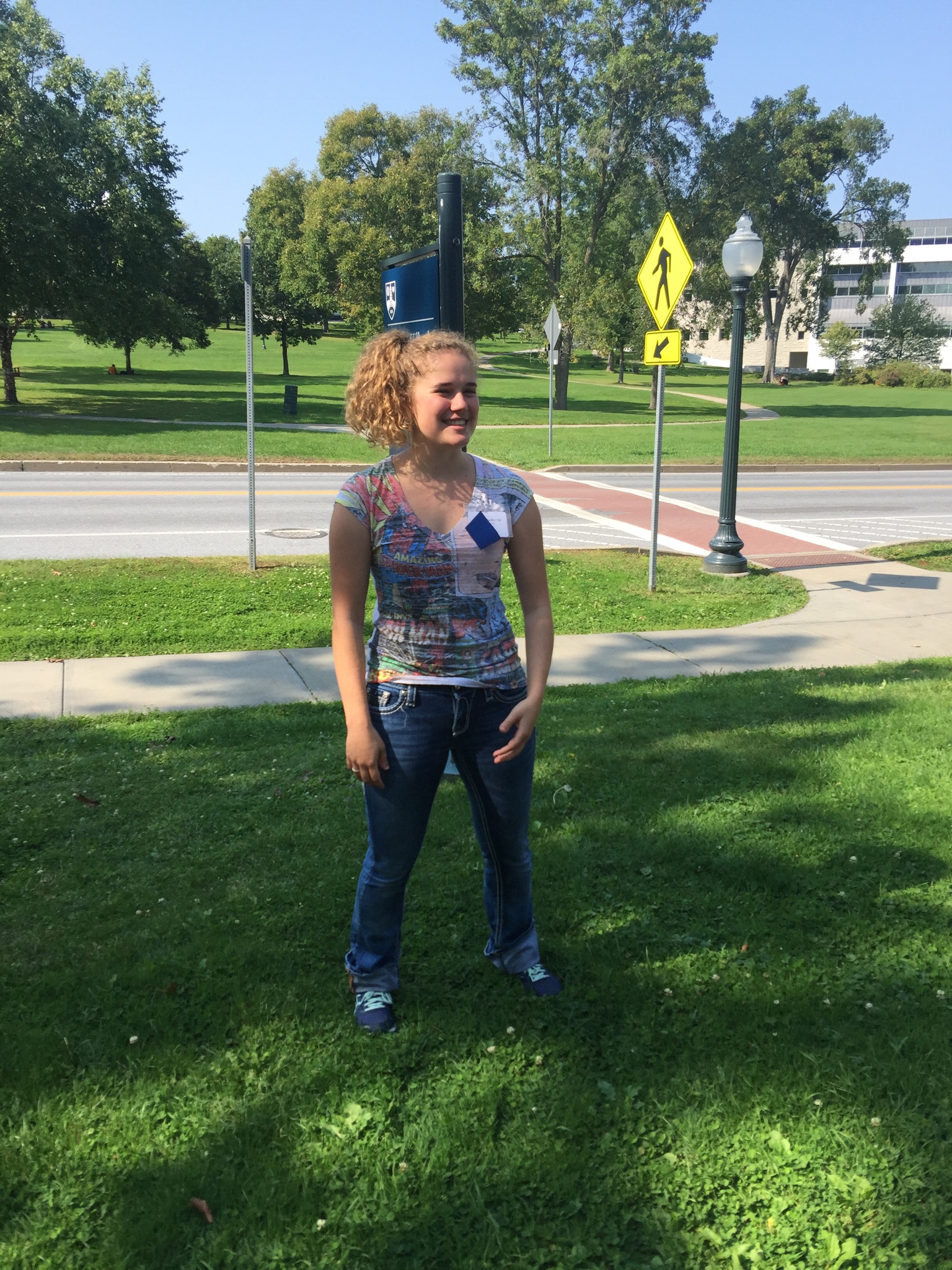
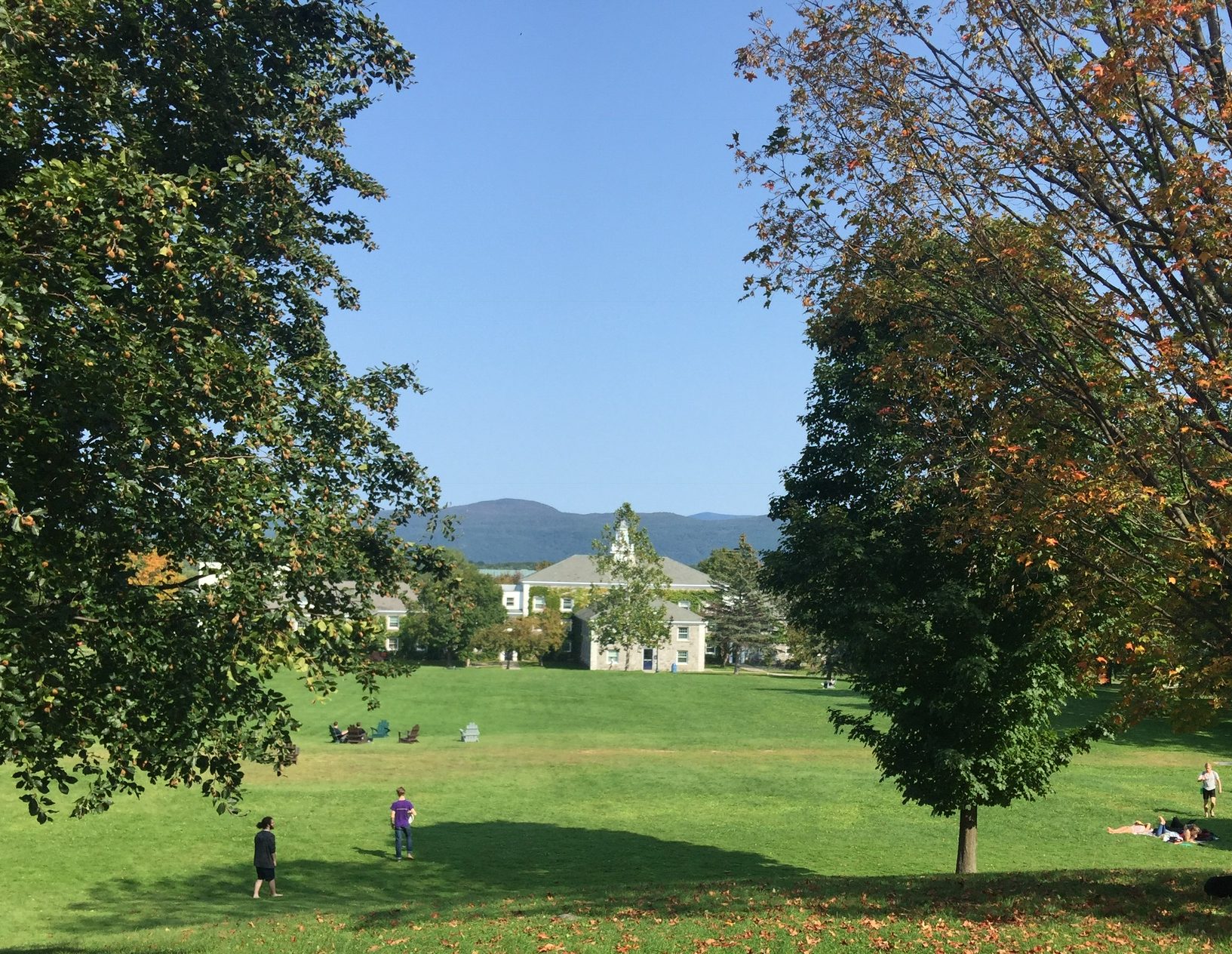
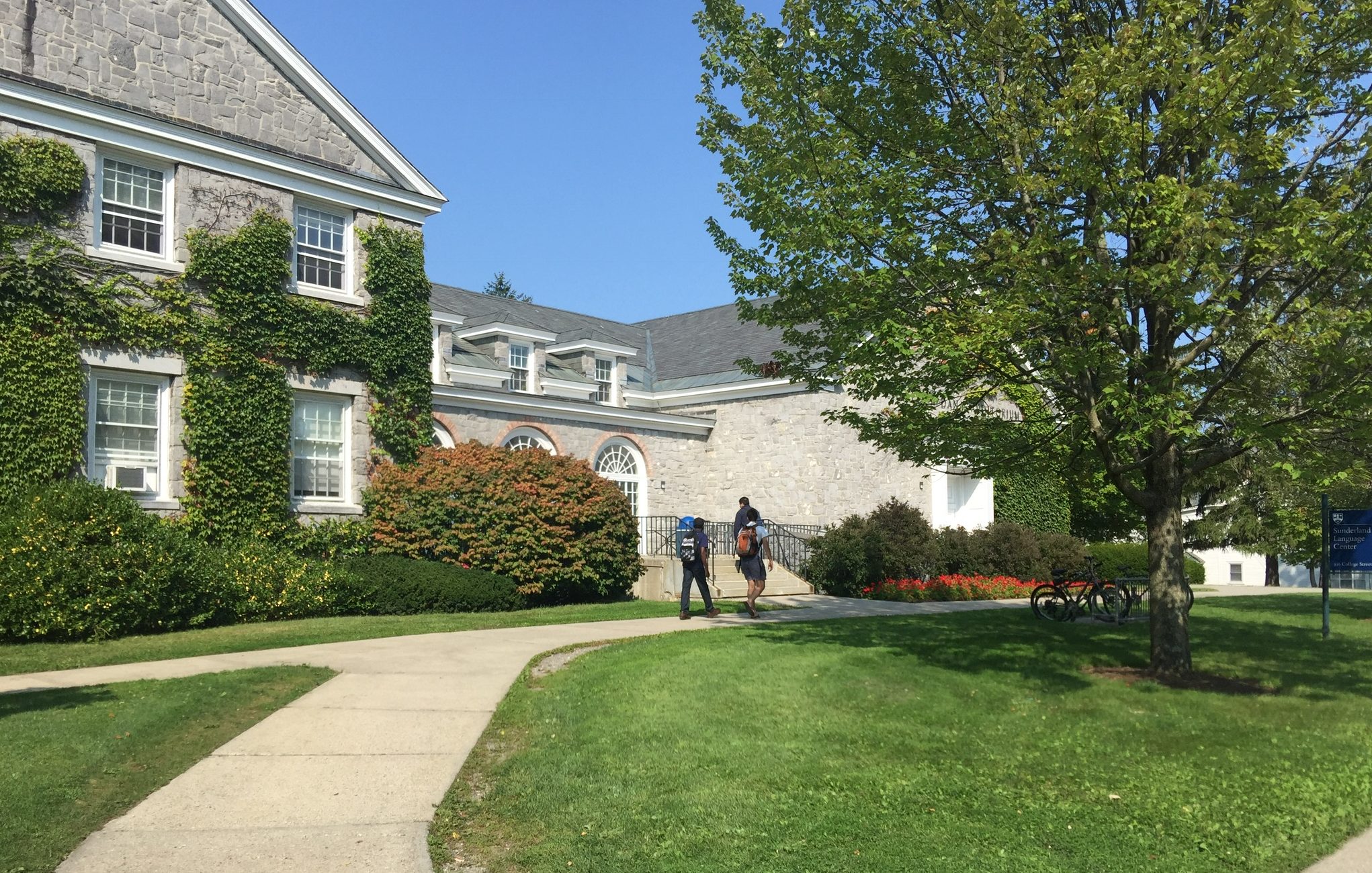
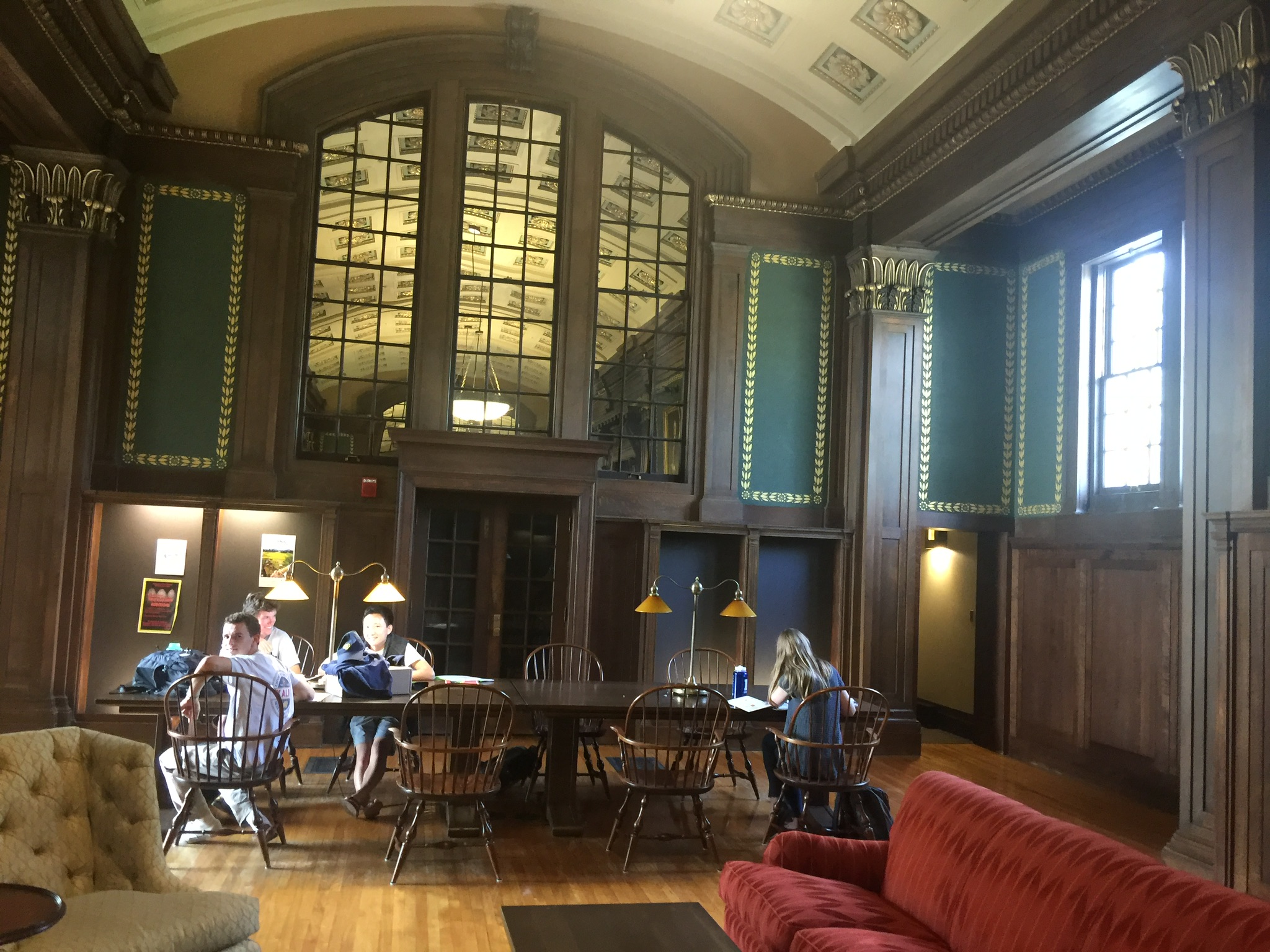
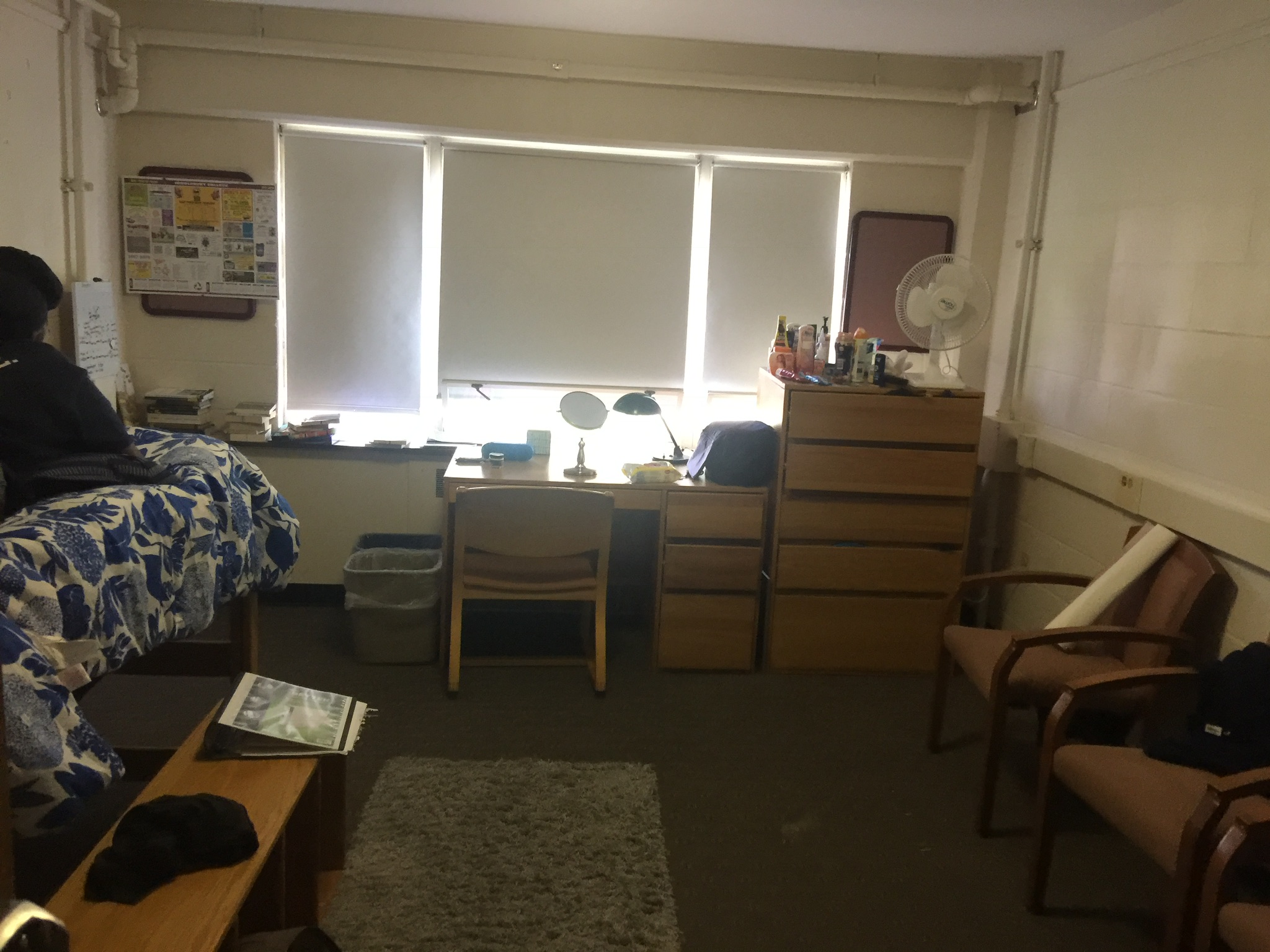

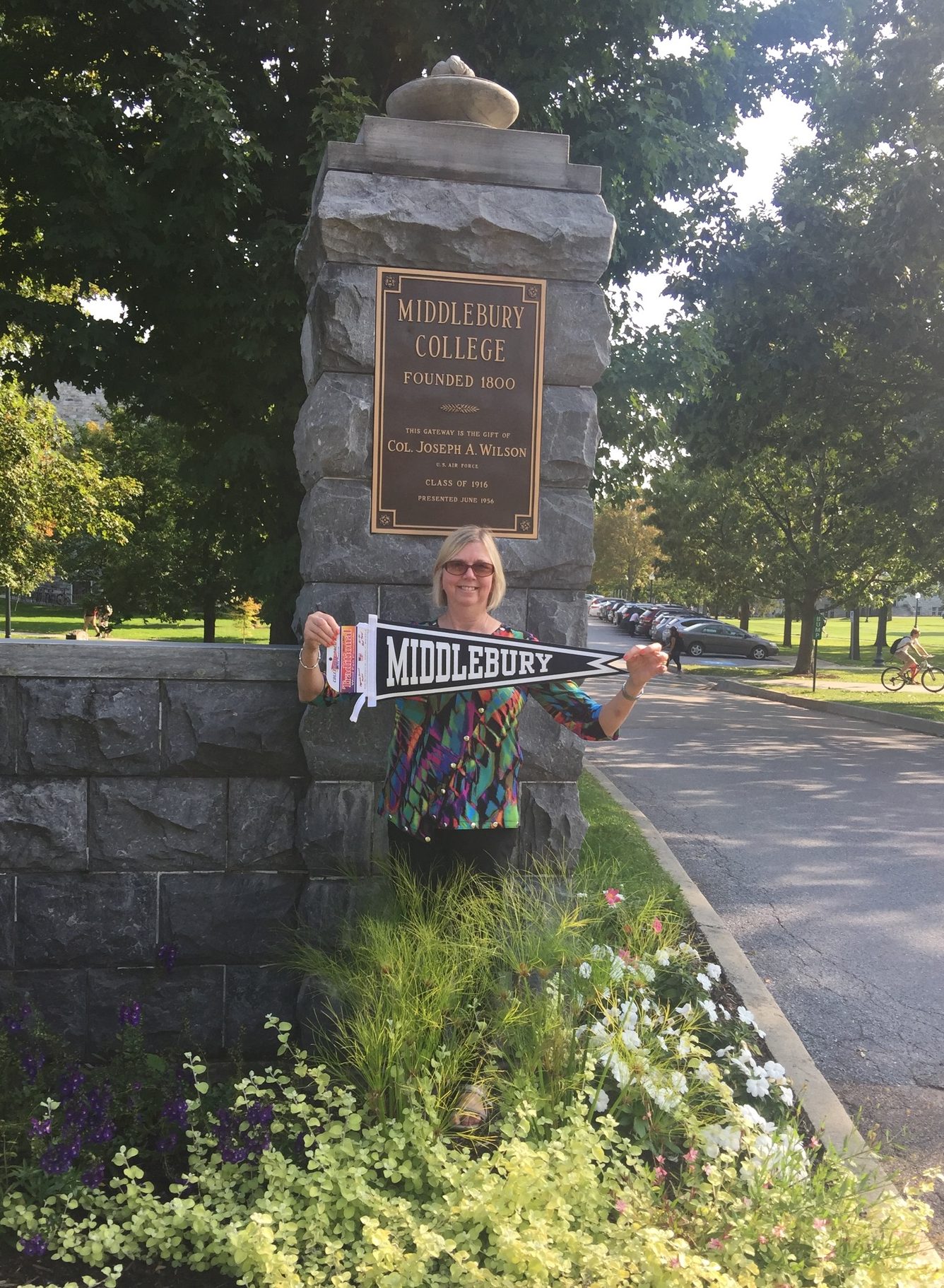
College Spotlight on University of Washington
Here is our latest College Spotlight – University of Washington. Read about Mimi’s experience “rushing” to join a sorority and her academic advice for freshman year.
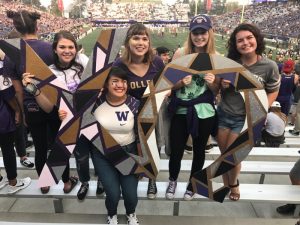
Character Counts!
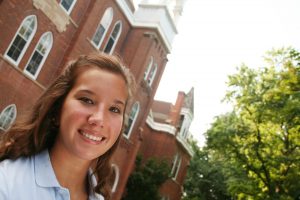
At College Expert, Ryan and I are honored to help students find the best matches between their personalities and campus cultures. Extensive research, college visits, and conferences enable us to put our fingers on the pulse of future happiness. We are experts at helping students develop academic, testing, and activities plans for high school.
Recently, in response to the new focus colleges are putting on the importance of personal qualities, we’ve added “character development” to our repertoire of discussions with students and parents. How does the concept relate to college admissions and beyond? For good reason, the Independent Educational Consultants Association’s Top 12 List identifies personal characteristics in the same league as demonstrated leadership and intellectual curiosity. While it’s an abstract topic to start, we find that many students are intrigued to have the conversation. And even those who experience an initial reaction of “Oh, no…something more to add to my busy schedule” do come around.
The highly-selective colleges, in particular, are “turning the tide” away from an emphasis on personal success by seeking students who make meaningful, ethical contributions to the common good. Harvard has much to say about this topic, including: “How open are you to new ideas and people? What about your maturity, character, leadership, self-confidence, warmth of personality, sense of humor, energy, concern for others, and grace under pressure?”
Duke’s website is crystal clear about what Admissions is seeking in a candidate: “Duke offers a multitude of opportunities to its undergraduates. We’re looking for students ready to respond to those opportunities intelligently, creatively and enthusiastically. We like ambition and curiosity, talent and persistence, energy and humanity…We especially appreciate students who love thinking hard about things and who like to make a difference in the world.”
And then there’s Boston College: “In selecting students, our admission staff looks for demonstrated evidence of academic ability, intellectual curiosity, strength of character, motivation, creativity, energy, and promise for personal growth and development. We also carefully consider recommendations by counselors and teachers, the required writing samples, and extracurricular activities”
How do we encourage our students to think about character-building in high school? First, we inform our clients of the priority that colleges place on the concept. Then, at every meeting, we touch on character development as part of the college planning agenda.
Here is a handful of ideas:
- Find a problem you see in your school, and try to fix it. One of our students noticed that the special needs kids washed the lunch tables every day. She found the practice to be unsettling and successfully approached the school administration to create change.
- Start something new and leave a legacy. Another student started a Fishing Club at his high school, eventually expanding the club to include middle and elementary school students.
- See a need? Think of it as an opportunity. With encouragement, our budding writers and artists have launched literary arts magazines and poetry slams at their schools.
- Look for genuine ways to show gratitude and kindness. Make friends with the lunch ladies, custodians and bus driver. Reach out to that kid who needs a friend.
- Find a cause that you genuinely care about. It does not have to be an epic adventure but can be local and on a small scale.
- Get to know your teachers. With their guidance, dive deeper into subjects that interest you. We remind our students that they will be asking some of the same teachers to write letters of recommendation. What better recommendation than from a teacher-mentor?
Ryan and I view our similar roles as that of guides—helping students navigate through an enjoyable secondary school journey while evolving into the best possible applicants. Character-building is not just for college applications, but rather, for the goal of becoming long-term contributors to society.
A Visit to The University of Vermont
Location
The University of Vermont (UVM) is located in Burlington, Vermont. With a population of 60,000, Burlington is both the largest city in Vermont, and the least populous U.S. city to be a state’s largest city! But it is really an ideal size for those looking for outdoor activities and things to do in town. Burlington has much to offer nature lovers, as well as those just looking for a leisurely brunch. The beautiful freshwater Lake Champlain, just a fifteen-minute walk from campus, will be a familiar sight for students from Minnesota, while the nearby mountains offer some exciting elevation and hiking trials. Burlington is known for its summer recreation activities, including boating, swimming, and camping. UVM offers many outdoors clubs, including the Outing club which sponsors camping trips, kayaking and other outdoor adventures.
Burlington’s artsy vibe may remind some of Minneapolis’ uptown neighborhood. The city has over 100 places to eat, including amazing gluten-free options. The Church Street district, located right next to campus, is where you’ll find constant activity, people, dogs, fun restaurants, music stores, shopping, and live music every night.
Though Burlington has a very warm, hometown feel, 75% of UVM students are from out of state. To cater to the out-of-towners, the city has an international airport with good connections. It is also very close to many major urban centers when the city starts to feel like a small town: five hours from New York City, four hours from Boston, and just two hours from Montreal, Canada.
Academics
This public land grant university was founded in 1791 by Ira Allen. With a student body of around 10,992, an average class size of thirty, and 98% professor-taught classes, UVM feels more like a small liberal arts college than a large state school. Academically, the school is known for its strong and innovative programs in environmental science, engineering, psychology, pre-law, and business. It also has a teaching hospital directly on campus connected to the nursing, pre-med and health sciences programs. UVM also proudly fosters learning experiences outside the classroom, that unite the local and the global, including a variety of environmental research projects. Over 90% of seniors are involved in either undergraduate research, experiential learning, or internship opportunities, and over 99 service-learning based courses are offered.
Admissions
UVM accepts 68% of applicants. Admission is based on an ACT range of 27 to 32. To get accepted into the Honors program, the ACT range will need to be between 32 to 34. (UVM also super scores both the ACT and SAT). Admissions decisions focus on rigor of classes in addition to the GPA, but require a 3.41 GPA. UVM accepts both the Common and Coalition Apps. Students are also required to create an admissions portal to add additional information. The total cost of UVM is $50,000 annually for out of state students, with merit-based scholarships available up to $18,000.
Student life
UVM offers a range of activities, clubs, and resources that will appeal to the sports fan to the artist. At the Living/Learning Center, students can join the Pottery or Photography Co-op for a small membership fee to gain access to special equipment and materials, or apply to join the Arts Initiative, which UVM students with artists across the state of Vermont and socially-engaged art projects. At the Living/Learning Center, you will also find an art gallery and the Rhythm and Brews Coffeehouse, which sponsors a weekly open mic night. Sports fans will soon get acquainted with the UVM mascot: Rally the Catamount. The catamount, for those interested, is a wildcat. The UVM Catamounts basketball team have occasionally found their way into the NCAAP tournament, but hockey games are always packed with students. Only 8% of students are involved in Greek life. This is an active Greek community, but quite small. Overall, students are friendly, politically involved, interested in community work, and environmentally conscious.
What kind of student would be happy here?
This is a great option for students from Minnesota—with similar weather, natural beauty, and things to do outside. Students who embrace winter weather will be particularly happy here, and the Stowe ski hill is close by. But though the outdoors are spectacular, being outdoorsy is not a requirement. UVM is also an excellent choice for students looking for an adventure and trying to find their passion, who are open to exploring new ideas and experiences. The city remains quite liberal, very eco-friendly, and politically-engaged. Bernie Sanders was the mayor of Burlington from 1981-1990 and it shows: Burlington offers its own municipal broadband/cable service and city-owned power company. Students who are dog-lovers would also be happy here, there are dogs everywhere!
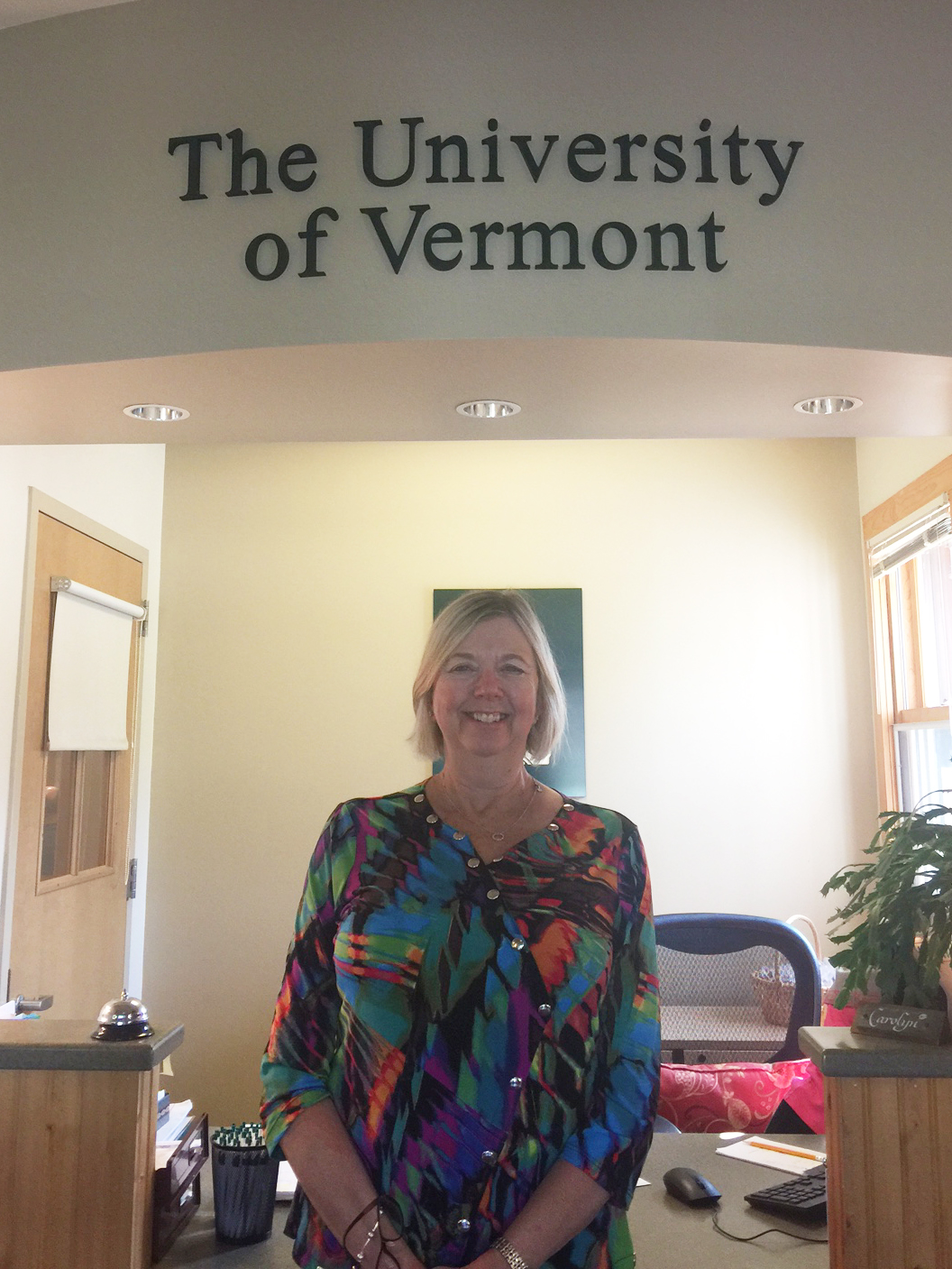
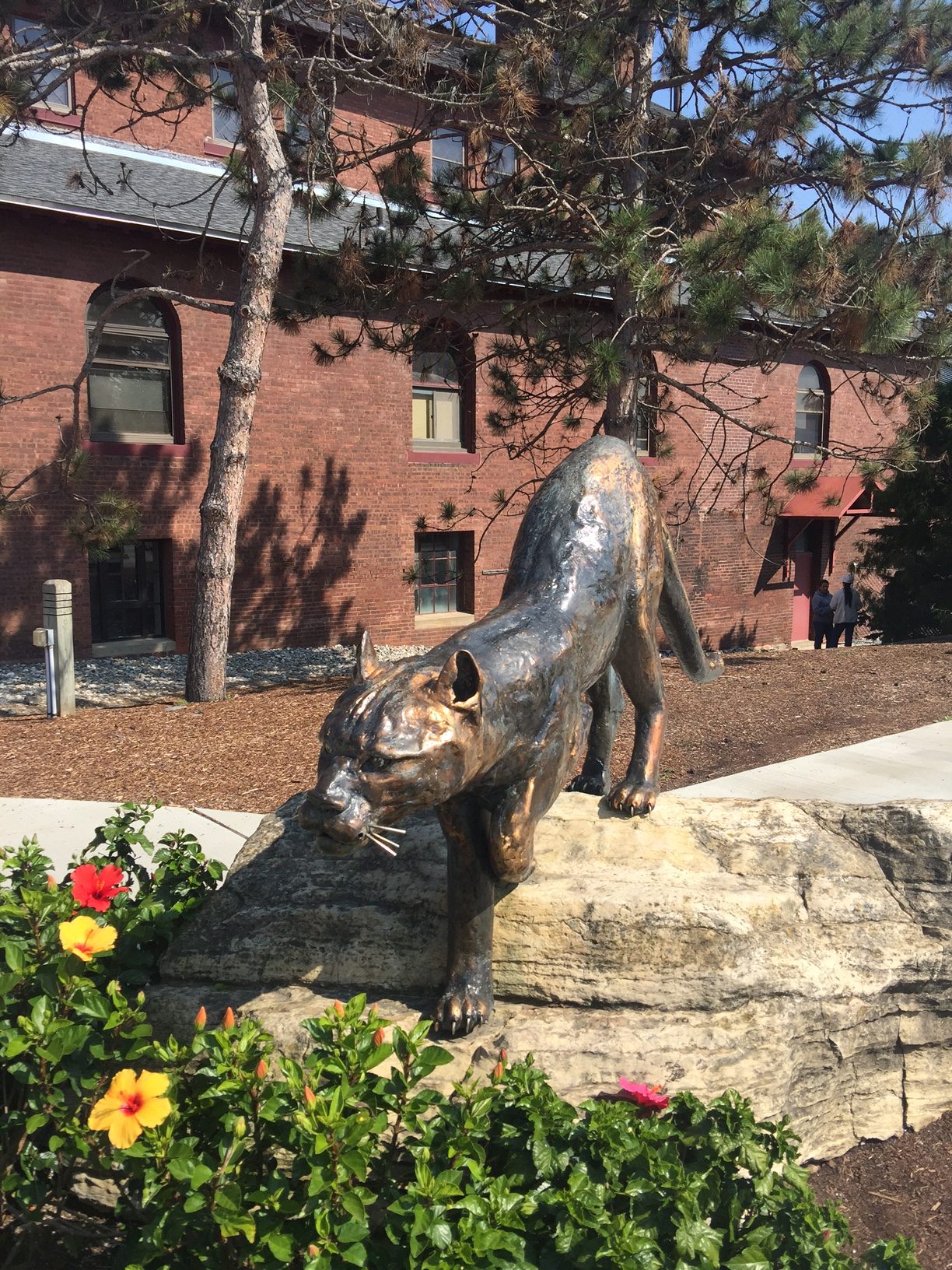
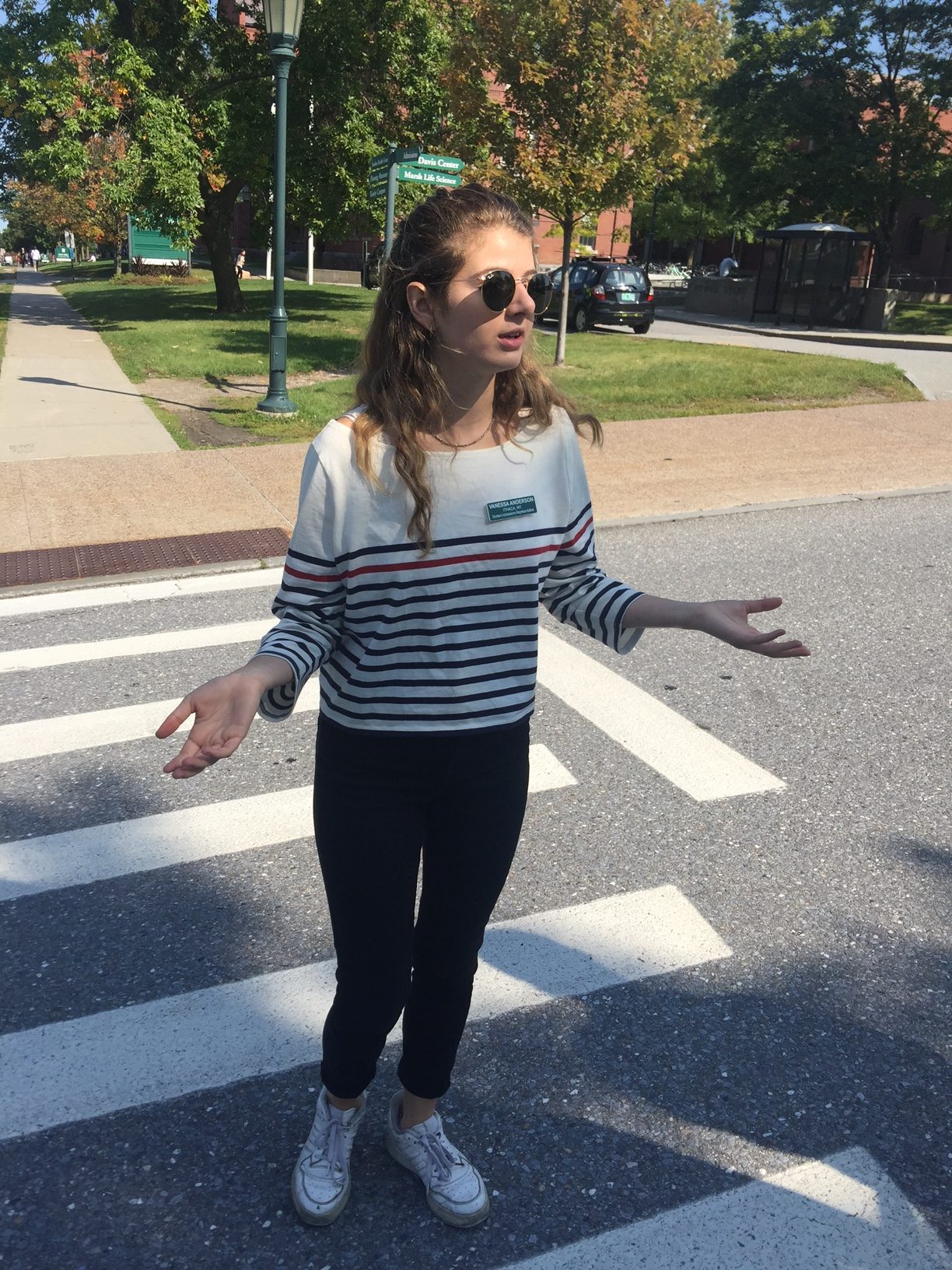
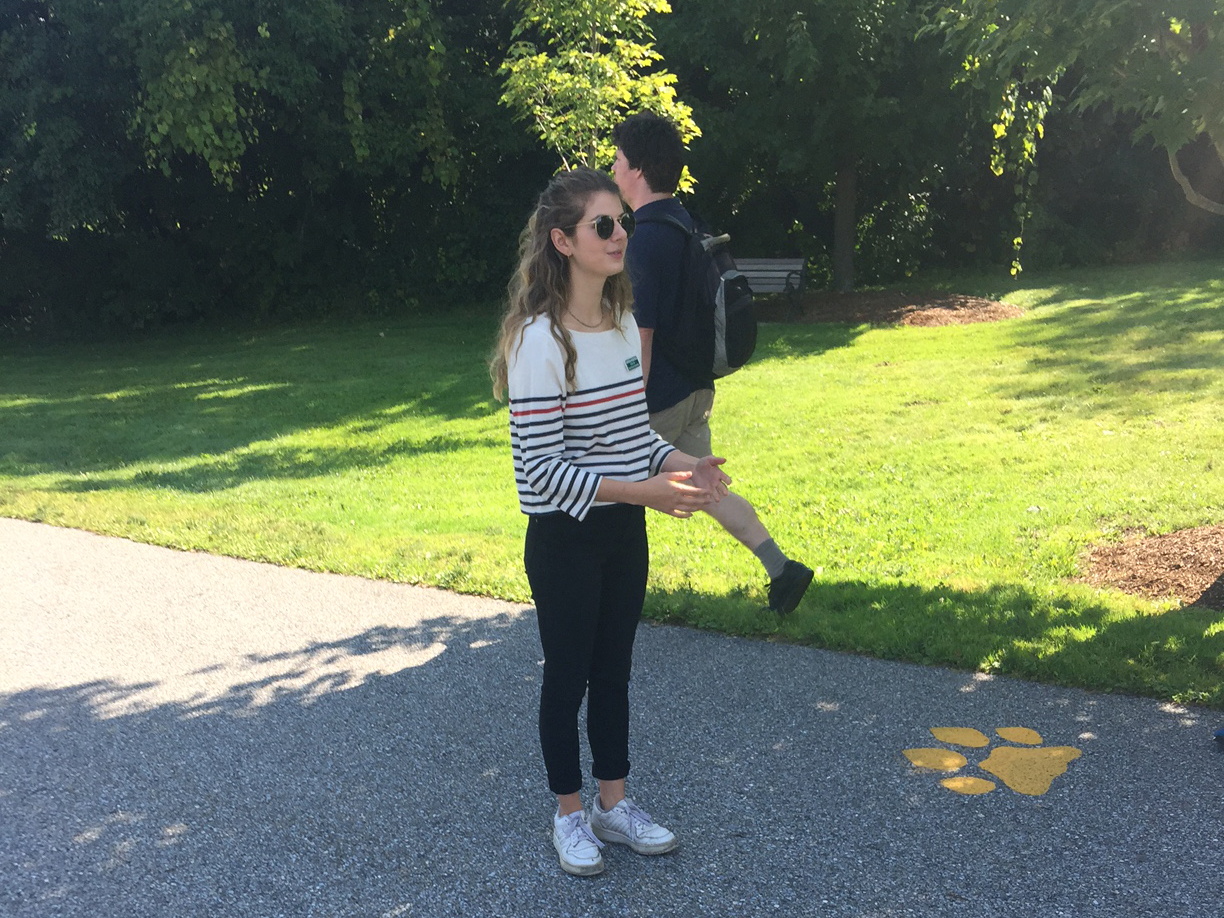


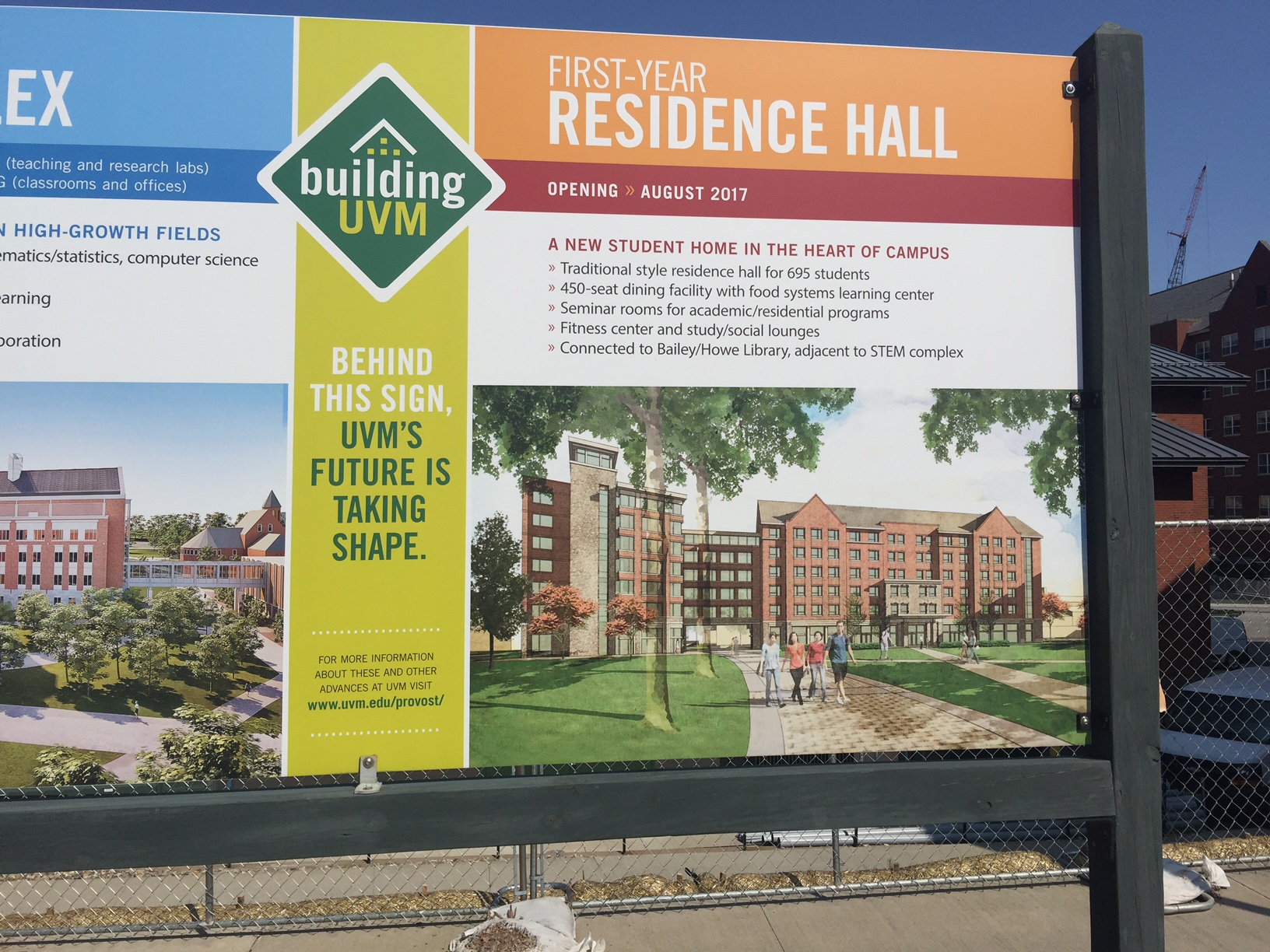
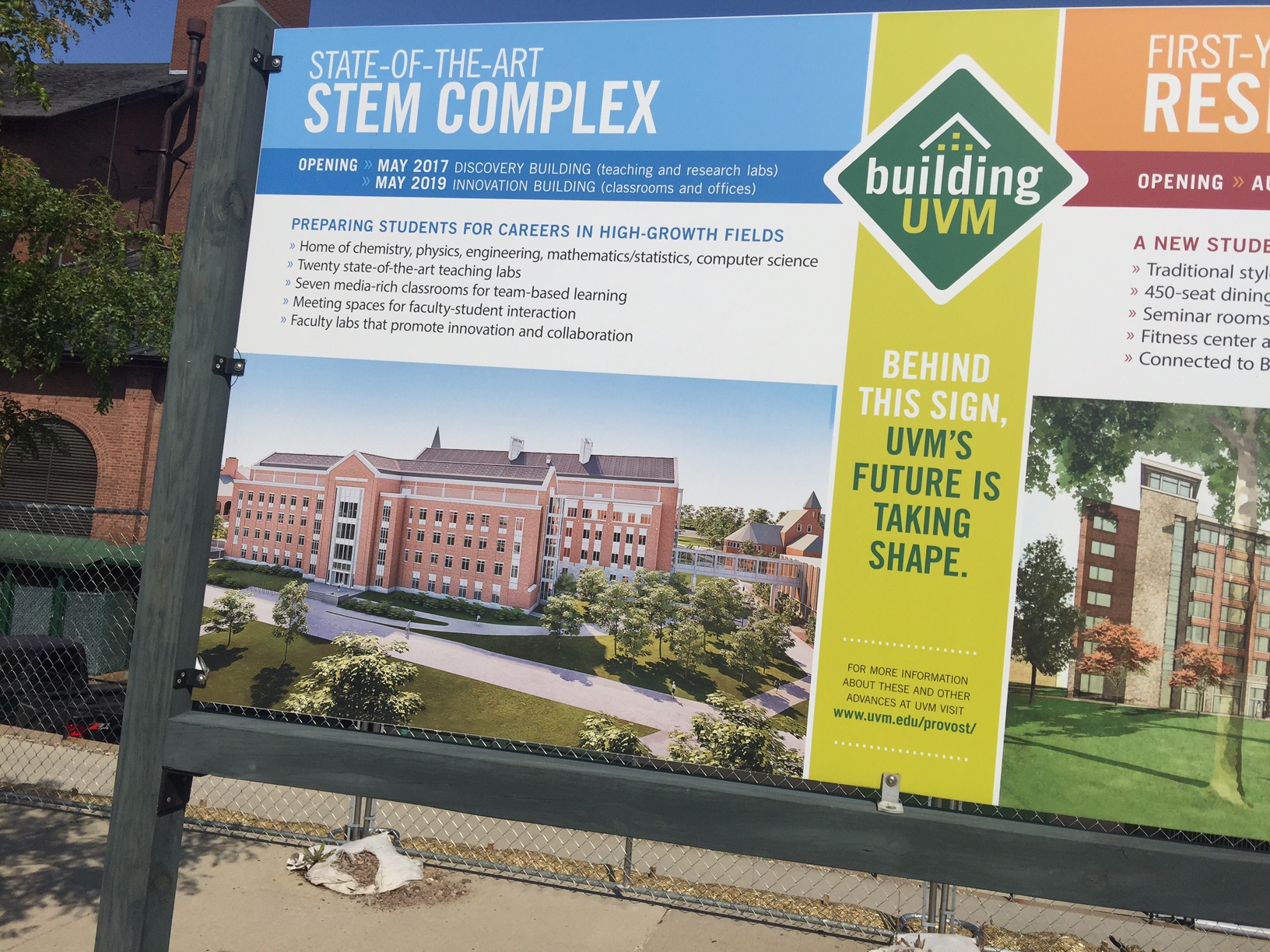
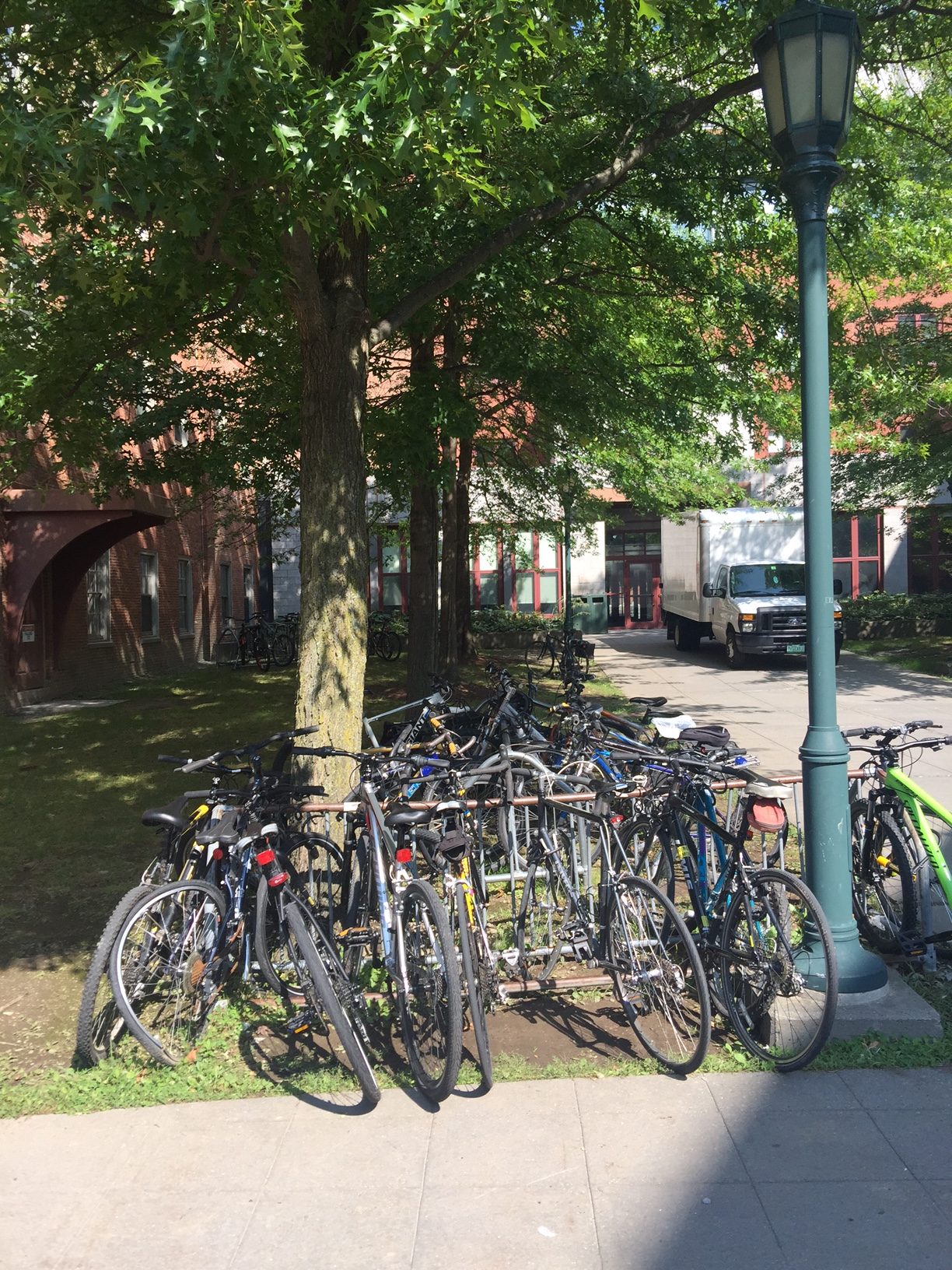
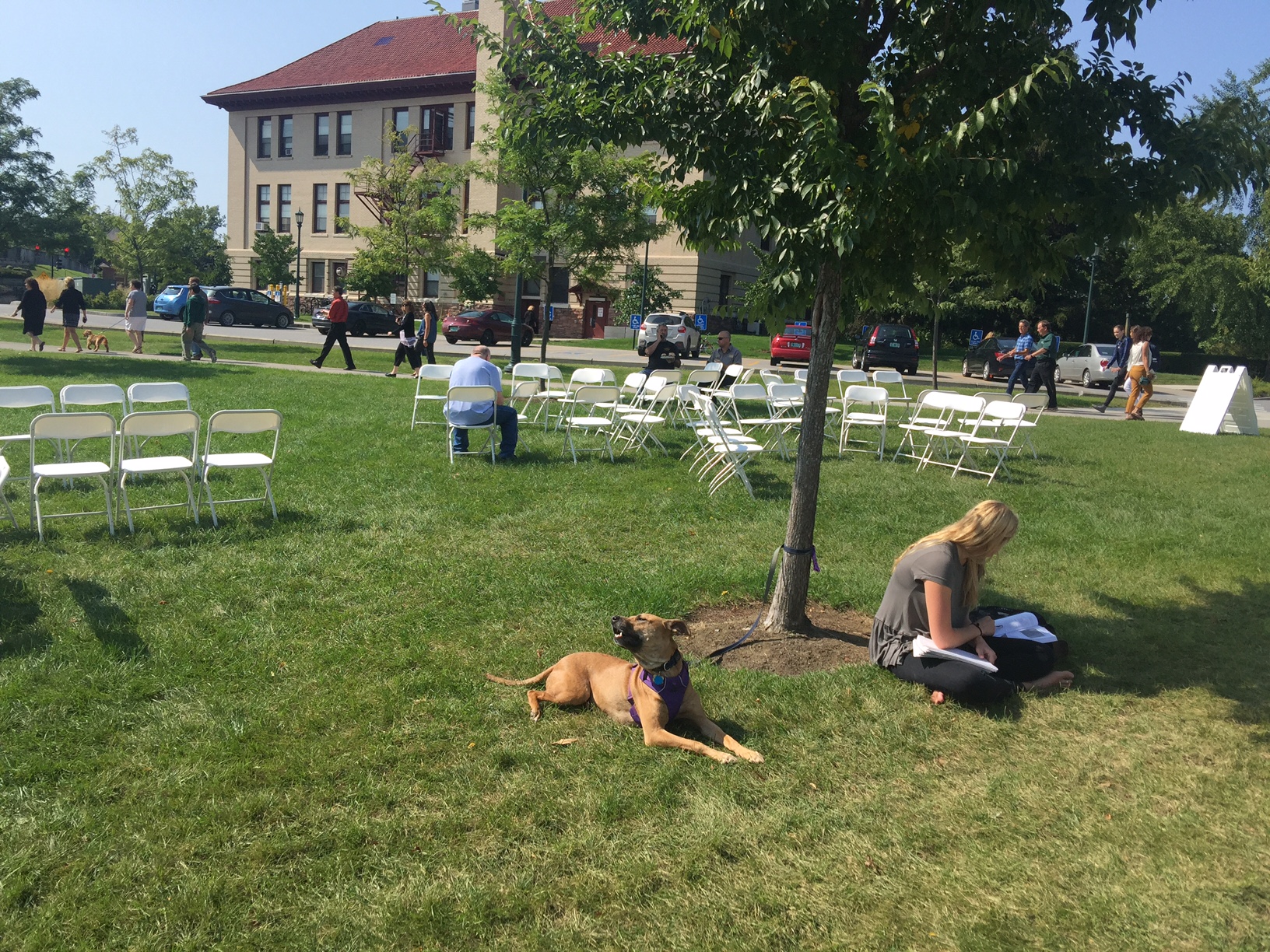

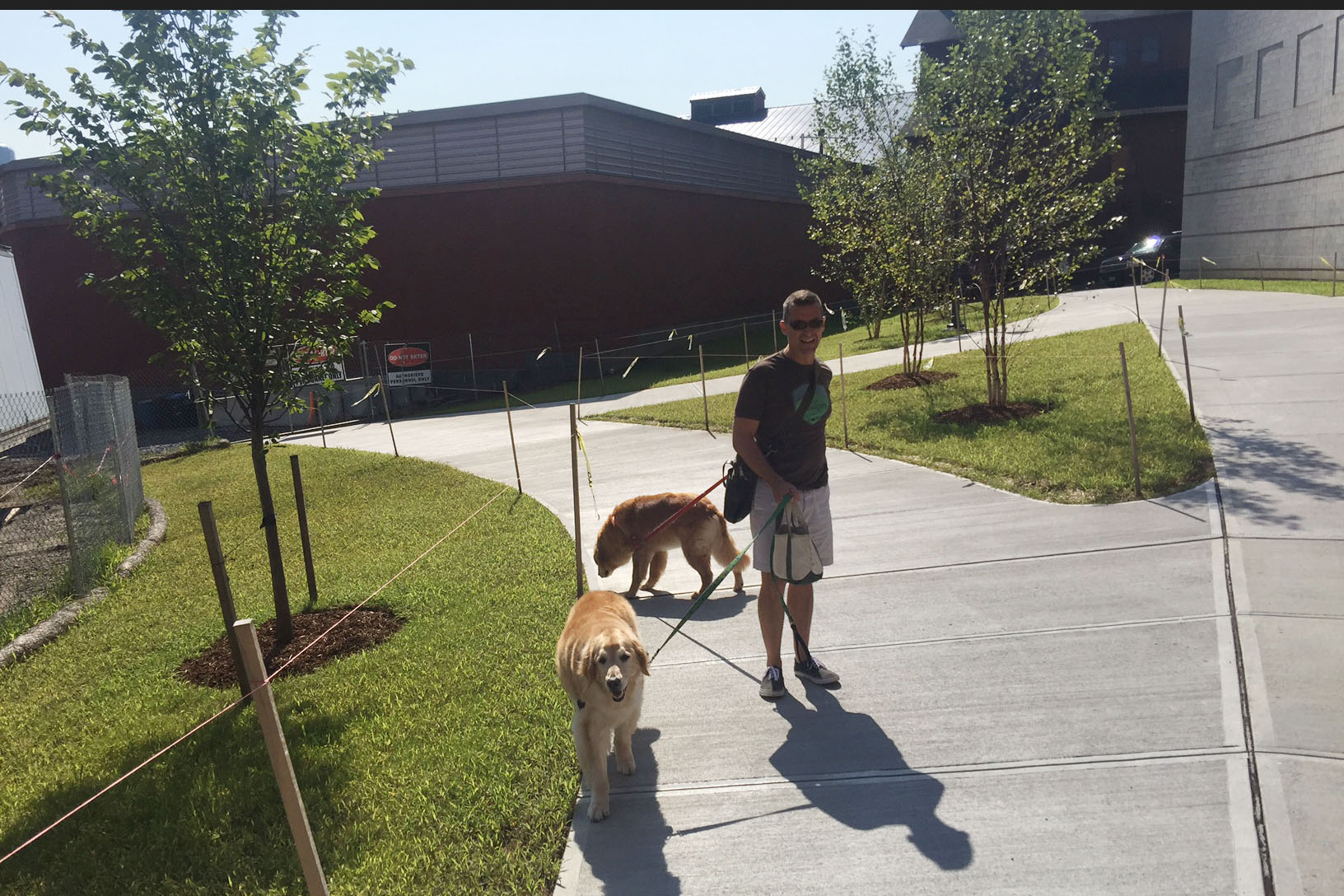
Farewell Class of 2017
Dear Students,
Many of you right now are preparing to embark on what will surely be one of the most profound and memorable chapters of your lives. College is still something that resonates with me and I know it will until I am old and losing my hair… actually just old!
Some of you may already be on campus experiencing a total mind-body eclipse- there is a ton to take in! I hope the big move-in, your classes, new roomies, dorm life, the food and this whole new world will be nothing short of epic.
No four-year college experience is the same, but there are some similarities that make it a shared experience for all of you 2017 graduates. You may have always lived in a world with emojis, cell phones and know Justin Timberlake as a solo act, but you are also future leaders, innovators, communicators and world changers. I will miss you all, but I hope this is not goodbye either.
I will leave you with my own high-school senior year photo from a long, long time ago along with some recent words of wisdom that I highlighted on the local news a couple days ago. They gave me about three minutes and I didn’t know the questions beforehand, but it touches on tips for your freshman year of college. Feel free to email or text me if you want me to elaborate on any freshman year tips.
Link to WCCO video: https://collegeexpertmn.com/2017/08/ryan-on-tv-expert-advice-for-freshman-college-students/
Yes, life will move very fast! I also want to also leave you with this simple promise: you will always have me as a college counselor. Please do not hesitate to contact me for advice, a pep talk, roommate drama, or to simply catch up. Like high school, college will be a constant roller coaster. It will not be a utopia of perfection, but what it can be is life affirming and life changing. You have your college destination- now go seize it.
Until we talk again, I wish you all the best and the brightest!
Congratulations,
Ryan Luse
EDUCATIONAL CONSULTANT, HECA & IECA PROFESSIONAL MEMBER
College Expert
(651) 888-2840 (office) (612)-695-6285 (cell)
Facebook | Linkedin | Twitter
5 things you absolutely shouldn’t bring to your college dorm
Read what Sue has to say on this CNBC article about preparing for college – “5 things you absolutely shouldn’t bring to your college dorm”

Congratulations to the Class of 2017
Dear Class of 2017,
Thank you for allowing us to be a part of your college planning journey. Congratulations and all the best as you go off to college. Please keep in touch and let us know how your freshman year goes. Enjoy the summer!
Sue, Ryan, and the College Expert Team
Reflections on the Class of 2017

The Class of 2017 embraced the application process with excitement, diligence, and flexibility. When the Common Application went live on August 1st, our students navigated the bumps and quirks and worked as a team to support one another. Being proactive, nearly 100% of students applied early decision, early action, priority, or rolling. In fact, we encouraged all students to submit their rolling admission applications by early October.
Drawing on vast knowledge and experience, the College Expert team recommended an eclectic mix of colleges, many of which were unfamiliar to our clients or which our clients would not have considered without a comprehensive discussion. One-hundred percent of our students (except for one gap-year student) will attend college in the fall, a number which showcases the importance of finding the best fit. We’re proud to unveil the Class of 2017 statistics:
- On average, each student submitted 9 applications
- 95% of students applied early action, early decision, priority, or rolling;
- 60% of students who applied early decision were accepted;
- 90% of students will attend out-of-state colleges (national average – 21%)
- 75% of students will attend private colleges
- 95% of students will attend a high interest or first choice colleges
Our Class of 2017 students will matriculate to colleges across the country, including Ivy League, engineering schools, out of the country, art schools, music conservatories, small liberal arts colleges, research universities, Big Ten schools, and colleges with in-state tuition. We strived to help families find ways to afford college tuition, and we were overjoyed with the resulting merit scholarships, grants, and aid.
We also experienced notable firsts, with students headed to Hillsdale, McGill, Mount Holyoke, Scripps, Drexel, Parsons, Colorado School of Mines, Washington State, St Ambrose, Vassar, St. Lawrence, and Wellesley. Stanford accepted three College Expert students, which was outstanding, considering the overall denial rate for Stanford was 96 percent
Our 2017 statistics reflect a stellar group of students who want to experience the world and build upon their knowledge. We were honored to prepare them for the next chapter in their lives. We thank you for making this year extraordinary and meaningful. We wish our seniors all the best with the journey ahead and hope to keep in touch.
Here is the list of colleges our students will be attending.
[ap_column_wrap]
[ap_column span=”3″]
- American University
- Boston College
- Brandeis University
- California Lutheran University
- Carleton College
- Carnegie Mellon University
- Claremont McKenna College
- Clemson University
- Colgate University
- Colorado School of Mines
- Colorado State University
- Columbia University
- Creighton University
- Dartmouth College
- Drexel University
- Elon University
- Fordham University
- Gettysburg College
- Grinnell College
- Gustavus Adolphus College
- Hillsdale College
- Hope College
- Illinois Wesleyan University
- Indiana University at Bloomington
- Iowa State University
- Kenyon College
- Lewis & Clark College
- Loyola Marymount University
- Loyola University Chicago
- Macalester College
- Marquette University
- McGill University
- Miami University, Oxford
- Middlebury College
- Montana State University, Bozeman
- Mount Holyoke College
- New York University
- North Dakota State University
- Northeastern University
- Northwestern University
- Occidental College
- Parsons
- Pepperdine University
- Princeton University
- Purdue University
- Rensselaer Polytechnic Institute
- Ripon College
- Rose-Hulman Institute of Technology
- Saint John’s University (MN)
- Scripps College
- Southern Methodist University
- St. Ambrose University
- St. Lawrence University
- St. Olaf College
- Stanford University
- Syracuse University
- Texas A&M University
- Texas Christian University
- The College of Wooster
- The University of Arizona
- The University of Tampa
- Trinity College
- Tulane University
- University of California, Berkeley
- University of Colorado at Boulder
- University of Denver
- University of Miami
- University of Michigan
- University of Minnesota, Twin Cities
- University of Wisconsin, Madison
- University of North Dakota
- University of Notre Dame
- University of Rochester
- University of San Diego
- University of Southern California
- University of St. Thomas
- University of Washington
- Vassar College
- Wake Forest University
- Washington State University
- Washington University in St. Louis
- Wellesley College
- Wheaton College, IL
- Winona State University
A Visit to University of Florida
About
The University of Florida (UF) is a public university located in Gainesville, Florida. Since its founding over 160 years ago, it has become one of the largest universities in the country with over 36,000 undergraduates. The university is known as the best state school in Florida and is consistently ranked among the nation’s top universities. In 2016, it ranked second among Forbes “Best Value Public Colleges,” and in 2015, it ranked second in Kiplinger’s “Best Values in Public Colleges.” As a result, the admissions process has become highly selective.
I visited the University of Florida on a rainy, windy day, which is atypical weather for this warm and sunny campus. Admissions graciously provided us with ponchos as they guided us through the two-hour tour.
Location
Gainesville is the county seat and largest city in Alachua County, with a population around 128,000 people. In the 2007 edition of Cities Ranked and Rated, Gainesville was named as the No. 1 place to live in North America. That same year, National Geographic Adventure ranked it as one of the best places to live and play. The University of Florida is accessible from several airports—the closest is in Gainesville (a 15-minute drive from campus), while airports in Jacksonville, Orlando, and Tampa are all an easy two-hour drive from campus. Over the past several decades, Gainesville has undertaken a large historic preservation initiative that has resulted in multiple buildings being added to the National Register of Historic Places. Among these is Gainesville’s cultural hub, the Thomas Center, which contains art galleries, local history exhibits, performance space, and the surrounding Thomas Center Gardens. The sport of auto racing is a prime focal point for area sports fans.
Academics
The University of Florida is home to 30 certificates, 100 undergraduate majors, and 200 graduate programs. While UF is known to have strong academic standards across the board, programs in Business and Journalism are ranked particularly high. The Psychology and Biology programs are also well renowned. Though UF is a large school, students feel that its size doesn’t affect their ability to focus on their course of study. Some may see it as a disadvantage that 80–90 percent of classes are lectures with over 300 students, but students at UF love the fact that their classes are taught by experts in their field. Students praise the “truly incredible faculty and staff” and believe that a great strength of the school is that there is always someone to turn to for help. Another advantage to a large school is that there is more funding available for research, opening endless opportunities for focused study. The school also maintains a broad alumni network, which is beneficial when students seek opportunities for networking and research.
Over 1,200 UF students participate in the Honors Program, where most classes are limited to 25 or fewer students. The Freshmen Honors Program (FHP) is open to high school seniors, and the University Honors Program (UHP) is open to sophomores through seniors. Members of FHP automatically advance to UHP after successful completion of the first year, but students do not have to be in FHP to join UHP.
Student Life
Because Gainesville revolves around UF, Gator Nation can be found everywhere. The community caters to students and student life. Students love to go out with friends on the weekend to Midtown, where bars and the vibrant music scene are big attractions. For those over 21, it is a UF staple to party at either Grog House Bar and Grill, Balls, or Salty Dog Saloon.
Ranking high on the list of what students love about UF is the abundance of school spirit. Much of the culture at UF revolves around sports, and the school boasts stellar athletic programs. Ben Hill Griffin Stadium, also known as “The Swamp,” is widely recognized as one of the toughest environments for a visiting team in all of college football.
With more than 1,000 student organizations on campus, there is something for everyone to be involved in at UF. Greek life is also prevalent in both the social and extracurricular scene, and being part of a Greek community offers additional opportunities to participate in activities. For outdoor enthusiasts, there are two state parks nearby: Paynes Prairie and Devil’s Millhopper.
While the opportunity is there to party every day, students also find plenty of quiet time to study. When it comes to exams, papers, and finals, students dig in and get to work. The classes are demanding, but students understand this is necessary to best prepare them for their career.
Housing and Dining
More than 80 percent of incoming freshmen at UF live in one of 26 on-campus housing options. Many of these buildings house one of 19 Living Learning Communities (LLCs). Hume Hall is home to the Honors Residential College. Students are encouraged to apply for housing even before they’ve been accepted to UF to have the best chance of being placed in their preferred spot. Seventy-six percent of upperclassmen choose to live off campus.
Gator Dining Services is the official food service provider for UF. They offer over 45 dining locations on campus, including favorite national brands like Subway, Chick-fil-A, and Starbucks. Students choose between two types of meal plans: Meal Plans and the Declining Balance Account.
Who Would Be Happy Here?
Outgoing Minnesota students in search of a large public institution in a warmer climate would enjoy the University of Florida. Given that a high percentage of students are residents of Florida, students from out-of-state need to be willing to step outside their comfort zone to meet new people. The University of Florida would be great for someone looking for a breadth of opportunities at a value price.
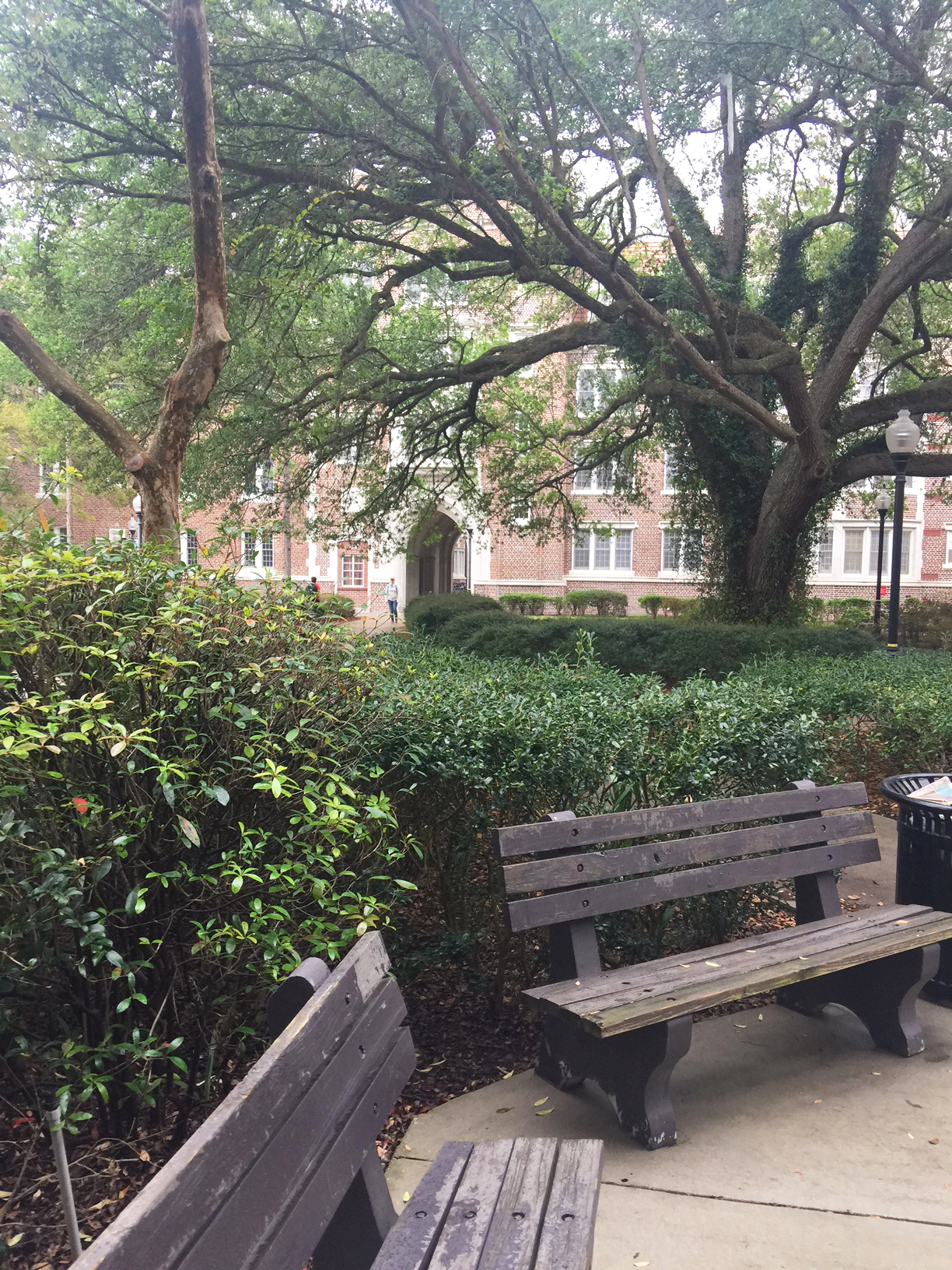
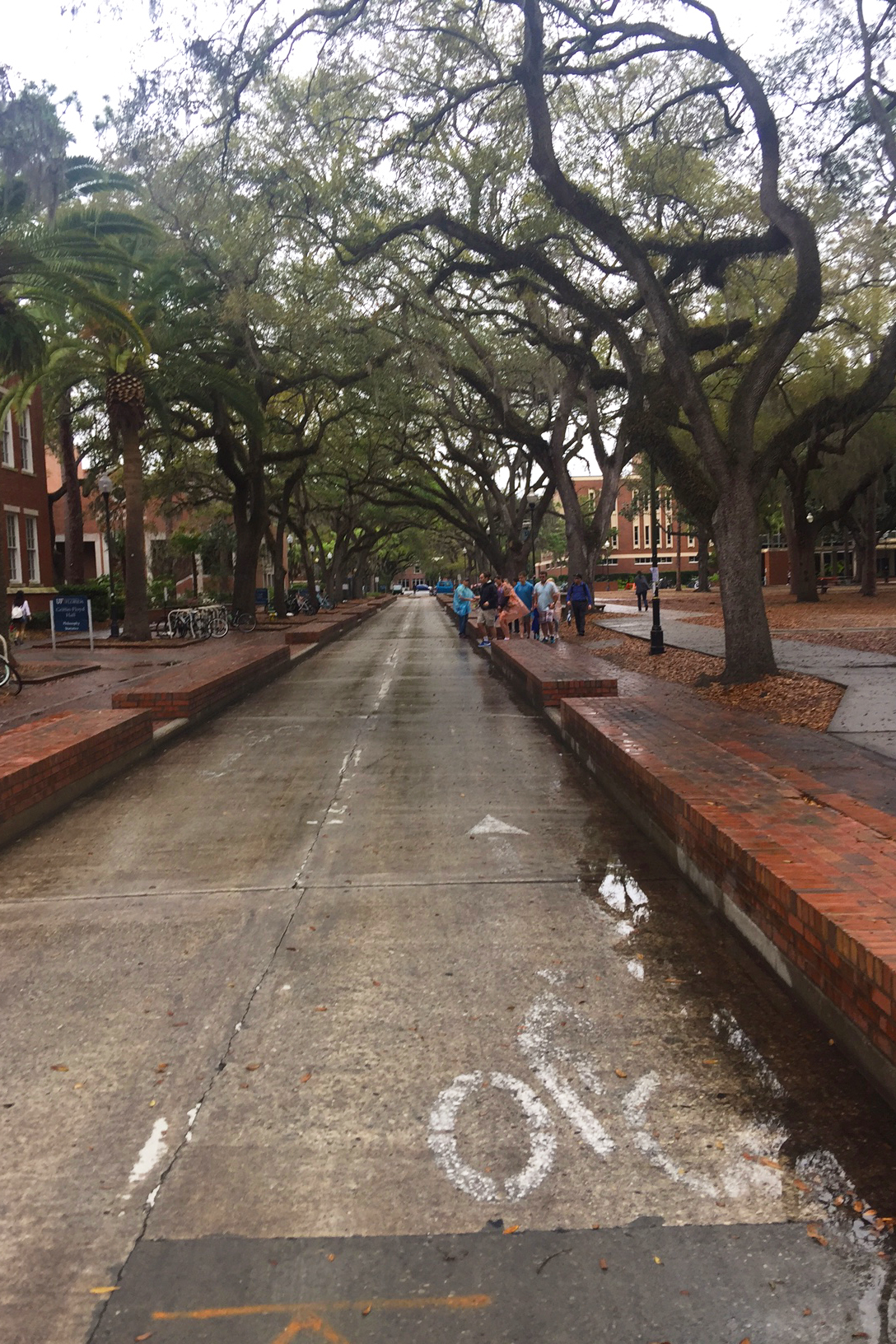
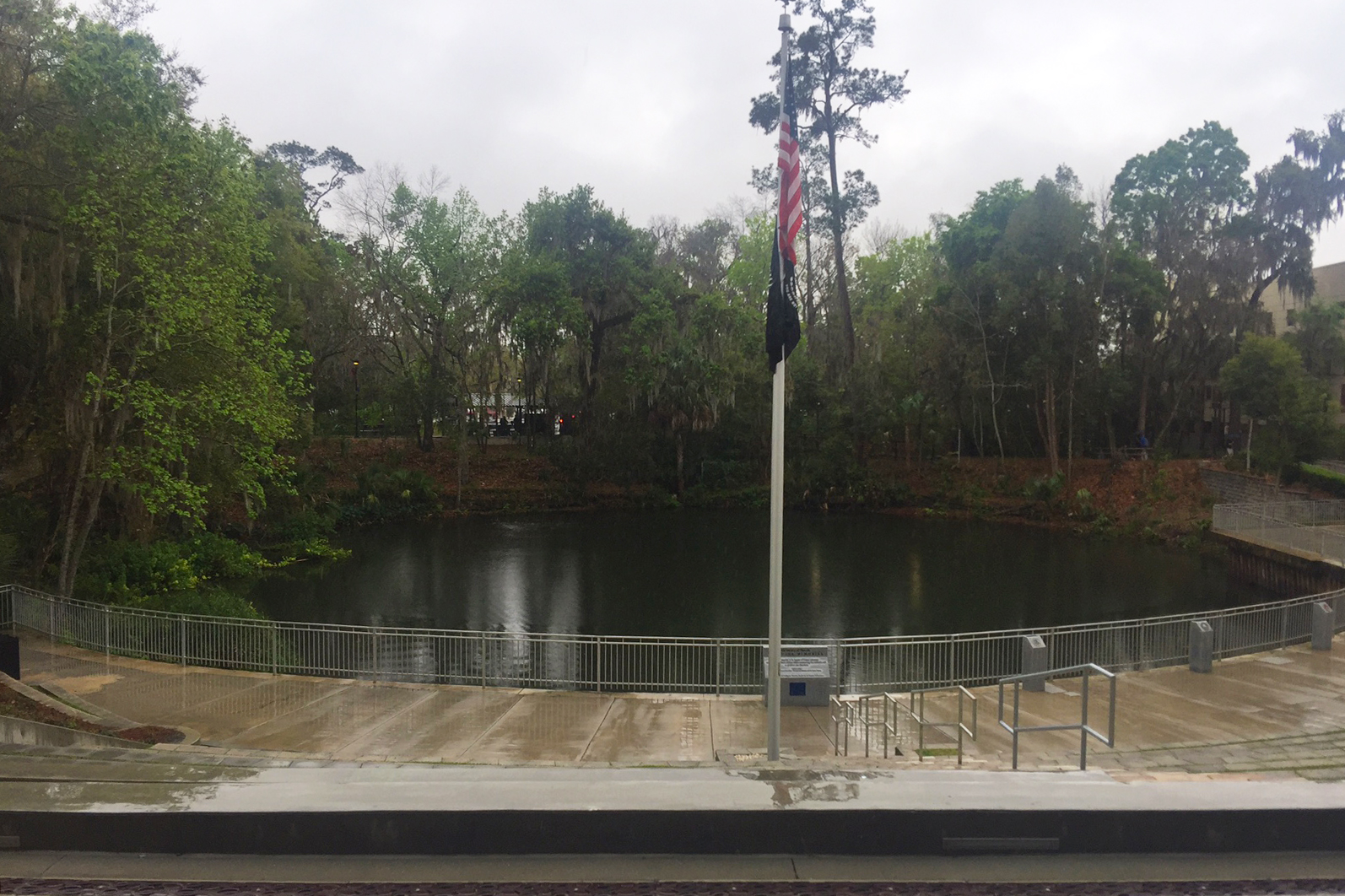
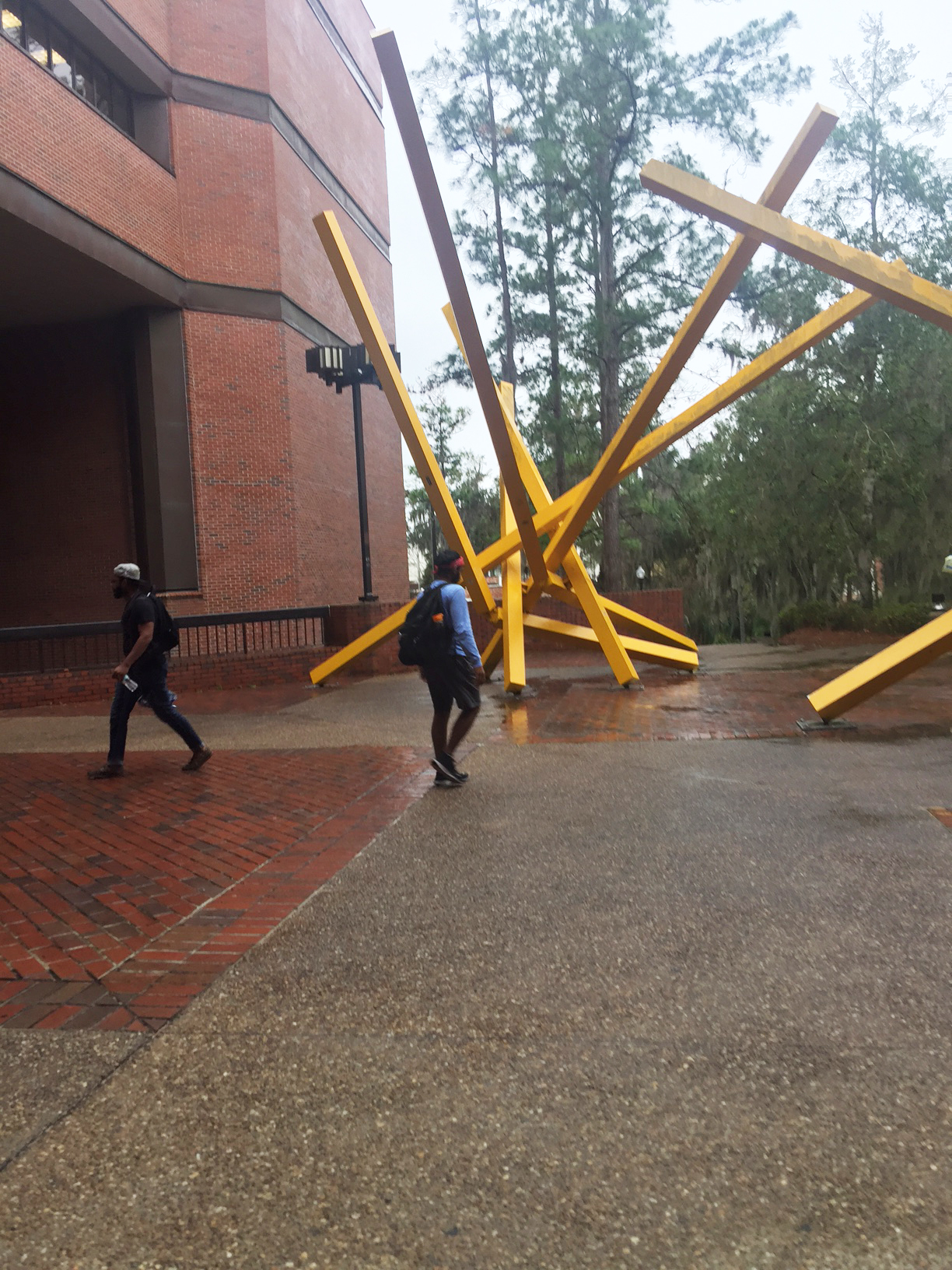

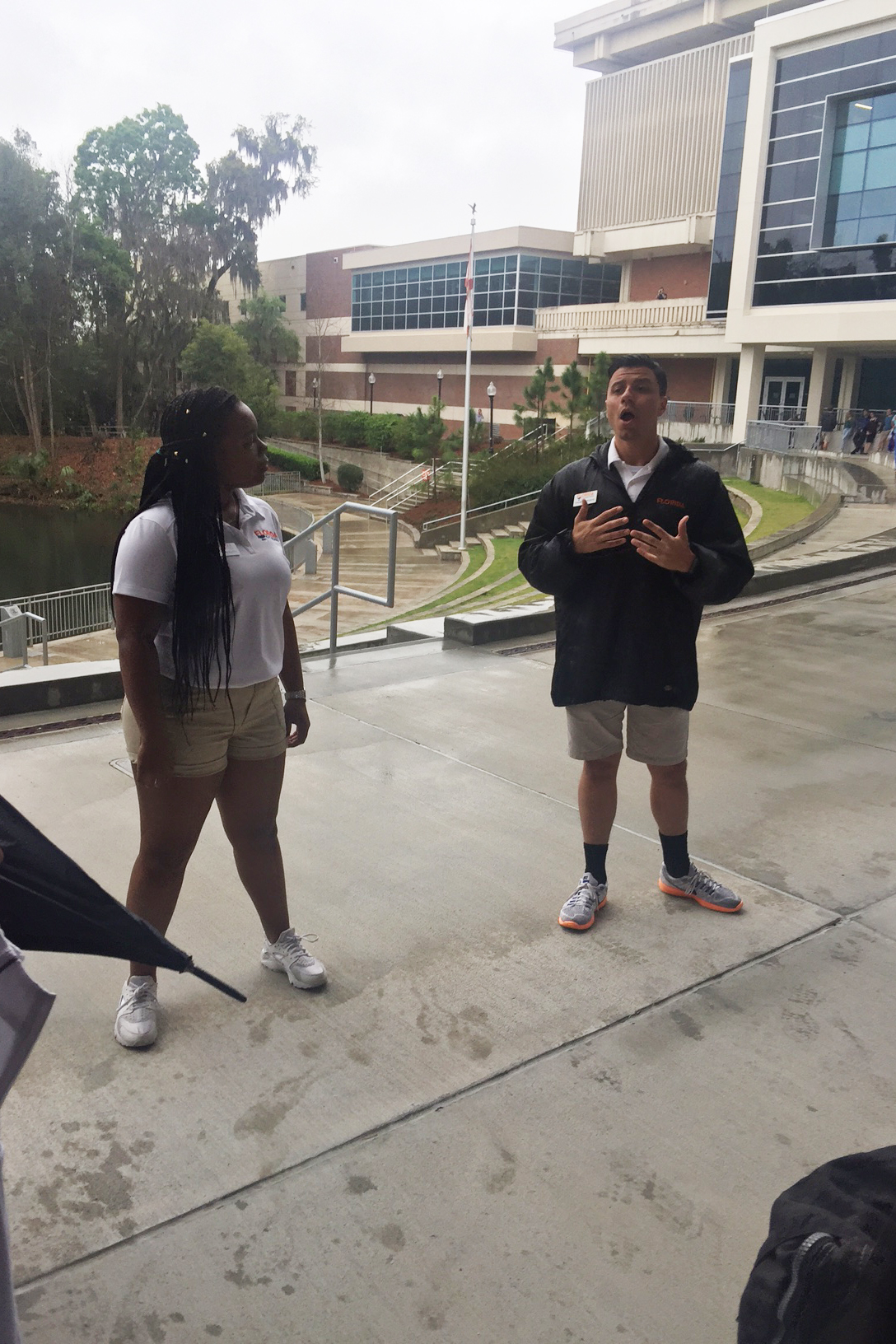
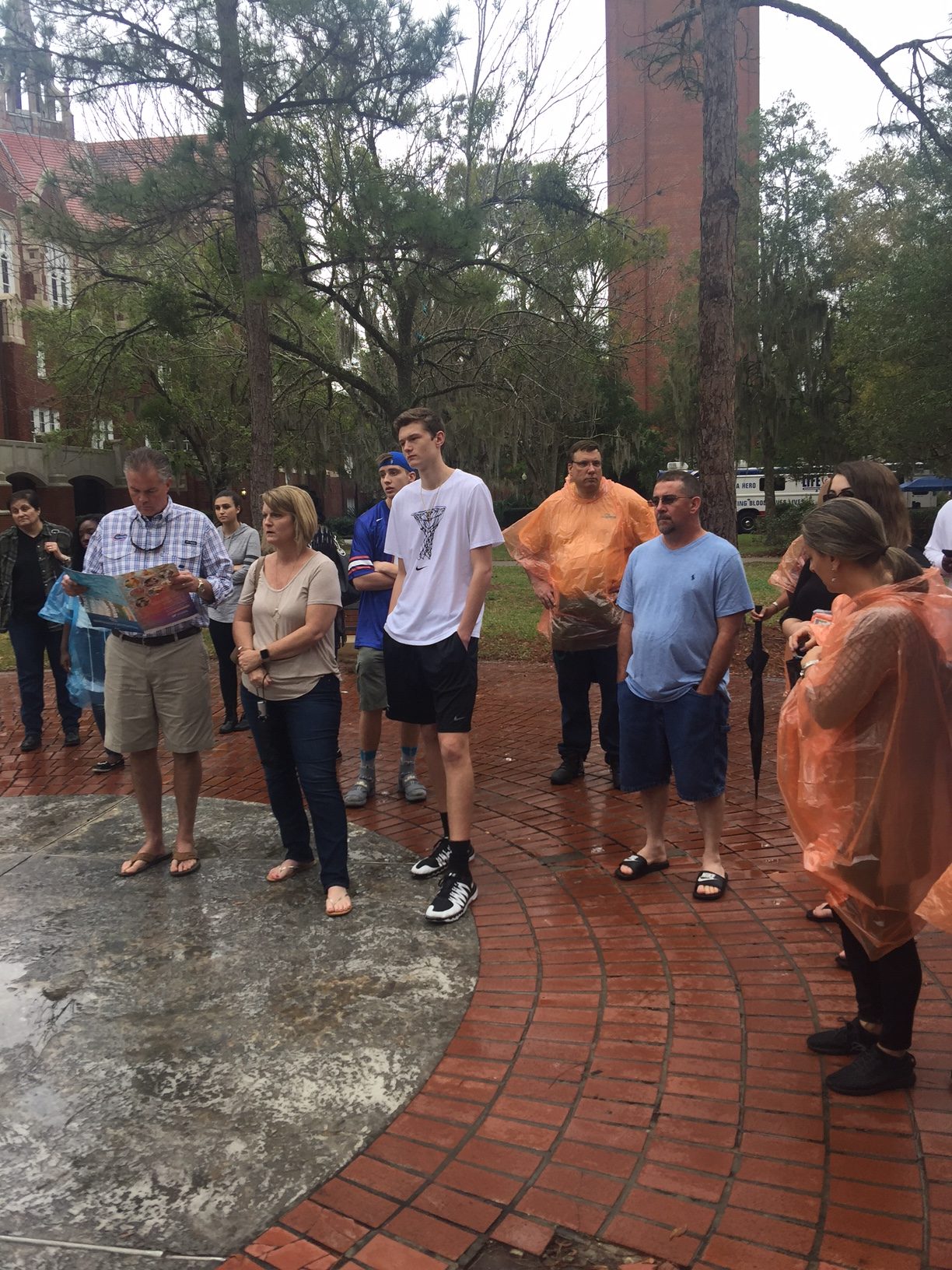
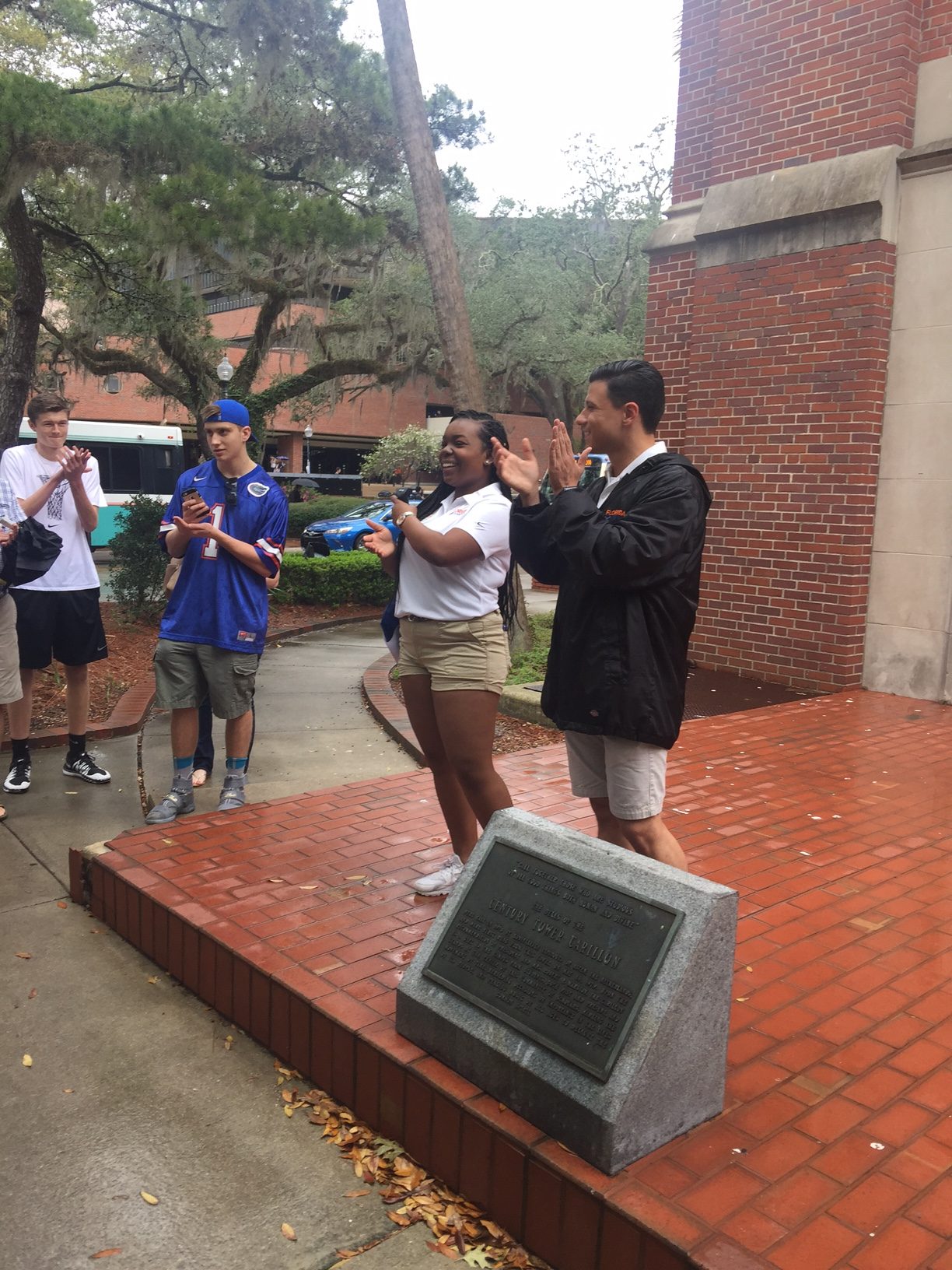
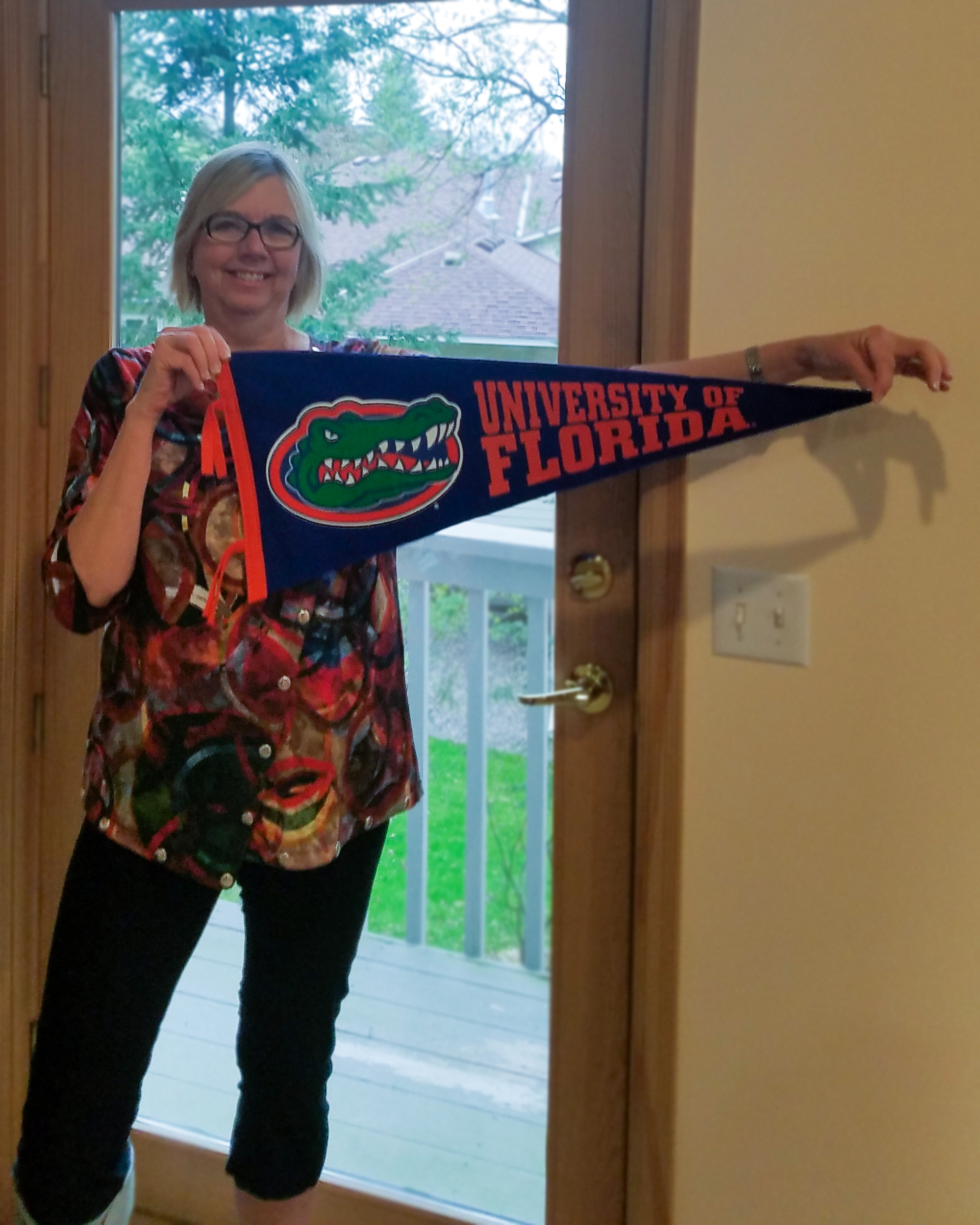
Ryan Luse in Star Tribune
Ryan Luse is in the news! Gail Rosenblum interviewed Ryan for the Star Tribune article Rosenblum: How to turn college rejection into a lucky break. You can read the online edition or read it in the April 16, 2017, Sunday print edition.

Link to Star Tribune photo. Nick Lemieux, 19, of Eagan, had his heart set on Columbia University, which rejected him. NYU has turned out great.
Sue on KARE 11
Sue was on KARE 11! She was interviewed by Pat Evans on KARE 11 News at 4pm. The topic was about helping students choose the right college. High school seniors are faced with college decisions this time of the year. Sue gave advice to both students and parents.
You can watch the interview by clicking here.
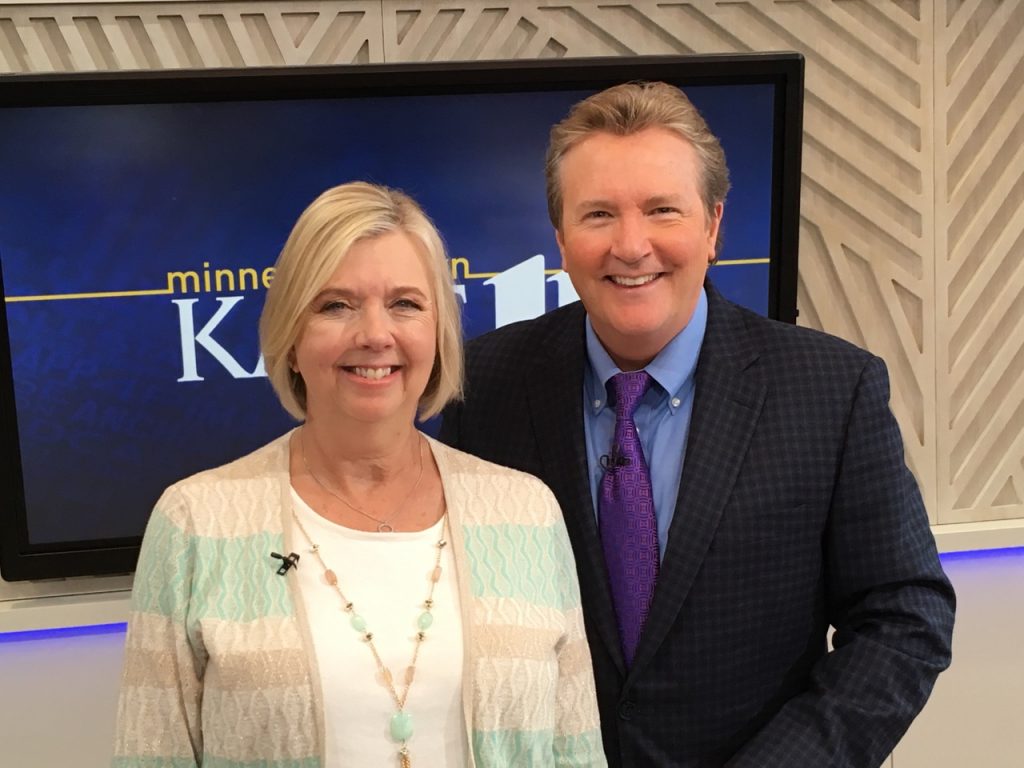
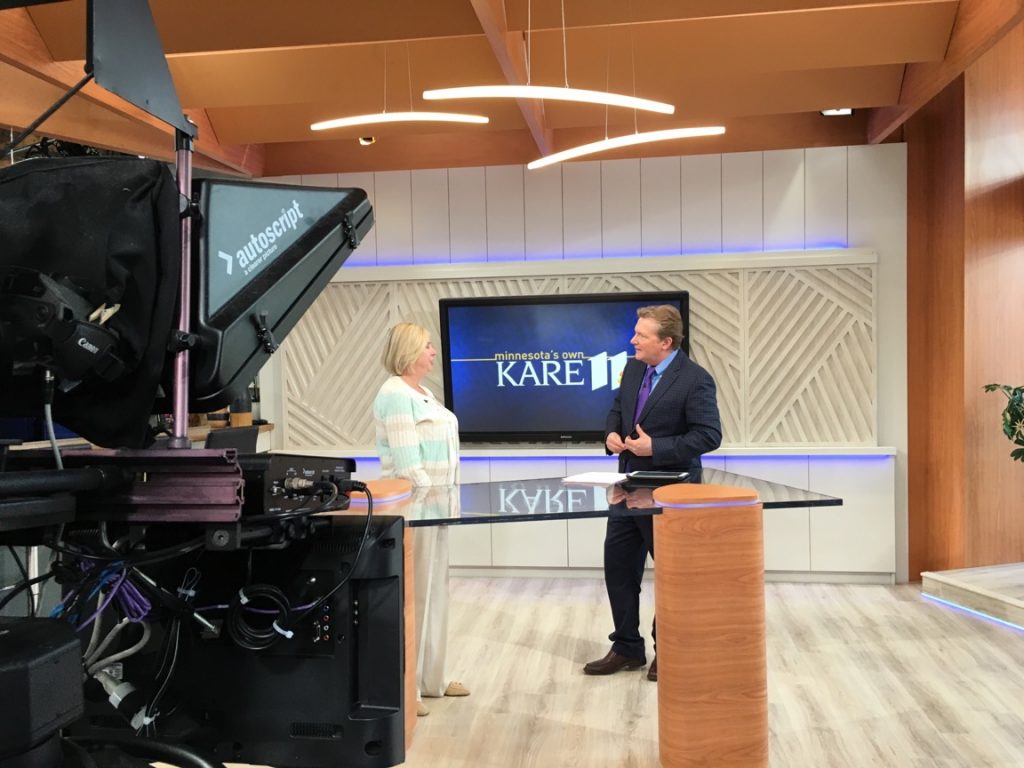
College Spotlight on University of San Diego
Considering a college near the beach in Southern California? Think University of San Diego. Read about Theresa’s freshman year at University of San Diego.
A Visit to Hampshire College
About
“Disrupt the status quo.” These are the words of the Hampshire College website. Since deciding not to accept SAT and ACT scores, Hampshire is nowhere to be found on the U.S. News and World Report “Best Colleges” list—and the trailblazing community takes pride in that fact. The researchers who compile the “Best Colleges” list simply don’t know how to deal with the institution’s forward-thinking practices. The college is known for its entrepreneurial student body and alumni, ranking sixth on Forbes list of “Most Entrepreneurial Colleges” in 2015. Led by the dynamic and sometimes controversial Jonathan Lash, an expert on global sustainability, climate change, and development challenges, Hampshire defies categorization.
Location
At first glance, the Hampshire campus appears to be a well-maintained ranch with spread-out buildings and lush green spaces. Located in the Pioneer Valley of western Massachusetts, a scenic 90 miles from Boston, the Town of Amherst (population 35,000) is a hilly, picture-perfect setting for locally-owned shops and specialty dining. The Town Common stretches for several blocks along Boltwood and Pleasant Avenues. During Daffodil Days, over 50,000 daffodil bulbs show their stuff in the Town Common, and talented local artists decorate the sidewalks with daffodil-themed murals. Judie Teraspulsky, owner of Judie’s Restaurant in downtown Amherst, is known for her delightful popover creations, including the Gumbo Popover and Turkey “Pop” Pie. One of the most popular places to stay overnight is The Lord Jeffery Inn, affectionately called “The Jeff.” Facing the Town Common and only a five-minute drive from Hampshire College, the upscale inn uses geothermal heating and water-efficient landscaping.
Academics
Hampshire admitted its first students in 1970 in response to a $6 million donation from Amherst College alumnus Harold F. Johnson. With a matching grant from the Ford Foundation, Hampshire’s trustees purchased 800 acres of orchard and farmland. However, the original idea for Hampshire took root back in 1956, when a committee of presidents from Amherst, Mount Holyoke, and Smith Colleges, and the University of Massachusetts at Amherst, examined the assumptions behind a liberal arts education. Their report, “The New College Plan,” advocated many features that have since been incorporated into the Hampshire experience: an emphasis on curiosity and motivation; multidisciplinary learning; and close mentoring relationships with professors.
Majors (and a traditional grading system) do not exist at Hampshire. Instead, students chart their own “concentrations” through a divisional system: Division I – first year; Division II – second and third years; and Division III – fourth year. Division I is about bridging subjects across five interdisciplinary schools: Cognitive Science; Critical Social Inquiry; Humanities, Arts, and Cultural Studies; Interdisciplinary Arts; and Natural Science. During the Division II years, students identify and explore their concentrations through individually-designed programs consisting of course work, independent work, and internships or field studies. Students work closely with at least two personally-selected faculty members to design a concentration. A concentration may mimic a traditional college major or be a highly-individualized program of study that encompasses several disciplines. A crucial piece of the Division II years is the Community Engagement and Learning requirement (CEL-2); forty hours are required. Division III revolves around an advanced independent study project. According to the Hampshire website, Division III is a student’s “chance to make a change,” whether that involves the launch of a start-up, the construction and programming of a robot, or the creation of a choreographed dance performance. The sky’s the limit.
As a member of the Five College Consortium (Hampshire, Amherst, Smith, Mount Holyoke, and University of Massachusetts at Amherst), Hampshire students have access to 6,000 courses, eleven museums, and a library system with 11 million items. Hampshire academic advisors are highly-knowledgeable about the offerings at all five colleges. In fact, ninety-five percent of Hampshire students take at least six classes at the other schools during their undergraduate years. The Consortium schools operate on the same academic calendar with free bus shuttles. Hampshire students are welcomed with open arms.
Student Life
The Hampshire student body is composed of 1,400 “community leaders and builders” who are “naturally empathetic” and “demand authenticity.” Don’t be surprised if your student tour guide sports dreadlocks and harbors a passion for bicycle maintenance! Interesting student groups range from the Glass Collective to Circus Folks Unite! to Wool People. The Prescott Tavern is a central meeting place with late-night study spaces and recreational activities such as foosball, pool, and board games. The tavern is home to the TavernArt gallery, a fabulous student gallery on campus.
The R.W. Kern Center is a symbol of the Hampshire community’s values and ideas. The first major new building in three decades, it was constructed with the Living Building Challenge in mind: to generate its own electricity, collect its own water, avoid toxic “red list” chemicals, and use materials primarily from local and regional sources. The 17,000-sq-ft center is a major piece of Hampshire’s sustainability initiative to make campus operations carbon neutral, including a plan to go 100 percent solar for campus electricity. The multifunctional building serves as a living laboratory, where students and the public study its systems and performance, tied to measures for sustainability.
Housing and Dining
Hampshire strives to create residential environments that are the most conducive to learning for each individual student. The college also facilitates a process for students to form living communities based on habits, commitment to a substance-free lifestyle, common learning goals, social identities, or medical needs.
Hampshire invites incoming first-year students to participate in specific living and learning communities as a means to find their own niches on campus: Body, Brain, and Culture; Community Engagement for Social Change; Environmental Justice and Sustainability; FARM!; Looking/Reading/Writing; and Wellness. FARM! is an interdisciplinary, co-curricular living learning community focused on food production, environmental justice, and sustainable agriculture. Co-sponsored by the Hampshire College Farm, the community follows food from seed to table. Students learn about organic vegetable production and sustainable animal husbandry through farm work and other on-farm research opportunities. Activities may include a film series, guest speakers, cooking classes with seasonal vegetables, hyper-local meats, and local dairy products, and engagement with the local agricultural community.
Since fall of 2013, Hampshire’s food service provider, Bon Appétit Management Co., has built menus around products harvested on the farm. On campus, the movement is referred to as the “Healthy Food Transition.” The 800-acre campus offers ample room for growth beyond the current 15 acres of vegetables that support a thriving Community Supported Agriculture program. President Lash, an environmentalist concerned with the global capacity to produce food, asks, “How will we feed 9 billion people in a warming world?” Lash spelled out his vision for Hampshire as a transformative institution during his inauguration speech in 2012. Al Gore delivered the keynote speech at that event. Gary Hirshberg, a Hampshire graduate and co-founder of the world’s leading organic yogurt-maker, Stonyfield Farm, offered a sizable gift to support that vision.
Admissions
Hampshire is a proud member of the non-profit organization, Colleges that Change Lives. Without the submission of ACT and SAT scores (they’re not even optional!), each application is reviewed for a growth-oriented mindset, an ability to see connections, and intellectual bravery. The admissions committee focuses on academic records, history of civic engagement, letters of recommendation, and essay responses. Sixty-one percent of Hampshire applicants receive offers of admission. Hampshire’s website facetiously states, “Students must be at least 17 years of age by the time they arrive on Hampshire’s campus for orientation. Any younger students should wait until they would meet this age requirement to apply. The use of aging potions is strictly prohibited.” Hampshire is ranked in the top 1% of all colleges and universities in the nation for the number of graduates who go on to earn a doctorate degree.
Who Would Be Happy Here?
Non-conformists—high school seniors and college transfer students—gravitate to Hampshire. The college appeals to those who want to be entrepreneurs of their own education. Hampshire is one of the most liberal colleges in the U.S. and attracts smart, quirky students who prefer small group poetry discussions over sports or Greek life.
A Visit to Providence College
About
Providence College (PC) is a Catholic university of the Dominican tradition located two miles from downtown. The campus buildings are lovingly maintained, as are the plentiful green spaces. With an active, 100-year presence of robed friars on campus, it’s not surprising an ongoing discussion about human existence – including life’s meaning and purpose – is of central importance during the undergraduate years. There are approximately 4,000 undergraduate students with the majority from out of state, particularly New England. The campus exudes a small college vibe combined with big university athletics and opportunities, particularly in professor-led research.
Location
Providence is the capital of Rhode Island and the perfect college town located about 40 minutes from Boston. The PC campus is a short, fifteen-minute car ride from the beach and only 40 minutes to historic Newport. Diverse and historic, bicycle-friendly, and easy to explore by foot, Providence is an active center of art, culture, education, and politics. Waterplace Park is the backdrop for the WaterFire art installation, which lights up the surrounding tidal basin most nights in the summer and for special events. The influence of the nearby Johnson and Wales College of Culinary Arts is evident, with Providence boasting numerous outstanding restaurants and the highest number of degreed chefs per capita than any other U.S. city. Providence is easy to navigate and full of friendly, helpful people.
Academics
PC is known for small classes taught only by professors. The nine mission-related goals of the Core Curriculum are a reflection of a Catholic and Dominican intellectual tradition which emphasizes the study of philosophy, theology, and development of Western civilization. Admitted students have 49 majors from which to choose. Unique programs include a combined 3+4 optometry degree in conjunction with the New England College of Optometry and a combined 3+2 engineering degree in conjunction with Columbia University or Washington University in St. Louis. Other particularly strong programs are biology, special education, business, and health policy and management. A major or minor in public and community service studies is rooted in a pedagogical approach to learning, with each course requiring two to four hours a week of hands-on service; the service component acts as the “text” and a jumping point for classroom discussion and reflection.
For more than 50 years, PC has invited a select group of students, currently 130 or so per graduating class, to participate in the rigorous Liberal Arts Honors Program. Most chosen candidates score between a 34 and 36 on the ACT exam and carry a 4.0 GPA. Honors students are fully integrated into residence life. However, they come together one to two times per week to take specialty seminars. Honors students receive merit-based scholarships ranging from 40 percent of full tuition to full tuition.
Student Life
PC is not a commuter college. Sixty-five percent of students are Catholic, 20 percent are minorities, and 12 percent are the first generation to attend college. While freshmen live in all-male or all-female dorms, coed options exist for upper class students. Most PC students are preppy in a typical Northeastern style (Sperrys, Uggs, and The North Face) and accepting of others but not into alternative lifestyles. The students work and play hard, although an overwhelming sense of competition does not exist. Community service is the cornerstone of the four-year PC undergraduate experience. The varsity sports teams, which are Division I, are known as the Providence Friars. Cheering on the varsity hockey team is a favorite pastime.
Admission
The admission process at PC is highly selective. For the Class of 2020, just under 11,000 students applied for approximately 1,000 spaces. Merit scholarships go to 25 percent of admitted students, and overall, 70 percent receive some type of aid, whether merit or financial. In terms of applicant overlap, students who apply to Providence College are also likely to apply to Villanova University, Fairfield University, and Boston College. To encourage student diversity, for the past 10 years, PC has offered “test optional” admittance. Interested students apply via the Common Application; there are no supplemental essays beyond the required 650-word personal essay.
Who Would Be Happy Here?
The Twin Cities boasts a PC alumni network that’s 600-people strong. Sixty percent of PC students are from the Northeast, and overall, 91 percent are from out of state. Catholics and all faiths are welcome at Providence. The internship and job placement programs are outstanding. Hasbro, Textron, and CVS – all based in Rhode Island – actively recruit PC interns. Students have the option to take one extra class at no charge to be used for an internship.
A Visit to Amherst College
About
A top-ranked, private liberal arts institution, nestled amongst quaint New England villages, Amherst College is the site of several historic “firsts”: the world’s first intercollegiate baseball game, the country’s first collegiate athletics program, and the nation’s first undergraduate neuroscience program. The 1,800 friendly and intelligent Amherst undergraduates reflect a commitment to geographic, socioeconomic, racial, and ethnic diversity. The institution’s motto is Terras Irradient, meaning “Let them give light to the world.” The jewel of the Amherst campus is a 500-acre Wildlife Sanctuary composed of open fields, wetlands, flood plain woods, a river, upland woods, plantation pines, and ponds.
Location
Located in the Pioneer Valley of western Massachusetts, a scenic 90 miles from Boston, the Town of Amherst (population 35,000) is a hilly, picture-perfect setting for locally-owned shops and specialty dining. The Town Common stretches for several blocks along Boltwood and Pleasant Avenues. During Daffodil Days, over 50,000 daffodil bulbs show their stuff in the Town Common, and talented local artists decorate the sidewalks with daffodil-themed murals. Judie Teraspulsky, owner of Judie’s Restaurant in downtown Amherst, is known for her delightful popover creations, including the Gumbo Popover and Turkey “Pop” Pie. One of the most popular places to stay overnight is The Lord Jeffery Inn, affectionately called “The Jeff.” Facing the Town Common and only a four-minute walk from Amherst College, the upscale inn uses geothermal heating and water-efficient landscaping.
Academics
Amherst’s open curriculum means all classrooms are filled with inquisitive, engaged students – who freely create interdisciplinary majors or double major across disciplines, such as math and music or physics and philosophy. Amherst professors are committed to teaching and mentoring, and each faculty advisor has only six to seven assigned students. As a member of the Five College Consortium (Amherst, Hampshire, Smith, Mount Holyoke, and University of Massachusetts at Amherst), students have access to 6,000 courses, eleven museums, and a library system with 11 million items. Senior theses are not required, but still, over 50 percent of inquisitive Amherst students pursue the option.
While Amherst does not offer an engineering major, students are able to participate in a 3/2 dual degree program at Dartmouth College. However, future engineers should be prepared to spend an extra year obtaining a degree which could be secured in four years at a more traditional engineering school.
A popular freshman seminar is “Encounters with Nature,” taught by Professors Nicola Courtright and Rick Lopez. Students explore the nature surrounding Amherst, including the college’s Wildlife Sanctuary.
Student Life
Amherst students are an interesting mix of intellectual jocks, artists, and social justice seekers. Amherst is known as the “The Singing College,” with six a cappella groups on campus. DQ – the oldest – is the only non-secular, co-ed group. Other singing opportunities, all part of the Choral Society, include the acclaimed Glee Club, Women’s Chorus, Madrigal Singers, and Concert Choir.
The hub is the Keefe Campus Center – home to the post office, movie theater, and game room; the Amherst Student newsroom and WAMH radio; Schwemm’s Coffee House; and student meeting and performance spaces. The Center for Community Engagement, the Multicultural Resource Center, and the Women’s and Gender Center are located here, too.
“Purple and White” student-athletes have blended academics and athletics for decades. The varsity teams have captured 11 NCAA Division III championships and 78 NCAA individual titles, and 33 athletes have earned spots on CoSIDA’s prestigious Academic All-America Team. At Amherst, club teams include some unexpected options: equestrianism, sailing, men’s and women’s rugby, and water polo, to name just a few.
The college draws thousands of art-loving visitors and students annually. The Mead Art Museum houses eight galleries and a wide-ranging collection of 18,000 items. It’s listed as one of the “35 Best College Museums” by Best College Reviews. There’s also the Bassett Planetarium, Beneski Museum of Natural History, Eli Marsh Gallery, Emily Dickinson Museum, and Russian Center Gallery.
Housing and Dining
Amherst guarantees on-campus housing for four years, and most upper class students choose to remain on campus. The options include 34 different residence halls; seven halls are centrally situated and designated for first-year students. Men and women live on the same floor, although single-gender floor options are available. Upper class students often organize “theme houses” – which may be actual houses or specific floors in the dormitories. For the 2016-17 school year, some of the theme houses will include the drug- and alcohol-free Health and Wellness Quarter, gallery-style Marsh Arts House, and the boisterous ZU: Humphries House Co-op.
Valentine Hall is the on-campus place to dine in a welcoming, family-like atmosphere. Book and Plow Farm (B & P), located near downtown Amherst, works closely with the college to supply vegetables for the dining hall and educational programming for students. Amherst students may pursue steady work study at B & P or simply work around the time of orientation or commencement and reunion.
Admissions
Amherst students are expected to take the most challenging high school classes available within all subjects to meet the highly-selective admissions standards. With no core curriculum, they must be responsible, focused, and embrace academic freedom and exploration. Applicants for the Class of 2020 totaled 8,397. The acceptance rate was 13.7%, and 38% of admitted students strategically applied early decision to secure a spot. Two Amherst readers review each application, decide whom to present to the admissions committee, and then build a story to capture and convey the essence of that student. The admissions committee, which includes faculty members, does not consider “demonstrated interest” or financial circumstances when deciding upon admittance. Alumni interviews are nonexistent. In the typical Amherst financial aid package, scholarship grants replace loans, which means a qualified student can graduate debt-free.
Who Would Be Happy Here?
A happy Amherst student is one who works hard, makes connections, is more collaborative than competitive, and displays intellectual curiosity. Amherst students are comfortable around professors and seek engaging relationships with peers and adult mentors. They support other Amherst grads through an active alumni network. Ninety-percent of Amherst students are graduate-school-bound lifelong learners.
A Visit to Auburn University
On a sunny fall afternoon, Tom (my trusty travel companion and husband) and I made the easy 90-minute drive from the Atlanta airport to Auburn, Alabama. The staff at the beautiful Hotel at Auburn University warmly greeted us. Auburn is a small, charming town with unique shops and restaurants. We ate dinner at The Hound, a family-owned restaurant famous for its delectable “bacon and bourbon.” Tom and I relaxed with the locals and watched the final World Series game: Chicago Cubs vs. Cleveland Indians!
Starting at 10 a.m. the following day, I spent six informative hours on campus: touring the grounds, which include the lovely Davis Arboretum; attending a large lecture class on the end of an empire and post-colonialism; eating lunch at Chicken Salad Chick (who knew chicken salad could be prepared in so many different ways!); and meeting with the enthusiastic Auburn admissions staff.
About
U.S. News and World Report consistently ranks Auburn among the top 50 public universities. Built in 1856, Auburn started life as an all-male college. Today, it’s a revered land-grant research institution with approximately 22,650 total undergraduate students (4,500 freshmen), evenly split between male and female. Auburn holds the distinction of having graduated six NASA astronauts, as well as three past directors of the Kennedy Space Center. Auburn’s spirit and innovation are best exemplified by Aubie, the high-energy, mischievous tiger who is a nine-time National Mascot Champion!
Academics
The Honors College is home to nearly 2,000 bright undergraduate students from across Auburn’s twelve academic colleges and schools. For fall of 2017, the minimum admissions requirements are a high school weighted GPA of 3.85, an ACT score of 29 or an equivalent SAT score of 1290 (old test) or 1350 (new test), and a written essay. The deadline for completion of the by-invitation-only Honors College application is January 15th. Selected students complete 30 hours of honors credits, including honors core, departmental, and contract courses; faculty-led honors seminars; honors research seminars; graduate-level classes; and honors study and travel courses, participation courses, and interdisciplinary courses. Participating students graduate as either University Honors Scholars or Honors Scholars, with the designation noted on transcripts and diplomas. The medal bestowed upon each student symbolizes a passion for excellence throughout college.
Agriculture, architecture, design, and construction, and engineering are Auburn’s top programs. The teacher certification program is noteworthy, too. Students who are admitted to the Samuel Ginn College of Engineering are considered “pre-engineering” until they select specialties. The chemical engineering program has strong ties with industry, and encourages students to become involved in Auburn’s cooperative education program to gain valuable experience. Chemical engineering is housed in its own building with sophisticated laboratories, including the Supercritical Fluids Laboratories and Biochemical/Biomass/Biotechnology Laboratories.
Auburn’s College of Architecture, Design and Construction is home to three sub-schools: School of Architecture, Planning, and Landscape Architecture; School of Industrial + Graphic Design; and the McWhorter School of Building Science. A portfolio is not required for admission into the pre-architecture, pre-landscape architecture, and pre-industrial design programs. Admission is primarily based on a student’s grade point average and SAT or ACT score.
The architecture program, nationally-ranked in the top 20, is a five-year bachelor’s degree accredited by NAAB. Once accepted to Auburn as pre-architecture, a student decides on one of two paths to fulfill the requirements of the pre-professional model curriculum: Foundation Unit Studio or Summer Design Studio. After completing the base curriculum, Auburn then selects a total of 60 students (out of 100 to 120 applicants) for the professional architecture program.
Student Life
Football is a rich tradition at Auburn. The team’s history, and ability to sell out a stadium, attract talented SEC players. The athletic recruiting office is filled with current students whose role is to entertain prospective athletes. Auburn boasts a spirited traveling fan base and active alumni. Even today, women and men dress up for football games. On game day, hundreds of white tailgating tents – available for lease on a yearly basis – dot the area surrounding the stadium. (Students are not required to lease the tents.) “War Eagle” is the battle cry, yell, or motto amongst supporters of Auburn sports teams, especially Tigers football.
It’s also the title of the fight song and the nickname of Auburn’s Golden Eagle. Since 1930, and continuously since 1960, Auburn has kept eagles as live, untethered mascots which fly over the football stadium at athletic events. War Eagle VII – a Golden Eagle named Nova – along with Spirit, a Bald Eagle, perform the War Eagle Flight before Auburn home games at Jordan-Hare Stadium. At the end of the flight, the eagles receive mouse rewards.
Auburn’s Recreation and Wellness Center is first-class. In fact, it’s among the top five ranked college recreation centers in the country, according to College Rank. The outdoor space is dominated by a pool that rivals any water park, along with a 45-seat hot tub shaped like a tiger paw. Other special amenities include a PGA golf simulator, a climbing wall, and Pilates reformers.
Welcome Week, Crush Finals, and Hey Day are just a few of the annual events that make Auburn a place to create memories. Dating back to World War II, the student body and members of the Student Government Association pushed for a day that would unite the Auburn family and promote a friendly atmosphere. Hey Day was born. Each year, the campus carries on the tradition of handing out name tags and encouraging students, faculty, and the rest of the Auburn family to greet one another with enthusiasm.
Housing and Dining
Seventy percent of Auburn freshmen live on campus in the stately red brick buildings. Housing – with varying lease rates across 32 residence halls in five neighborhoods – is awarded on a first-come deposit basis. Special dorm options include all-female, only upperclass, and only honors students. Most sophomores, juniors, and seniors choose to live off campus. There are more than 34 dining options, including many Tiger Traxx food trucks!
Admissions
Forty percent of Auburn’s undergraduates are from out of state; the university is favored by Atlanta-area students. For Auburn’s Class of 2018, the middle 50 percent of students received an ACT score of 24-30 and a weighted GPA of 3.83. Although Auburn does not superscore the ACT, students are encouraged to take the test multiple times to achieve the best composite; the ACT writing component is not required.
Auburn is known for its generous allocation of merit scholarships to qualified candidates. Incoming freshmen with ACT scores in the 33-36 range and a minimum 3.5 weighted GPA are prime candidates for the $18,000 per year Academic Presidential Scholarship. Upon completion of the general application and any supplemental applications, students are automatically matched with specific scholarships. Most of the scholarships do not require additional paperwork for consideration.
Effective December 1st, Dr. Taffye Benson Clayton will become Auburn’s first Associate Provost and Vice President for Inclusion and Diversity. The new role was developed in response to Auburn’s strategic goals and priorities. A comprehensive campus climate study indicated key areas of opportunity to cultivate a more inclusive and diverse campus.
Who Would Be Happy Here?
Minnesota students in search of a large public institution with a small-town, preppy feel would love Auburn. The Southern warmth is palpable. Greek Life is pervasive, although there are no sorority houses on campus. Auburn would appeal particularly to engaged, somewhat conservative students who seek a change of scenery outside their Midwest comfort zone.
College Spotlight on University of Puget Sound
Weighing whether to go to a small liberal arts college or a public university? Read Charlie’s blog about his choice between University of Puget Sound and University or Minnesota.
College Spotlight on Harvard College
Check out Harvard graduate Viroopa’s blog An alumna’s perspective – Harvard College.
Establish the Parents’ Role Early

Sue Luse, a member of Independent Educational Consultants Association (IECA) wrote an article for the October/November issue of IECA newsletter Insights. Read her article Establish the Parents’ Role Early that advices parents on being informed, realistic, and supportive. Here is the link to the October/November newsletter – Insights
Recommended Books
Check out our book recommendations that help teenagers and parents deal with the pressures and stress of high school years, and the transition from high school to college.
SAT Score Converter
How do you do a “concordance” of the new SAT scores (taken after March 2016), with the old SAT scores? Check out The College Board SAT Score Converter.

College Spotlight on University of Rochester
What is it like to be a freshman chemical engineering major and a studio arts minor at University of Rochester? Read Annie’s reflection on her freshman year.
A Visit to Mount Holyoke College
A gifted teacher and persistent trailblazer, Mary Lyon founded Mount Holyoke College (MHC) in 1837 by seeking donations during a severe economic depression. Her famous words, “Go where no one else will go, do what no one else will do,” are the cornerstone of the MoHo (as the students affectionately call their school) experience. The first college to join what was to become the Seven Sisters and a model for other women’s colleges in-the-making, MHC was and continues to be synonymous with brilliant teaching. The 2016 edition of the Princeton Review lists MHC amongst the country’s Top 25 Schools for Making an Impact.
Location
The simple life is what South Hadley, Massachusetts (population 17,500), is all about. The MHC campus is sprawling, with two beautiful lakes. Winding roads intersect the pastoral Pioneer Valley landscape and connect old New England tobacco barns to small working farms. A touch of cosmopolitan can be found within the Village Commons: restaurants, shops, an art gallery, a luxury movie theater, a wine bar, a day spa, a yoga studio, and an independent bookstore.
The Carnegie Foundation for the Advancement of Teaching awarded MHC its Community Engagement Classification, a designation given only to institutions which demonstrate that their mission, culture, leadership, resources, and practices support “dynamic and noteworthy community engagement.” To be designated a community-engaged campus, MHC submitted a 45-page application detailing the college’s involvement in the surrounding Pioneer Valley communities.
MHC’s commitment to community involvement is further reflected in the mission statement, emphasizing “lives of thoughtful, effective, and purposeful engagement in the world.” That mission plays out through the Community-Based Learning (CBL) Program. The CBL program links Mount Holyoke students with communities through courses, independent studies, internships, and research and service projects, including a literacy program focused on East African immigrants in Springfield and a strategic partnership with the Holyoke public schools to address low academic performance and literacy rates. One specific effort, the “Spanish Corps,” allows bilingual students and Spanish language learners at MHC to enhance their education through interpretation and translation work.
Academics
The academic climate at MHC is rigorous but not cutthroat. Of the 50 or so majors, standouts include international relations, English, pre-health, and computer science. MHC recognizes that great ideas sometimes exist outside traditional boundaries. More than a dozen interdisciplinary majors, as well as the opportunity to develop customized majors, are options.
The generous Lynk program connects MHC academic work to practical applications. Each student’s Lynk experience is unique, reflecting her values and aspirations. MHC provides funding of $3,000 for domestic internships and $3,600 for international internships to every eligible student who has secured a qualified internship or research position, many of which are unpaid or low-paid.
The popular creative writing concentration at MHC includes a variety of courses in fiction, poetry, journalism, essay writing, and narrative nonfiction. The concentration also involves advanced craft workshops and seminars in poetry, short story and novel writing, journalism history and ethics, and writing for children. Students produce two annual literary magazines: Blackstick Review and Verbosity.
As a member of the Five College Consortium (in addition to Amherst, Hampshire, Smith, and University of Massachusetts at Amherst), students have access to 6,000 courses, eleven museums, and a library system with 11 million items. MHC students are able to take two Consortium classes per semester. The advantages of the Consortium extend beyond academics; for example, MHC students actively participate in club sailing at UMass and choir at Amherst. Ninety-seven percent of MHC students venture beyond South Hadley to enrich their undergraduate experiences.
Student Life
MHC is not a “party school,” although the students lead fun, purpose-driven lives. MHC’s nickname, the Lyons, is a tribute to founder Mary Lyon. The mascot is named Paws. MHC is a member of the NCAA Division III and NEWMAC. There are thirteen varsity teams and six club teams.
MHC owns 40 horses for students to ride, and equestrians are able to bring their own horses to campus and board them at the Mount Holyoke College Equestrian Center. Its stable has over 69 rubber-matted stalls, a large outdoor all-weather footing show arena, a permanent dressage arena, two indoor arenas, all-weather turnout paddocks, hunt field, and a cross-country course through 120 acres of woods, fields, and streams.
MHC’s riding team is a regular contender at the Intercollegiate Horse Show Association (IHSA) National Championships, and the dressage team also holds an impressive record, with five Intercollegiate Dressage Association (IDA) National Championships and numerous individual and regional awards. In 2008, MHC became the first small, liberal arts college in the region to host an active IHSA Western Riding Team. Like dressage, the Western team is a club sport.
Since 1923, MHC has hosted one of the nation’s well-known college poetry events, the spring Glascock Intercollegiate Poetry Contest. Glascock judges, who engage students in stimulating dialogues and also read their work, have included Robert Frost, Elizabeth Bishop, Sylvia Plath, W. H. Auden, Adrienne Rich, Audre Lorde, and Seamus Heaney. MHC also rotates as host of the Five College PoetryFest, a spring cross-campus literary celebration.
The Mount Holyoke College Art Museum (MHCAM) will celebrate its 140th anniversary this fall. The permanent collection includes 24,000 objects from five continents and across thousands of years. Significant categories include photography, glass, ceramics, prints and drawings, and numismatics. The Louise R. Weiser Lecture in Creativity, Innovation, and Leadership Through Art was established in 2012. Mrs. Weiser was a longtime MHC employee, and her family and friends raised funds to establish an endowment. The Weiser Lecture is one part of the Museum’s “Creativity Initiative,” aimed at sharing the importance of creative thought on campus. “A Potter’s Tale” and “Comics, Innovation, and Visual Communication” were two lectures from 2015.
Also on campus is the Joseph Allen Skinner Museum. The nearly 7,000 objects represent a lifetime of collecting by Joseph Allen Skinner (1862-1946). The museum holds important collections of minerals and fossils, early lighting, rare books and documents, furniture, maritime objects, artifacts from Oceanic cultures, firearms, glass and ceramics, tools and farm implements, 19th-century souvenirs, and Native American objects. Highlights are a mid-19th century ship’s figurehead from Ipswich, Massachusetts, a 150-pound meteorite from Canyon Diablo, Arizona, and the door to the 18th-century childhood home of Mary Lyon, the founder of MHC.
Housing and Dining
In MHC’s own words, “Inclusion, compassion and authenticity are the foundations of our residential program.” Each well-maintained residence hall features a formal living room, piano, and grandfather clock. Pets on campus? Absolutely! Residence halls of all types and sizes – including those with only first year students, only upper class students, or a mixture – are available. The configurations range from apartment and suite style options to traditional singles, doubles and triples. First-year students should anticipate living with one or two roommates. Returning sophomores, juniors, and seniors participate in a housing lottery. Ninety-eight percent of students opt to live on campus for all four years. The end result is an interesting blend of experiences.
All full-time residential students are required to participate in a 21-meal board plan. MHC Dining Services is committed to sustainability and sourcing locally-grown, organic products.
Admissions
Of the 2,300 MHC students, 26 percent are international, and 48 percent represent diversity. In 2015, MHC received the noteworthy Senator Paul Simon Award for Campus Internationalization. This award recognizes those institutions using creative approaches to well-planned, well-executed, and well-documented progress towards internationalization. Not surprising, the faculty at MHC speak a combined 50 languages!
As a test-optional institution, the personal essay is an important component of a prospective student’s application. For Minnesota students who’ve taken the ACT, keep in mind a composite score of 30 is the average at MHC. However, MHC prioritizes rigorous high school studies and upward trends over GPA. The admissions staff loves to hear from students via email and tracks “demonstrated interest” as part of the process. Alicia Lewkowicz, Assistant Director of Admission, conducts some interviews on campus, via Skype, and in the Twin Cities. No matter who conducts the admissions interview, the interviewer submits a two-page summary. In the near future, MHC will adopt the Coalition Application, a new evaluation system for college applicants spearheaded by Smith, University of Maryland and Emory University. The Coalition Application will give each applicant a “virtual locker” to highlight her holistic accomplishments during the four years of high school.
Merit scholarships are available to a select number of women who demonstrate academic excellence, co-curricular involvement, and leadership potential. Eleven incoming freshmen receive the full-tuition Trustee Scholarship, and 25 receive a $25,000 per year (renewable for four years) Twenty-First Century Scholarship. Committed to the development of female leaders, MHC also offers Leadership Awards. These scholarships range from $10,000 to $20,000.
Who Would Be Happy Here?
Smart, talented, and opinionated students from around the world, representing 46 states and nearly 80 countries, are the women of MoHo. They’re special individuals who are open-minded, socially and politically aware, and intellectually curious. They flourish in a distraction-free rural setting with an international flair. Changemaking is a way of life.
A Visit to Smith College
By Sue Luse
About
With applications to women’s colleges on the rise, Smith College – a member of the original Seven Sisters – is prepared to successfully launch a growing number of future Ph.D. candidates into society. Founded in 1871, Smith College is overseen by the institution’s 11th president, Dr. Kathleen McCartney, who was the first in her family to attend college. Dr. McCartney parlayed her education at Tufts and Yale to become the visionary dean of the Harvard Graduate School of Education prior to her arrival at Smith. For the current 2,500 hard-working, ambitious Smith undergraduates, an “ageless women’s network” replaces the old boys’ network.
(See At a Glance 2019 for updated information about Smith College.)
Location
Smith is a vital part of the Northampton community (population 28,500) in Massachusetts’ picturesque Pioneer Valley. Northampton is known as a liberal hub for academics, artists, and musicians. The streets of the quaint downtown are dotted with art galleries and museums. The Smith College Museum of Art (SCMA) features four floors which house the permanent collection, the Cunningham Center for the Study of Prints, Drawings, and Photographs, and changing exhibitions. Charlotte Feng Ford ’83, a prominent New York art collector and philanthropist, recently endowed a curator’s position in contemporary art at SCMA.
Academics
One-half of Smith students arrive on campus undecided about their future course, but they graduate with strong direction. Each Smith student is on a customized, writing-intensive journey to obtain her major or majors, but it’s not the “Wild West.” Close advising relationships between professors and students, and an open curriculum where each and every seminar is filled with passionate students, means low faculty turnover. As a member of the Five College Consortium (in addition to Amherst, Hampshire, Mount Holyoke, and University of Massachusetts at Amherst), students have access to 6,000 courses, eleven museums, and a library system with 11 million items.
Forty percent of “Smithies” are STEM majors. In fact, Smith was the first women’s college – and now, one of only two – to offer a certified engineering program. Many Smith undergraduates move between Smith and U Mass to obtain either an A.B. or B.S. (accredited by ABET) from the Picker Engineering Program. While traditional minors are available, Smith also offers the opportunity to pursue a concentration. A concentration is a means to organize a combination of intellectual and practical experiences, such as internships and service learning, around an area of interest. Currently, there are 13 available concentrations, including biomathematical sciences, community engagement and social change, and women’s education.
Through the Lazarus Center for Career Development, approximately 400 students each year receive Praxis stipends to work at unpaid summer internships, both here and abroad, in health care, government, education, communications, research, social welfare, technology, law, science, and the arts. The goal is to build on academic studies and explore career options.
Student Life
“Smith is heady, nervy, intellectually exciting,” according to the college’s own website. All Smith students are members of the Student Government Association, which supports more than 100 mainstream and avant-garde organizations. Aerosmith is a student-run program for aerospace enthusiasts; Aerosmith hosts events for young girls in the community to teach them how to fly model planes and aircrafts. The Erg Club, which originated from the winter training program of the varsity crew team, has a mission to introduce indoor rowing to the Smithie masses. And the Bearded Ladies are focused on learning and sharing circus arts skills. Tumbling, partner acrobatics, hand balancing and juggling, and aerial fabric are part of their repertoire.
Smith’s varsity and club athletic teams have been known as the Pioneers since 1986. The name reflects the overriding Smith spirit, and specifically, the fact that the country’s first women’s basketball game was played at Smith in 1893. As the first women’s college to join the NCAA, the Smith logo or “spirit mark” links pioneering alumnae athletes to their competitive counterparts today.
For Smith alumnae and students, traditions are a binding force. Mountain Day, Otelia Cromwell Day, and Rally Day are just a few honored traditions. On Ivy Day – the day before Commencement – junior ushers lead a campus parade of graduating seniors, while carrying an “ivy chain” (made of laurel leaves) on their shoulders. Alumnae and their children also participate in the parade and dress in white and wear sashes in their class color. They line up in reverse order by class along both sides of the route. Seniors line up nearest the end of the parade route and carry a single red rose. The seniors cheer each alumnae class as it marches past and then fall in to join the end of the parade. Many alumnae classes carry signs with humorous poems or slogans, or hold balloons or wear hats in their class color. Ivy Day festivities include the planting of actual ivy in honor of the graduating seniors’ enduring ties to Smith.
Housing and Dining
Smith is “home,” complete with a piano. Students live in 37 large, welcoming wood-frame or brick houses on a leafy campus. The houses are student-run. Dormitories and sororities do not exist. Young women of varying ages live together from the start. According to Vanessa Pius, a rising Smith senior and Gold Key Tour Guide, older students take newer ones under their wings through programs like “Big Sib/Little Sib.” Whom do I pick as my advisor? What do I wear to a party in the quad? Where should I study abroad? Little sibs turn to their big sibs for the answers. Smith’s housing program is so successful that fifty percent of students opt to stay in the same house for all four years.
With 15 dining rooms on campus, Smith is about variety. Is vegan, Asian, or “healthy options” your first choice? Each dining room offers a unique menu, theme, and type of food. No matter the home residence, students choose where to eat on campus. A reflection of Smith’s homelike atmosphere is the continuing popularity of benefactor Sophia Smith’s recipe for molasses cookies. These cookies often are served at the traditional Friday afternoon tea held in each house, when students, faculty and staff members, and alumnae socialize.
All residential students participate in a full-board plan, consisting of breakfast, lunch, and dinner seven days a week. Meals are served buffet-style to accommodate busy student schedules. The exception is Thursday dinner, when some houses host family-style meals which may include invited faculty or staff members.
Admissions
For the Class of 2020, Smith received a record-breaking 5,251 applicants for approximately 620 openings. A median ACT composite score of 30 is the standard, although Smith is test-optional and alumnae-interview-optional. In October of 2015, Smith announced the adoption of the Coalition Application, a new evaluation system for college applicants spearheaded by Smith, University of Maryland and Emory University. The Coalition Application will give each applicant a “virtual locker” to highlight her holistic accomplishments during the four years of high school.
Smith seeks applicants who will build upon the existing multicultural community of bright women from all 50 states and 70 countries, and from almost every racial, ethnic, political, social, economic, religious, and cultural background. Thus, spirited dialogues are the Smith norm. Sixty-three percent of Smithies participate in work study to finance their college tuitions, and sixty-two percent receive financial aid.
Smith offers some of its finest incoming first-year students the best possible perk: an annual scholarship which includes a paid research position with a Smith professor. Approximately 50 students per graduating class receive Student Research in Departments (STRIDE) scholarships of $20,000 per year over four years. STRIDE scholars also receive annual stipends of $2,400 per year for two years linked to research with faculty members. Most liberal arts colleges offer research opportunities only to juniors, seniors and graduate students. Since its inception in 1992, Smith’s unique program has been featured in The New York Times and USA Today.
Who Would Be Happy Here?
Liberal, intelligent young women from Minnesota would love the Smith undergraduate experience. The 46,000 alumnae network is huge. The alumnae walk the talk and honor Smith traditions. There’s a strong culture of empowering women, regardless of socioeconomic circumstances, and giving back in the truest sense. The campus is populated by introverted extroverts. For a more in-depth perspective, visit the official Smith student blog, “Smith on Smithies.”
Study Abroad – Africa
By Lauren Michael
When I told my mom that I was thinking about studying urbanization abroad in Ethiopia she immediately googled “Does Ethiopia have Ebola.” The answer: Africa is really big. So, no. Ethiopia did not and does not have Ebola. That’s not to say that she wasn’t still worried about me going. I was worried too. Even as a sophomore, I still got homesick. If I went to Africa, I would be gone for twelve weeks, which is longer than I had ever been away from home before. As part of my decision process I went on walks after class with the professor leading the trip and talked with students who had gone before. Eventually, I was convinced that this was something that I wanted to do and I would be filled with regret if I was too afraid to try.
A group of thirteen other Carleton students and I (mostly sophomores and juniors with one senior) flew to Addis Ababa, the capital of Ethiopia, on January 1st 2016 and the adventure began. We stayed in a gated house ringed with razor wire that, like the rest of the city, often didn’t have electricity. On the bright side, the high altitude (7,726 feet) meant that there were very few mosquitos and none that carried malaria. On a typical day, if any day could be considered typical, we would wake up at six in the morning and go with our translators (most people in Ethiopia speak Amharic) to condominium sites At the condos (don’t think of them as nice Florida vacation homes) we measured the residents’ daily energy consumption and talked with local people about the effectiveness of the energy efficient stoves which we were trying to introduce. Since it’s considered rude not to accept when offered food or drink, each of us probably averaged six cups of coffee by the time we left in the late afternoon. As a non-coffee drinker I was wired. We spent the evenings and weekends wandering around the city, finding new places to eat and hanging out with our translators while trying to learn Amharic. We went to soccer games at the stadium, learned how to use public transportation, went to a church service and visited the largest open air market in all of sub Saharan Africa.
Not everything was great however, and there were times when I wanted nothing more than to jump on the next plane and fly home. For example, I was hospitalized for three days for a gastrointestinal infection. Furthermore, one afternoon our professor brought home two sheep and had us slaughter them and cook them for dinner on the energy efficient stoves. I have never been more disgusted by a meal than by the stringy sheep legs, braided intestines, and raw liver that we ate that night. But, despite these and other trying times, I am glad that I went. Not only did I prove to myself that I am capable of being away from home, but I also met some wonderful people who turned out to be the closest group of friends that I have made at college thus far.
Congratulations to the Class of 2016
Dear Class of 2016,
Thank you for allowing us to be a part of your college planning journey. Congratulations and all the best as you go off to college. Please keep in touch and let us know how your freshman year goes. Enjoy the summer!
Sue, Ryan, and the College Expert Team
A Visit to Brown University
By Sue Luse
About
Founded in 1764 as an Ivy League institution, Brown University is the seventh-oldest college in the United States, with undergraduate and graduate programs, the Warren Alpert Medical School, School of Public Health, School of Engineering, and School of Professional Studies. The Brown community – composed of approximately 6,200 undergraduates, 2,000 graduate students, and 500 medical students – shares vibrant College Hill in Providence with the Rhode Island School of Design (RISD). The campus is filled with notable buildings, gardens, and green spaces. When the weather is agreeable, Brown students gravitate outdoors – throwing Frisbees, walking tightropes (yes, this is the norm!), playing obscure musical instruments, and doing homework. Flyers about political activity and interesting lectures are scattered throughout the campus.
Location
Providence is the capital of Rhode Island and the perfect college town located about 40 minutes from Boston. The streets of College Hill are lined with 18th- and 19th-century homes. Diverse and historic, bicycle-friendly, and easy to explore by foot, Providence is an active center of art, culture, education, and politics. Waterplace Park is the backdrop for the WaterFire art installation, which lights up the surrounding tidal basin most nights in the summer and for special events. The influence of the nearby Johnson and Wales College of Culinary Arts is evident, with Providence boasting numerous outstanding restaurants and the highest number of degreed chefs per capita than any other U.S. city. Providence is easy to navigate and full of friendly, helpful people.
Academics
Brown is known for outstanding, rigorous academics. With no core curriculum, students are free to imagine their own “concentrations” (instead of majors) by integrating specific areas of interest into a broad program of liberal learning. Within a network of teachers and advisors, students develop important skills of planning, communication, self-advocacy, and resilience.
Notable programs include the Program in Liberal Medical Education (PLME), in which selected students proceed from successful completion of undergraduate studies to earn M.D. degrees at the Warren Alpert Medical School in eight years total. Another unique program, the Brown-RISD Dual Degree Program, allows a student to obtain both a Bachelor of Arts (A.B.) and a Bachelor of Fine Arts (B.F.A.) in five years.
A Brown education is a catalyst for creativity and entrepreneurship. The institution funds hundreds of research opportunities and internships each year. The student body has an enviable record of securing competitive national and international fellowships.
Student Life
Brown attracts independent, interesting students from around the world who are committed to active campus lives. The students range from prepster and jock to political activist and bohemian. School spirit is low-key, though the homecoming game, and lacrosse games, are popular venues. It’s easy to get involved, and the 300+ student organizations embody energy, focus, and innovation. The groups and clubs – formed and run by students – reflect the community’s varied interests. Brown’s culture supports club sports teams, a cappella groups, improv and sketch comedy, dance, student-produced plays and musicals, The Brown Band, the Swearer Center for Public Service, and The Brown Daily Herald.
Housing and Dining
Brown’s housing system services a diverse community. Giant swings and colorful chairs – a reflection of the typical Brown student – are standard outdoor additions to the dorms. First-year undergrads live with roommates in close-knit “units” of 50 to 60. Through an annual housing lottery, upperclass students pick their exact rooms, whether private singles or with friends in suites and apartments. There are many off-campus options in the surrounding College Hill neighborhood, as well. Brown is known for its exceptional dining options. The 2016 introduction of the Pop-Up Supper Club is a reflection of Brown’s dining innovation: students, a dietician, a chef, and special guests come together over family-style meals to engage in informative discussions about sourcing, ingredients, and line concepts.
Admissions
Brown is highly-selective, seeking students who are not only top performers but who gravitate to eccentric hobbies and interests and exhibit high levels of self-sufficiency. Intellectual curiosity is a must, as is a challenging high school class schedule filled with available AP courses. For the Class of 2020, there were 32,390 applicants who applied either early decision or regular decision; almost one-half of the accepted applicants identified themselves as students of color. The overall, need-blind acceptance rate was nine percent, and qualified students received generous financial aid. For the Class of 2021 and beyond, Brown will require the new SAT Reasoning Test (without the optional writing component) and two SAT subject tests. ACT test-takers, however, are highly encouraged to submit the optional writing component. Once a student applies via the Common Application, an alumni interview can be scheduled.
Who Would Be Happy Here?
Students with independent streaks and a passion for learning are the ideal candidates. Brown students are unfazed by differing lifestyles and tend to appreciate the arts. The administration and faculty expect each student to be the architect of his or her own education. The Brown culture is a celebration of social justice, diversity, and liberal political leanings.
